


Summer 2023 £8.00 MAGAZINE THE Travel ISSUE HEALTH AND HEALING IN THE HIMALAYAS, FINDING SOLACE IN THE SWISS ALPS, A ROAD TRIP AROUND THE FRENCH RIVIERA & WHAT TO WEAR ON HOLIDAY THIS SUMMER. PLUS: SURFING IN BALI, FASTING IN MARBELLA & BOTTLING YOUR OWN BORDEAUX FEATURING


 Amanbagh, Rajasthan, India
Amanbagh, Rajasthan, India
How you choose to see the world creates the world you see. Why merely see it when you can experience the best of it?
In the hands of exceptional people, your sojourns will be sensational, your escapades flawless. We harness the power of travel to enable you and the communities you visit to live extraordinary and fulfilled lives. Use our time to save yours and let us introduce you to experiences and people that will enhance your world-view and ignite your passions in places that will leave you lost for words.
carrier.co.uk
@carrierluxuryholidays






Maldives. Your dream destination Explore the exquisite beauty of Maldives, an island filled with tranquil turquoise lagoons and rich coral reefs. Travel to a wonderland of serene oceans and underwater life, where relaxation meets adventure, only with the World’s Best Airline. Visit qatarairways.com


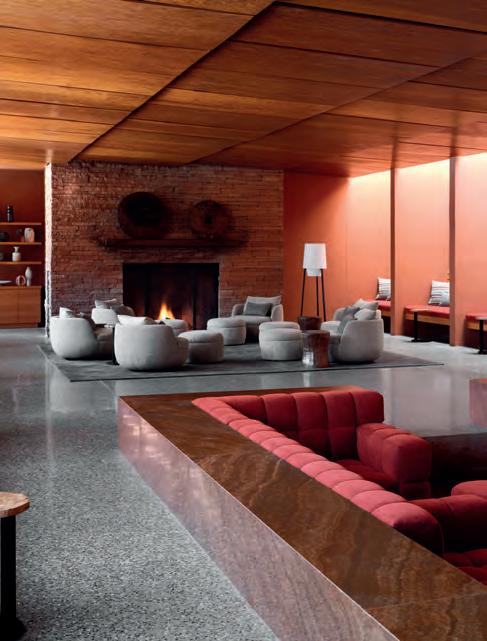
CONTENTS UP FRONT 15 THE BRIEFING The latest news from the world of luxury INTERVIEWS 36 DAVIDE BERTILACCIO The Villa d’Este CEO on how a four-decade career brought him to Lake Como 42 JOHN HIT CHCOX The creator of The Lakes by Yoo prepares to lift the curtain on his most ambitious project to date 48 PAOLA PARONETTO The Italian ceramist and designer takes us inside her collaboration with Veuve Clicquot 54 LA URENT GARDINIER The Relais & Châteaux President is on a mission to connect people with places FEATURES 62 ONE LAST BLAST As Jaguar prepares to go all-electric, its new F-Type 75 represents the end of an era 68 INSIDE A UGUSTA Behind the rope at the Masters, the biggest tournament in golf 74 PIGMENT S OF YOUR IMAGINATION A new wine club invites you to blend some of the world’s most cherished grapes into a barrel of your own 16 48 54
STYLE
80 UPT OWN TRUNK
How, 50 years ago, Vilebrequin revolutionised what men wear to the beach

86 HIS STYLE
Swim shorts, safari-inspired shirts, statement sunglasses and watches for travelling the world
90 CRUISE C OLLECTION
As the mercury rises, what to wear on holiday this season

105 HER S TYLE
Summer-inspired jewellery, bags, hats and shoes to rule the resort
ESCAPE
118 SLOWLY DOES IT
Six Senses’ latest Himalayan hotel invites you to clock off and zone out

126 NEW WAVE
Bali was once a sleepy, slow-moving paradise, but COMO Uma Canggu changed all that
134 A TALE OF TWO RESORTS
A collection of new villas at the Barut Hotel in Turkey is redefining the all-inclusive break
140 PEA CE OUT
In Tenerife, a one-bedroom hotel is aiming to restore your body and renew your mind

146 BEHIND THE SCENES
For this issue’s fashion shoot, Luxury London jumps on board Regent Seven Seas Splendor®
MAGAZINE THE Travel ISSUE THE HIMALAYAS, THE SWISS ALPS, FEATURING COVER This issue’s paper wrap and cover image is the work of award-winning Vietnamese photographer Khanh Phan, p.28 62
FROM THE EDITOR
SUMMER 2023

Issue 32
The plan had been to head up there in the afternoon. It looked like as good a place as any. A medieval turret on a sunny hill overlooking a lake. What more could you ask for? But, come afternoon, she’d changed her mind. Why would she want to trek up a mountain (it was a hill) when she could continue working her way through the cocktail list by the pool? ‘We’ve only got two days left. Chill.’ Didn’t I know it. The thing had been burning a hole in my pocket for the past 10 days. Change of plan. Think.
Danilo Zucchetti. He’d be able to help. We’d had drinks with Villa D’Este’s Managing Director a couple of nights previously. I found him at reception. Explained the situation. ‘Don’t panic,’ he said. ‘We have a boat.’ Great guy, Danilo Zucchetti.
I ended up popping the question on a wooden runabout just around the corner from George Clooney’s gaff. Sickeningly clichéd. We were wearing life jackets. It was choppy. The photo, the one you post, was awful (we faked another). Still, makes for a story. Everyone that visits Villa D’Este has a story about Villa D’Este. Even George Clooney has a story about Villa D’Este (he and Amal took Barack and Michelle there).
Turns out I got lucky. Villa D’Este never used to have many boats. On becoming CEO of the Lake Como hotel last year – a hotel voted best in the world by readers of Forbes and The Telegraph – it was one the first things Davide Bertilaccio prioritised. “I thought they’d be a fleet of Rivas, 10 or 20, but when I got there were none!” Since taking the reins, Bertilaccio has had regular guests chasing him around the gardens demanding he unveil his masterplan, so petrified are they that the former Rosewood Vice President has something drastic planned for their beloved bolthole on the lake. They needn’t worry (p.36).
Who else do we have in this travel-themed summer issue? Laurent Gardinier, President of Relais & Châteaux, on connecting people with places; Paola Paronetto, the Italian ceramist and designer, on collaborating with Veuve Clicquot; and John Hitchcox, mastermind behind The Lakes by Yoo, on his grand ambitions for Olympia London.


Plus: Six Sense’s new Himalayan hotel (p.118); behind the scenes at the Masters in Augusta (p.68); a road trip around the French Riviera in Jaguar’s last ever F-Type (p.62); and some style pointers, if we may, for the summer ahead (p.79).
Happy holidays.
EDITORIAL DIRECTOR
Richard Brown
DIGITAL
EDITORIAL DIRECTOR
Zoe Gunn
SENIOR EDITOR
Anna Solomon
ASSISTANT
DIGITAL EDITOR
Annie Lewis
EDITOR-AT-LARGE
Annabel Harrison
CONTRIBUTING EDITORS

Rob Crossan
Rory FH Smith
HEAD OF DESIGN
Laddawan Juhong
DESIGNER & PRODUCTION
Georgia Evans
MARKETING MANAGER
Tom Henry ASSOCIATE DIRECTOR
Fiona Smith
MANAGING DIRECTOR
Rachel Gilfillan
BUSINESS
DEVELOPMENT DIRECTOR
Miles Dunbar
BUSINESS
DEVELOPMENT MANAGER
Asleen Mauthoor
CLIENT
RELATIONSHIP MANAGER
Alice Ford
CHAIRMAN
Eren Ellwood
BY
BROWN Editorial Director
LUXURYLONDON.CO.UK 6 SALEM ROAD, LONDON, W2 4BU T: 020 7537 6565 WWW.LUXURYLONDONMEDIA.CO.UK
RICHARD
PUBLISHED




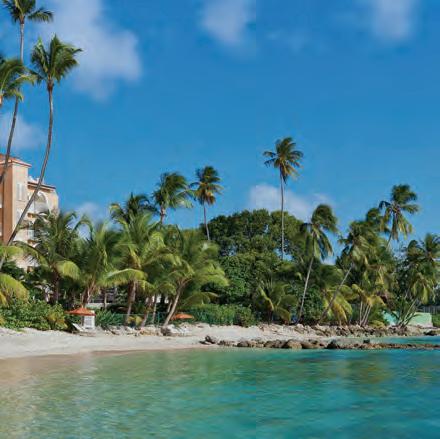
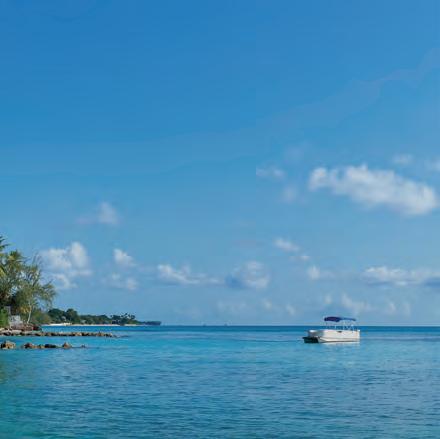


Paradise,Within Reach Disco v er the ceru l ean w av esandwhi te san d beaches ofBarb a do s’Pl atinu m Coas t at Saint Pe ter’s Bay, the p remiergene r ational de s tina t ionfor resortli v ing inthe Caribbean A nons top flight f romL ondon, Sa int Pe t er’s B ay affo rds unobstruc t ed oceanf ront view s, enviable amenitiespac kag e, andtu rnkey furnishin gs. Three-bed room, th ree-bath roo mv il la s f rom£1.35 M SPBLiving.com | +1 246.836.116 6 S AI NTPETER’ S BAY L UXU RY RESO RT & RES I DE NC ES B AR BADOS This does not constitute an offer to sell or a solicitation to buy a unit. Nor is it an offering of solicitation of sale in any jurisdiction where development is not registered in accordance with applicable law or where sug offering or solicitation would otherwise be prohibited by law. Obtain all disclosure documents required by applicable laws and read them before signing anything. No governmental agency has judged the merits or value, if any, of the development.

NEW BOND STREET SLOANE STREET WESTBOURNE GROVE HARRODS SELFRIDGES HEATHROW TERMINALS 4&5 SMYTHSON.COM
A LIFE ON THE MOVE

16 The Resort The cliff-top hotel raising the bar in Switzerland 20 The Restaurant Just what does it take to earn three Michelin stars? 24 The Clinic The Spanish facility proving the benefits of fasting 28 The Photographer The Vietnamese artist finding beauty in the mundane 30 The Book Stadium hopping around the world’s most spectacular football pitches THE LATEST NEWS FROM THE WORLD OF LUXURY
The Briefing
How
the Bürgenstock Resort became Switzerland’s ‘project of the century’, p.16
01
THE HOTEL
Bürgenstock Resort, Switzerland
PERCHED ON A CLIFF ABOVE LAKE LUCERNE, ‘BÜRGENSTOCK’ HAS BECOME THE LOFTIEST NAME IN ALPINE HOSPITALITY
Words: Richard Brown
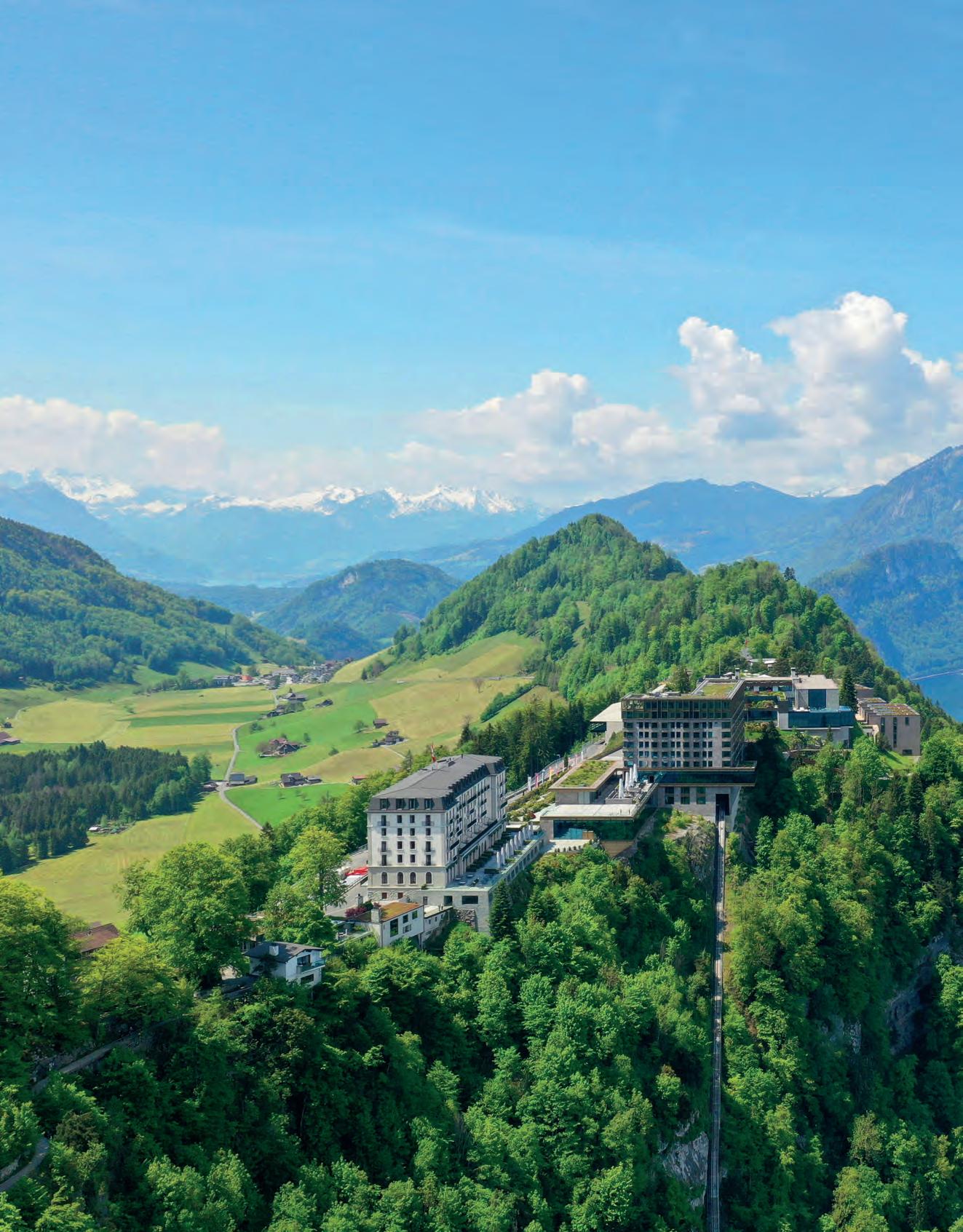


THE BÜRGENSTOCK RESORT’S HOLLYWOOD POOL
Just like every East End boozer has a photograph of The Queen Mother behind the bar, so every great European hotel claims that Audrey Hepburn once stayed there. And, just like you wonder how The Queen Mother found the time to pull a pint in every pub within the sound of Bow Bells, you question how Hepburn managed to holiday at every grande dame from the Baltic coast to the Côte d’Azur. Did she not have a home to go to? Well, for more than a decade, Switzerland’s Bürgenstock Resort was Hepburn’s home.
After marrying her first husband, actor-director Mel Ferrer, at a chapel on the estate in 1954, the glitzy mountain resort became Hepburn’s main residence. Each day, according to legend, Hepburn would drive to a local dentist – although no one seems to know what ailment would require daily visits to an orthodontist. The next highest ranking card a hotel can draw in a game of Iconic Guest Top Trumps is Sophia Loren. Extraordinarily, that other leading lady of cinema’s golden age also lived at the Bürgenstock Resort, moving into a wooden villa near where Hepburn got married with her own producer-husband, Carlo Ponti, and stayed there for seven years. Beat that Tremezzo, Gritti, de Crillon, Le Meurice, et al.
We don’t know if Hepburn and Loren ever fought over sun loungers around the hotel’s lake-facing outdoor pool (given that it’s now known as the ‘Hollywood Pool’, and today looks like the setting of a Slim Aarons photo, we might assume they were regulars). Nor do we know if the actresses ever engaged in a Génépi-fuelled dance-off at the resort’s wood-panelled Spycher nightclub (once a granary, now a private event space). It’d be nice to think that Hepburn was good enough to share some tips on tooth care, but we don’t know that either. What we do know is that neither Hepburn or Loren took a selfie in the spa’s wraparound infinity pool. Smartphones didn’t exist then. Neither did the spa.
Today, you can take as many pictures of yourself floating in the sky as you like, but only between 5pm and 6pm. Such is the Bürgenstock’s staggering situation, straddling a ridge, crocodilelike, 500 metres above Lake Lucerne, that you could, and would, spend the entire day capturing yourself morphing into a human prune. To avoid selfie-sticks at dusk, the resort has had to enforce a phone curfew. And enforce it they will. I was the recipient of a rollicking at five minutes past six. No one told me Yer ’onour, honest!
If it doesn’t feel like you’re staying in a resort that dates back to 1873, that’s because most of it
doesn’t. After its sixties heyday, shiny Bürgenstock started to lose its lustre, eventually filing for bankruptcy in the nineties. Swiss investment banks tend not to touch hospitality ventures. Too much risk. Surprising, then, that UBS made a successful bid for the resort in 1996. Less surprising, perhaps, that a decade later, having discovered just how much it would cost to modernise the 148acre estate, that the bank offloaded the site to the Qataris (far less risk adverse, the Qataris). Yet even the owners of Canary Wharf Group and Heathrow Airport nearly cut their losses halfway through a regeneration project that became known in Switzerland as the ‘project of the century.’
Connecting the three-storey spa, one of the largest in the world, to the 10-storey Bürgenstock, the swankiest of the resort’s four hotels, is a glass walkway straight out of Tony Stark’s house. It’s part of a redevelopment that eventually took nine years, 148 building permits and £440 million to get over the line. It opened in August 2017 to include a nine-hole golf course, tennis courts, five pools, 70km of walking and biking trails, and one of Europe’s largest, and most exclusive, luxury medical facilities. Today, psychosomatic therapy, which focuses on mental health, is one of the most popular treatments.
Head sommelier Matteo Rimoldi takes care of a 114-page wine list. He says that for some guests the wine is more of a draw than the spa. Rimoldi stocks 87 types of champagne and 108 different Bordeauxs, including a ’82 Mouton Rothschild (£2,800) and a ’89 Pétrus (£10,075). He doesn’t need to bother with prosecco, he tells us, and keeps his scarce Swiss wines for his favourite guests. Mike Wehrle, the Bürgenstock’s high-spirited Corporate Culinary Director, heads up seven restaurants and a team of 95 chefs. Watching them pirouette around the enormous open kitchen of the hotel’s principal restaurantin-the-sky, Spices, is Swan Lake with black aprons.
Some guests come for the spa, others for the wine. I’d go back for the bath. When outfitting each room, the clever people at London-based MKV Design noticed that the views up here are pretty top. So they had the good sense to stick a tub right next to the bathroom window. To the side of ours was a double-sided glass fireplace, meaning you could look across to flames licking at a stone surround and down to dinky little boats drawing lines on the lake.
You wake in the clouds and lather up in the stars.
Bürgenstock Hotel & Alpine Spa, from approx. £1,200 per night, burgenstockresort.com
19 LUXURY LONDON THE BRIEFING LUXURYLONDON.CO.UK
Today, you can take as many pictures of yourself floating in the sky as you like, but only between 5pm and 6pm
02
THE RESTAURANT
Alain Ducasse at The Dorchester

DUCASSE’S REVERED LONDON RESTAURANT IS ONE OF ONLY FIVE IN THE CAPITAL TO HOLD THREE MICHELIN STARS. SO, JUST HOW GOOD IS IT?
Words: Rob Crossan
What’s the difference between the Michelin star system and the English Premier League? Well, one is a snobbish, ego-driven, moneyfixated bear pit of prejudice, ad hominem insults and craven corporate greed that’s seen as being entirely out of reach of the pockets of ordinary people. The other is a football association.
There are currently five restaurants in London that are in possession of the culinary equivalent of the domestic treble. With three Michelin stars to their name, CORE by Clare Smyth, Hélène Darroze at The Connaught, Sketch, Restaurant Gordon Ramsay, and Alain Ducasse at The Dorchester can all lay claim to being in possession of the Premier League title, the FA Cup and the League Cup.
Ducasse is, probably, the only chef in the world right now who doesn’t worry too much about losing a star in the annual visits made by the mysterious Michelin inspectors who, if their occasional anonymous confessions are to be believed, are paid miniscule sums of money in return for spending the entire year making endless expeditions to restaurants where they dine solo in a cloud of pathos while desperately attempting not to fall foul of a bout of gout.
These are the lonely but well-fed football agents of the dining world who rip stars from some chefs while anointing Ducasse with even more. Currently, the 66-year-old can boast of 21 stars, sprinkled like saffron across his restaurants in locations that read like a list of urgent getaway destinations for government ministers of corrupt central African dictatorships; Mauritius, Monaco, Qatar… You get the gist.
So, then, what’s the difference between a simply
excellent meal and one that has three Michelin stars attached to it? After dining at Ducasse’s London outpost, located inside Park Lane’s The Dorchester hotel for the previous 15 years, I have to admit that I’m now all but certain that it has little to do with the food served or, it turns out, the name above the door.
Jean-Philippe Blondet, the current executive chef at Ducasse’s London restaurant, and a man that I can attest has a handshake that could crush diamonds, admitted in a recent interview that he was two years into working for the Ducasse empire before he finally met his boss.
That says everything you need to know about celebrity chefs and your chances of having your own dinner cooked by them. To his immense credit, I dined at Le Gavroche many years ago on a Monday lunchtime and the late Albert Roux was there putting in a shift, before coming out to sign the menu for my mum. But that was an exception. Mainly, Ducasse’s relationship with his restaurants is akin to the relationship between Liverpool FC chairman, Tom Werner, and the current first team; he may fly in, occasionally, but he’s not picking the ingredients, let alone donning an apron.
Regardless of his absentee chieftain, what Blondet is doing here with his seven-course tasting menu is a decorous, shimmering thing of beauty. The handdived scallop (as opposed to foot- or groin-dived?) served with Kristal caviar and citrus beurre blanc was a slinky, provocative thing, shedding itself of its lingerie in my mouth in a breathy striptease.
The lobster medallion with Périgord truffle and semolina pasta has been on the menu since day one and should remain there until either Doomsday or the return of Liz Truss as PM. The fugitive aroma


JEAN-PHILIPPE BLONDET, EXECUTIVE CHEF AT ALAIN DUCASSE AT THE DORCHESTER
of the truffles blends like a crimson sunset on a Scottish loch. The Cornish turbot with Swiss chard, girolles, blackcurrant and hazelnut was a dish of fearless eroticism; a centrefold model that was both naturist and naturalist in its hold on me; like foraging in a mermaid’s décolletage.
We must, of course, talk about the cost. With matching wines – including a glass of the greatest, toastiest, sighing-ly pulchritudinous champagne I have ever tasted in my entire life, a 2004 Dom Pérignon P2 – the tasting menu comes in at £710. That’s per person. Before service charge (admittedly, forgoing wine pairings brings things down to £285). Obscene in a time of food banks and potential power blackouts, for sure. The meal took four hours. Which works out roughly £3 a minute.
And yet. To experience one of the greatest dining experiences on the planet is not beyond us in the same way that the world’s fastest cars, most luxurious superyachts or steepest first-class airline tickets are. You’d have to save for a lot longer for an Italian-made handbag, for example, or a Swiss-made watch. If you’re prepared to live for a period of time on pesto, pasta and porridge, you might, might, just be able to justify the maths.
What’s the difference between an excellent meal and a three-Michelin star meal? What makes Blondet’s restaurant just that bit more memorable than, say, one-star Locanda Locatelli or two-star Le Gavroche, to name two laudable examples, arguably comes down to service.
Of course, at these prices you’d expect the staff to understand the nuances between being servile and being haughty. But the service at The Dorchester is something else entirely; a restaurant where you genuinely feel so close to the sommelier and waiters by the end of the meal that, not only do you want to invite them to the pub down the road, you also feel that they’re on the cusp of asking you back to the kitchen to graze over the leftover Comté with some crackers and Taylor’s port.
They’re not, of course. But their confident, unforced charm made me as sorry to leave the place as anything I was served on a plate that evening. Yes, you’re sacrificing a handbag or a weekend away for a fortnight of Netflix’s and penne. But I’m prepared to argue that it’s a deal worth making.
Tasting menu without wine pairings, £285, Park Lane, W1K, alainducasse-dorchester.com

23 LUXURYLONDON.CO.UK
The Cornish turbot with Swiss chard, girolles, blackcurrant and hazelnut was a dish of fearless eroticism
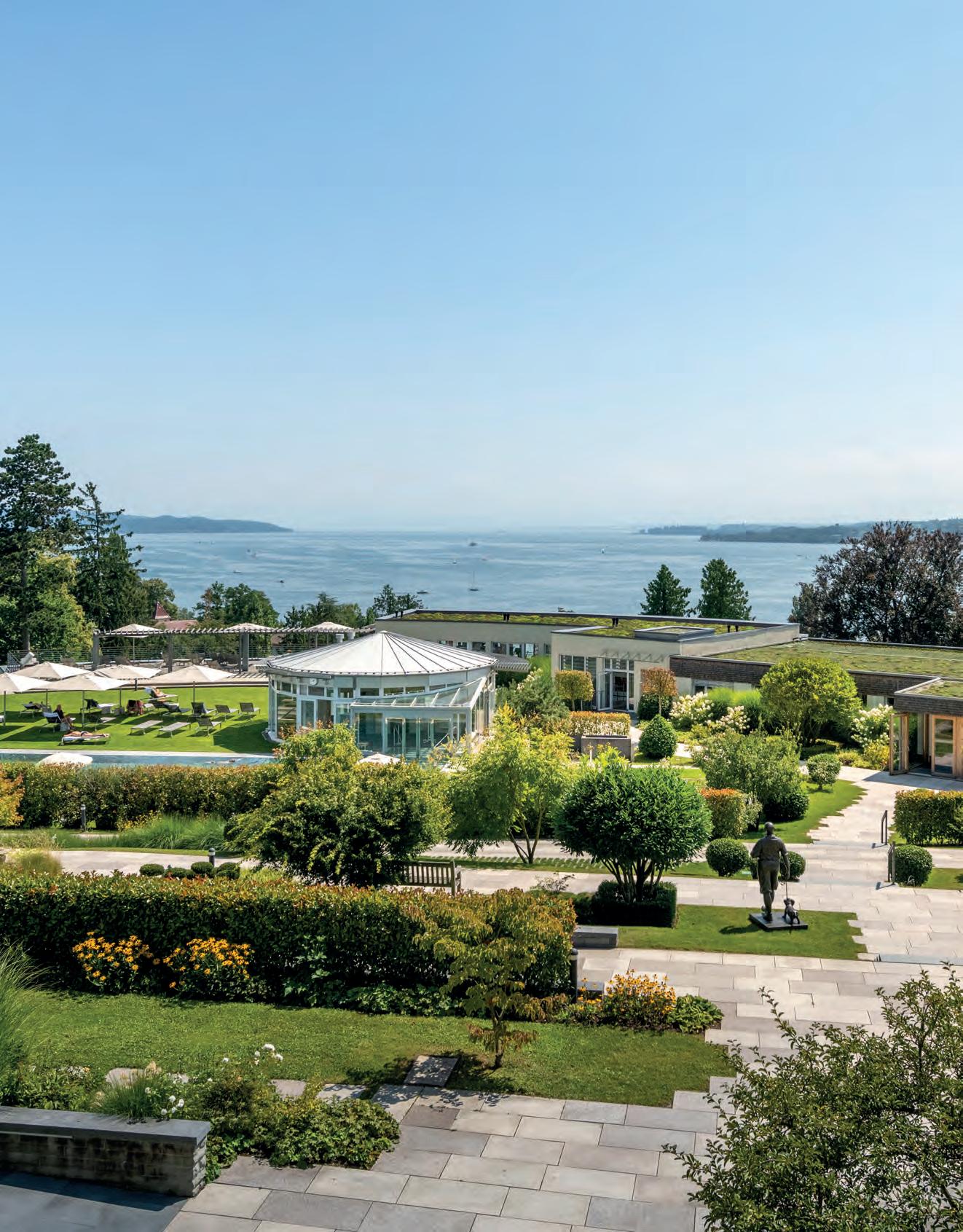
AN AERIAL VIEW OF BUCHINGER WILHELMI LAKE CONSTANCE
03
THE CLINIC
Buchinger Wilhelmi Marbella
INSIDE THE CELEBRATED, SPACE-AGE FACILITY THAT’S BEEN COMMITTED TO PROVING THE HUMAN BENEFITS OF LONG-TERM FASTING FOR 70 YEARS
Words: Penny Mountbatten
It is an auspicious year for Buchinger Wilhelmi’s two wellness clinics. The group’s German facility is celebrating its 70th anniversary, while its Spanish outpost will turn 50 in September. Buchinger Wilhelmi is the world’s largest privatelyowned clinic dedicated to the science of therapeutic fasting. Around 6,000 guests, from more than 60 countries, check in each year.
Founded by Dr Otto Buchinger, a medical doctor, philosopher and pioneer of medical fasting, the clinics are now run by Leonard and Victor Wilhelmi, Buchinger’s great grandsons. Leo, aged 35, runs the German clinic; Victor, 37, manages the Marbella base. Their mother, Dr. Françoise Wilhelmi de Toledo, is in charge of the scientific elements of both clinics.
“In a world that is spinning faster and faster to the point of derailing, we want to be a safe haven for those who wish to regenerate and get in touch with themselves,” says Leonard.
The clinic’s extensive teams comprise doctors and therapists, who span an array of specialisms from fasting to medicine to nutrition to diabetology, and an array of massage therapists, counsellors, nutritionists and personal trainers.
Last year, I visited Buchinger Wilhelmi’s German facility, which overlooks Lake Constance in Überlingen. I booked to follow its 12-day fasting programme and was so impressed by the

results that I arranged to visit the sister clinic in Marbella for 10 days earlier this year. Having fasted on my previous visit, I was keen to try Buchinger Wilhelmi’s calorie-controlled, high-nutrition diet. My personal Buchinger doctor suggested I try a diet of 1,200 calories a day. At this level, I would enjoy the benefit of weight loss while enjoying three delicious meals a day, most of which are made from ingredients supplied from within a 30km radius. I ended up having some of the best food I have ever eaten, anywhere.
Buchinger Wilhelmi Marbella, founded in 1973, is nestled between the Sierra Blanca mountains and the Mediterranean Sea. After gliding up the white marble steps, you enter a space that has the serenity of a monastery, the luxury of a five-star hotel and the efficiency of a top-grade medical facility. There is a hushed, almost meditative, atmosphere.
The main building is a classic Spanish-style hacienda, flowers tumbling from balconies above terracotta arches. There are three buildings that house the bedrooms and therapy rooms. My bedroom suite is more luxury hotel than medical clinic, with exceptional views from a private balcony towards Marbella and the sea. The only clue that you are in fact in a clinic are the bedside emergency bells to call the nurse and the four types of brightlycoloured bottled therapeutic water. Unsurprisingly, there is no minibar.
25 LUXURY LONDON THE BRIEFING LUXURYLONDON.CO.UK

PARKVILLA AT BUCHINGER WILHELMI LAKE CONSTANCE
While this is definitely not a boot camp, there are a few rules. No smoking. No mobile phones in public areas. No children, no animals, no loud music. You don’t have to sign up for activities, but, if you are in the mood, you can choose between yoga, Pilates, Qi Gong, gymnastics, water aerobics, tennis, art therapy, cooking classes and regular informative talks on all subjects relating to health. Every evening, there is some kind of entertainment. There are also daily excursions to the beach and Marbella Old Town.
Before starting any therapies or diets, each guest has a blood test, which is analysed, and then a consultation with a designated personal doctor and, together, you devise a plan. My doctor advised hydrotherapy massage for low blood pressure and, to help combat my extensive list of allergies, colonic irrigation and acupuncture. To assist with poor circulation and water retention, I was booked on a course of lymph drainage massages.
Food-wise, you can choose between a low-calorie seasonal and organic diet, intermittent fasting, or full fasting (depending on the length of your stay). Fasting is a three-dimensional experience; physical, spiritual and inspirational. Every religion uses fasting to prepare for an event, during which they typically assemble their communities for a spiritual practice. Buchinger Wilhelmi doesn’t have a religious colouring but it does use the metabolic state to enhance life. During fasting, sensitivity to and appreciation of nature, books, music and smell is enhanced and more accessible.
With 70 years of clinical experience and 20 years of medical data points from which to draw, Buchinger Wilhelmi has published hundreds of studies that look at the science of fasting. Indeed, the Wilhelmi family has invited professors from Ivy League universities to visit their clinics and, in collaboration with the institutions, has produced numerous papers and scientific journals.
Fasting, says Buchinger Wilhelmi, is proven to stimulate autophagy and detox enzymes, resulting in a deep cleansing of cells and tissue.
At the same time, fasting reduces cholesterol and inflammatory processes, alleviates pain and improves mobility. Fasting can promote weight loss, reducing the risk of Type 2 diabetes by improving insulin sensitivity. Buchinger Wilhelmi also believes that fasting can improve brain function, protect against age-related cognitive decline, and even extend human lifespan – as has already been proven in animal studies.
“Fasting is the most powerful nonpharmacological and non-invasive intervention in the medical world,” says Dr Wilhelmi de Toledo, who believes that fasting can also ‘de-block’ certain traumas that we often plaster over with alcohol, nicotine, food and other drugs.
In 2023, Buchinger Wilhelmi Marbella witnessed the length of average stays increase from around 10 days to more than 14 days, although there are some guests that book in for over 40 days. A high percentage of guests return annually, some twice a year, and many come on their own, it being the perfect place to unwind in insolation, keeping yourself to yourself. One therapist told me that she is now working with the grandchildren of one of her first clients.
This is a family-run business that really does foster a sense of community. The staff, some of whom have been working here for 30 or 40 years, all confess to a deep attachment for the place. You can see affection in the positive atmosphere that pervades the clinic. It shows in the quality of the food and it spills over into the therapy rooms.
As I checked in, full of the stresses of everyday life, I witnessed outgoing guests hugging staff. When it was time for me to leave, clear-headed and much better equipped to deal with those stresses, I ended up hugging everyone I had met.
Now, when was the last time you did that on checking out of a hotel?
10-day fasting programmes from £8,340 per person; non-fasting stays are available from £218 per night, buchinger-wilhelmi.com
27 LUXURY LONDON THE BRIEFING LUXURYLONDON.CO.UK
“Fasting is the most powerful non-pharmacological and non-invasive intervention in the medical world”
04
THE PHOTOGRAPHER
Khanh Phan
THE VIETNAMESE ARTIST MAKES THE MUNDANE SUBLIME, DESPITE THE
ODDS STACKED AGAINST HER
Words: Anna Solomon
In the UK, being a photographer isn’t considered particularly controversial. You buy a camera, take a few snaps and voila! You’re a photographer. In Vietnam, it’s a bit different – especially if you’re a woman. If you want to capture the night sky, you have the danger of going out after dark to contend with. Equipment is expensive, out of reach for most. Plus, despite leaps and bounds in recent years, Vietnam is still a patriarchal society; women, who must work as well as fulfil traditional domestic roles, rarely get to do the things they love.
This was the case, at least, for Khanh Phan. She was rapidly falling out of love with life as a bank cashier and, after the breakdown of her marriage, decided to change course. While there was much working against her, Phan realised that she had something others don’t: the stunning natural and cultural scenery of her homeland.
And, boy, does she use it to her advantage. Phan’s images depict traditional professions of rural Vietnam – one shows women drying incense sticks, which are used in prayer (right); in another, they mend fishing nets (below). Phan platforms the workers who harvest grass and wash water lilies, all from an intriguing bird’s eye perspective. The colours are exceptionally vivid, the spirit of Vietnam positively oozing from each image. The shapes flow and merge until the scene becomes abstract, surreal. The photographer has not married again, she says, because she pursued photography. Instead, she has waited for sunrises in the churches of Thanh Xa and wrestled with waves at Hang Rai. Phan’s eye is remarkable, yes, but in order to do what she has done, something else is required: tenacity.
khanh-phan.pixels.com


05
THE BOOK
Remarkable Football Grounds
A NEW VOLUME GIVES
‘THE BEAUTIFUL GAME’ NEW MEANING
Words: Anna Solomon
Only in the wildest dreams of Eriskay FC, the football team of the Outer Hebrides island of Eriskay, was it acknowledged by FIFA. With a population of less than 150, it’s almost a case of ‘if you live on Eriskay, you play for Eriskay’. Nevertheless, the team has gained notoriety – not, to be fair, for winning trophies, but rather thanks to its ground, which has been named ‘one of the eight most remarkable places to play football in the world’ by the Fédération Internationale.
The pitch may not be flat, exactly, and suffers regular invasions from sheep, but the views from, and of, this remote spit of land are incredible. Eriskay’s idiosyncrasies have made it the subject of a new book: Remarkable Football Grounds by British journalist Ryan Herman. In it, he dives into the world of ‘groundhoppers’, a niche of people that like to visit far-flung stadiums – the more beautiful and bizarre the better.
Remarkable Football Grounds also documents the Alfheim Stadion in Norway, which lies in the shadow of Arctic mountains; the Amahoro in Rwanda, which became a refuge centre during the genocide of 1994; and the Avanhard in Ukraine, which was rendered radioactive for the next 3,000 years by the Chernobyl disaster. In Dundee, the Tannadice and Dens Park grounds are just 183 metres apart, and in Norway’s Lofoten Islands, where flat land is at a premium, the pitch sides are used for drying fish.
VØLLURIN Í HÓLMANUM, FAROE ISLANDS
EB/Streymur’s ground, located in the village of Eiði, can fit its hometown’s population of less than 700 twice over. International eyes turned on EB/Streymur in 2008 when Manchester City faced the side in a UEFA Cup qualifying round; due to pitch regulations, the match had to be played at Tórsvøllur, the Faroe Islands’ national stadium, where City won 2-0.


STADE LOUIS II, MONACO
It’s a wonder that the home of AS Monaco exists at all, given that the whole principality of Monaco is squeezed onto a tiny slither of land between the sea and cliffs. The football ground eats up three of the 33 hectares that make up Monaco’s Fontvieille district; fortunately, architect Henry Pottier came up with an ingenious solution to the space problem – Stade Louis II is merely the tip of an architectural iceberg that also includes underground sports halls, offices, four-storey car parks and an Olympic-sized swimming pool. It is also remarkable for its ability to blend with the surrounding architecture; from ground level, the stadium could simply be another of Monaco’s cubiform apartment blocks – not to mention the artful arches at one end yielding views towards the yacht-filled harbour.
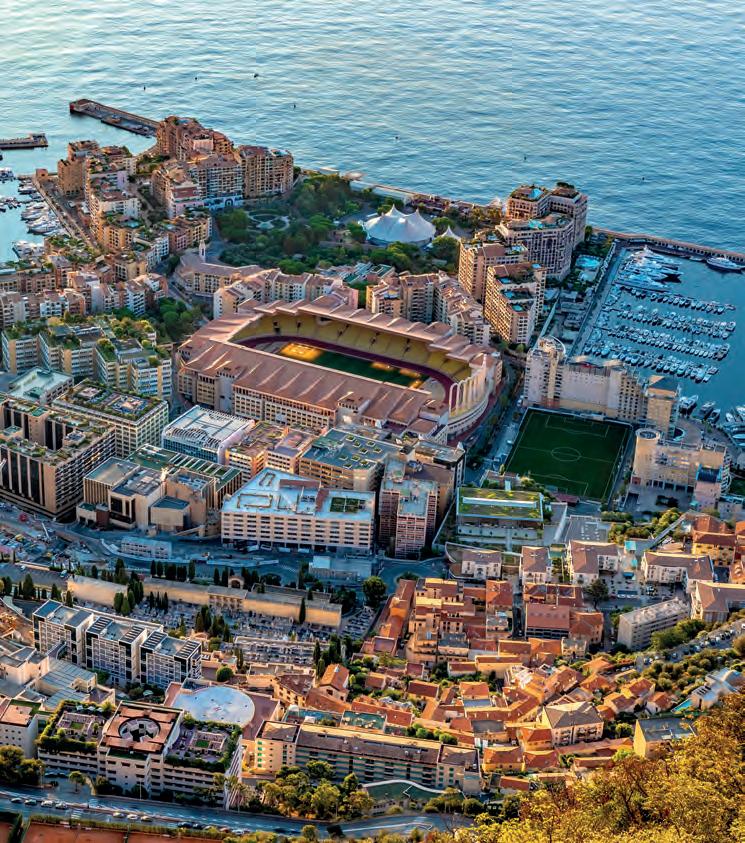
IGRALIŠTE BATARIJA, CROATIA
Croatia is famous for its jaw-dropping Game of Thrones filming locations. So inundated is the nation with beautiful, medieval structures, in fact, that apparently it barely has room for things like football stadiums. Igralište Batarija is the home ground of HNK Trogir, and is sandwiched between two UNESCO World Heritage Sites: the 15th century Kamerlengo Castle and St. Mark’s Fortress.

A Sanctuary of Work, Rest and Play
An iconic central London hotel, located adjacent to the famous Trafalgar Square offering unrivalled views. With museums, galleries, theatres and key attractions including Big Ben and Buckingham Palace on our doorstop.
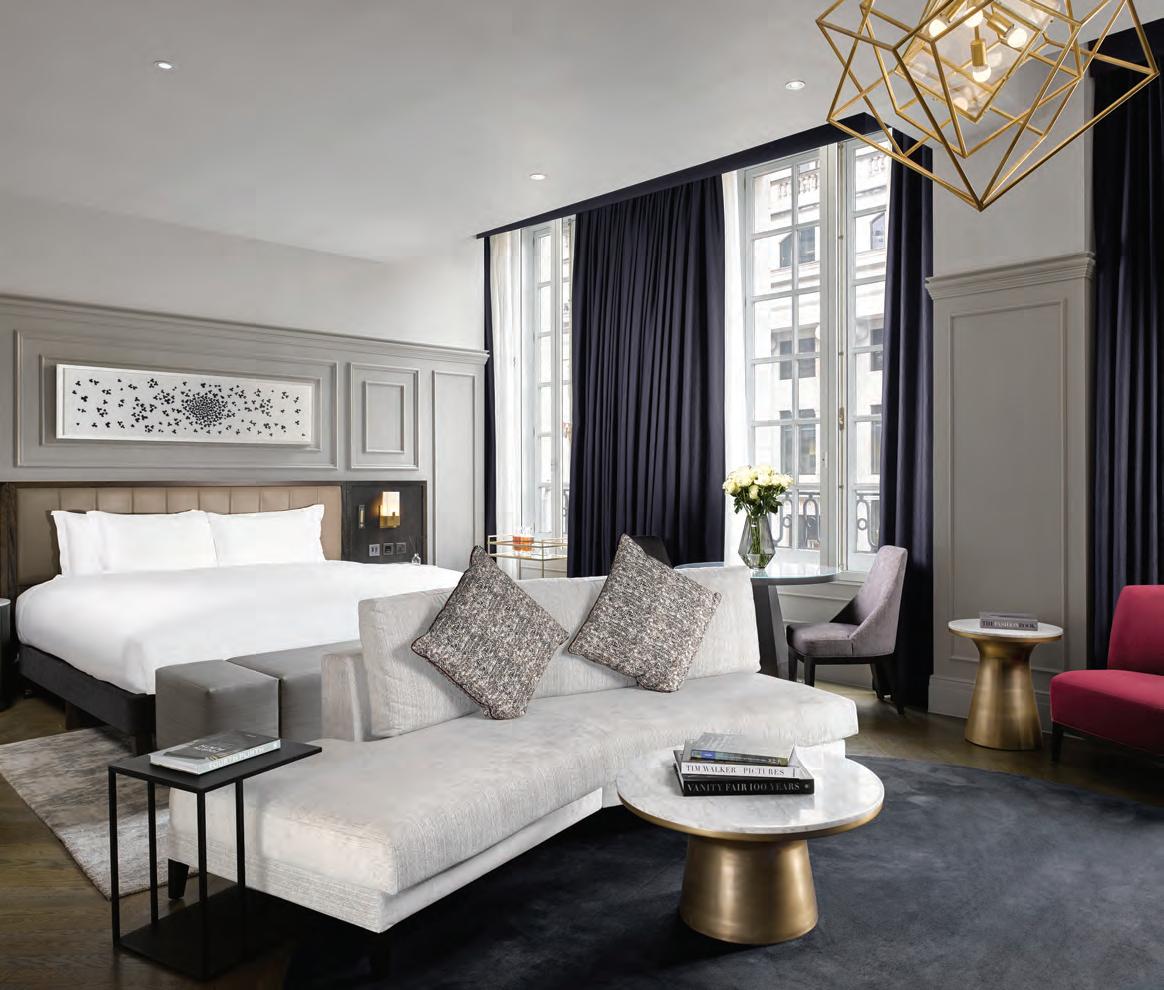
A perfect base for Londoners and travellers alike
trafalgarsw1

2 Spring Gardens, London SW1A 2TS | +44 (0)20 7870 2900 | info@trafalgarstjames.com | W. trafalgarstjames.com
PLAY EVERY DAY






















With 9 different styles - from sportive to smart - MR MARVIS has the perfect shorts with an ultimate fit for every occasion. Our shorts are responsibly made in Portugal using high-quality fabrics including stretch cotton, airy piqué and lightweight linen. Available in over 60 sophisticated colours; which one will you choose? Shop now at mrmarvis.co.uk












THE WORLD ACCORDING TO THE PEOPLE SHAPING IT Interviews 36 Davide Bertilaccio On the future of Villa D’Este 42 John Hitchcox The Lakes by Yoo founder prepares to launch his biggest project yet 48 Paola Paronetto The Italian artist teams up with Veuve Clicquot 54 Laurent Gardinier Is on a mission to make the world a better place
Having created The Lakes by Yoo, John Hitchcox, founder and chairman of Yoo Group, turns his attention to the regeneration of Olympia London, p.42

WITH A CAREER STRETCHING FOUR DECADES AND FIVE CONTINENTS, DAVIDE BERTILACCIO WAS CONTENT
SERVING AS VICE PRESIDENT OF ONE THE WORLD’S MOST PRESTIGIOUS HOSPITALITY GROUPS – BUT THEN
HE RECEIVED A CALL FROM A CERTAIN HOTEL ON LAKE COMO
DAVIDE BERTILACCIO
Words: Richard Brown CEO,
Villa d’Este Hotels
Shortly before our interview at the Mandarin Oriental in Knightsbridge, Davide Bertilaccio was going through the boxes in his loft in Italy. Among the crates, he found a statue of a Buddha from his time in Bali, knick-knacks from stints in North Africa, and a keepsake from Kenya. He also found a photo. It was of a 19-year-old him.
“It was taken just out there,” says the 56-year-old, taking the picture from his wallet and pointing to the lobby beyond the restaurant in which we’re sat. “I used to work here, back when it was called the Hyde Park Hotel. It was my very first job. I worked at the grill, carving meat, serving roast potatoes.”
Dishing up Sunday roasts as a teenager clearly didn’t deter Bertilaccio from a life in hospitality. For, after studying tourism at the Travel Institute in Udine, and then hotel administration at Cornell University in New York, Bertilaccio embarked on
what must surely rank as one of the most prolific careers in the luxury hotel industry.
From the United States to Europe to Asia to the Middle East to Africa and back to Europe again, Bertilaccio’s resume includes positions at some of the biggest names in hospitality, including the Fairmont group, Four Seasons, Rocco Forte, Armani Hotels and Starwood.
Before becoming CEO of Villa d’Este Hotels in April 2022 – a portfolio that includes the fivestar Villa d’Este, two four-star hotels in Como, and the recently refurbished Villa La Massa in Florence – Bertilaccio served as Regional Vice President of Rosewood Europe, helping oversee a refurbishment of Paris’ Hôtel de Crillon, notching up a string of awards at Tuscany’s Castiglion del Bosco, and earning Rosewood London a reputation as one of the capital’s most respected hotels.
We’re meeting at Mandarin Oriental, not Rosewood London where you recently served as Vice President. Any reason for that? [Laughs]. Well, once you close the door, you close the door, psychologically. There was also a bit of nostalgia about coming back here. I really wanted to walk in and see that staircase. It’s still the same! The marble, the elevator. When I was working here, many years ago, the Queen used to sneak in the back and come in for afternoon tea.
It’s a silly question, but what persuaded you to join the Villa d’Este group? At first, I didn’t want to go. I was happy at Rosewood. But there was this insistence. ‘Come, let’s just have a conversation.’ So I went and I met Dr Giuseppe Fontana [the owner of the Villa d’Este Group] and his daughter, and there was an instant click; he’s a gentleman, from another time, the sort you don’t find any more, extremely focused, something happened. He asked me a very simple question, and I was very blunt. ‘It’s a beautiful place, it’s a grande dame, but it needs to move into the 21st century. You can only rely on past glories up to a point. Let’s preserve it – but let’s do something new.’
Villa d’Este is routinely spoken about as being one of the best hotels in the world. Does that make your job more or less difficult? More! I came in with a task set by the shareholders – to keep the DNA, but to evolve with the times. The challenge is how to do that without upsetting people. I have regular guests chasing me around the hotel asking ‘Hey, you, what are you going to do here?!’
So, what’s the answer? Experiences. Creating experiences. I want you to check in and stay for four or five days. The average stay is currently three nights. There were some things that weren’t at Villa d’Este when I arrived that I expected there would be. I thought there’d be a fleet of Rivas, for example, 10 or 20, but when I got there there were none! This year, we’ve tried to assemble a fleet of classic Rivas. We have the first fully-electric Riva –the first one they ever produced was made for Villa d’Este. Everything is about the experience. This has been my focus of the last 12 months.
Hence opening last Christmas, for the very first time? Exactly. Crazy. We said we either go wild, or we remain humble. Well, with someone like me, you can only go wild. I risked my career because I asked for a massive investment. We turned Villa d’Este into a fairy-tale. We had millions of lights. We did a lighting ceremony with a children’s choir, a cocktail party, we covered the terrace by the lake with fireplaces. No one on the lake had ever done it. The challenge is what do we do this year?!
Get Father Christmas to drop by? Yes, I’m talking to him now, actually.
What other plans do you have in the pipeline? I recently received the green light to expand the group outside of Villa d’Este and Villa La Massa, in terms of finding other five-star properties. We would really like to create a Villa d’Este Collection. I’ve been looking at properties in Italy – although I wouldn’t mind acquiring Harrods! They would
“We said we either go wild, or we remain humble. Well, with someone like me, you can only go wild. I risked my career because I asked for a massive investment”


have to be historic buildings. They couldn’t be modern, contemporary hotels. I’ve been looking at places in Venice, Rome – places where Villa d’Este would fit in perfectly.
As well as Villa d’Este and Villa La Massa, the group operates the four-star Palace Hotel and Hotel Barchetta Excelsior in Como. What are the plans for those two properties? I’m currently in discussions with the shareholders, I’m not particularly keen on having four-star hotels and five-star hotels – I don’t see a proper identification of the brand. We used to own those properties, but they were sold years ago so we have a management contract which expires in 2027. I want to keep pushing them to do well. Numbers-wise, I don’t think they’ve ever done better. So we shall see.
You’ve been employed by hotels on four continents. Is it nice to be back in Italy, not far from where you grew up? Out of 35 or 36 years in this industry I have lived probably 23 or 24 years abroad. And in all sorts of places – Tunisia for six months after the Arab Spring, Morocco, other parts of north and west Africa. It’s been incredibly rewarding. I’m not the typical Italian, insomuch as wherever I go I have to have a plate of pasta. But I’m very happy to be back home in the north of Italy. The collection of cheeses here is the best, for one thing.
What’s the best city for a 48-hour break? They say you are either more London or more Paris. I’m much more Paris – sorry! Though I may prefer British people over the French.
What’s your favourite building? Favourite new building, the Burj Khalifa in Dubai, because I helped open it. Old building? Palazzo Corsini, Florence. Wow.
Which architect would you commission to design your own home? Sir Norman Foster, and I have in mind this amazing house he built in southwest
Corsica. It’s a concrete-and-glass rectangle he built on a cliff there for a billionaire in the 1980s. It has a beautiful garden overlooking the ocean. Even now, it still looks modern. I would do a copy-andpaste on that house.
Which interior designer would you commission to take care of the inside? I like very much Aline Asmar d’Amman, who I worked with at the Rosewood Hôtel de Crillon. She worked a lot with Karl Lagerfeld, before he died. De Crillon is a very historic building but she managed to ensure the suites are amazingly contemporary, but also very classical. Not too cold, very warm, very inviting. She’s also just a lovely lady.
Which car do you drive? I’ve been a happy Land Rover driver for more than 20 years. I don’t think I’d ever swap my Range Rover for another car. The Range Rover is a little like Villa d’Este – timeless, elegant, something that everyone tries to copy, but no one can quite achieve.
Judging by the Audemars Piguet ‘Jumbo’ Royal Oak on your wrist, you’ve got a thing for watches? Ha, yes, well, with my limited means. I bought this one 20 years ago. It wasn’t too expensive back then. Someone offered me €80,000 cash for it the other day – but I said ‘no’, I would prefer to leave it to my daughter.
If you could stay in any hotel this summer, outside of your group, which would you choose? There’s a new place called Therasia Resort Sea and Spa on an island off Sicily. It’s in a secluded area right on the water. They have these amazing rooms right over the sea with nothing around – it’s almost like being in the Maldives. I’ve only ever been to Sicily once, for a few hours, to collect my dog. So I’d love to go there.
Carrier offers seven nights at Villa d’Este from £5,200 per person based on two adults sharing an Executive Double garden view room. Price includes breakfast, flights and transfers, carrier.co.uk
41 LUXURY LONDON INTERVIEW LUXURYLONDON.CO.UK
“They say you are either more London or more Paris. I’m much more Paris – sorry!”
JOHN Hitchcox
Founder & Chairman, Yoo

AFTER IMPORTING THE CONCEPT OF LOFT LIVING FROM THE STATES IN THE NINETIES, JOHN HITCHCOX HAS SPENT THREE DECADES CHAMPIONING A DESIGN-FIRST ETHOS IN DEVELOPMENTS AROUND THE WORLD. AS HE CONTINUES TO EXPAND CELEBRITY HANGOUT THE LAKES BY YOO IN THE COTSWOLDS, HITCHCOX, WHO COUNTS SIR MICK JAGGER AND KATE MOSS AS CLOSE FRIENDS, IS NOW PREPARING TO RAISE THE CURTAIN ON HIS MOST AMBITIOUS PROJECT TO DATE
– THE £1.3 BILLION REGENERATION OF OLYMPIA LONDON
Words: Richard Brown

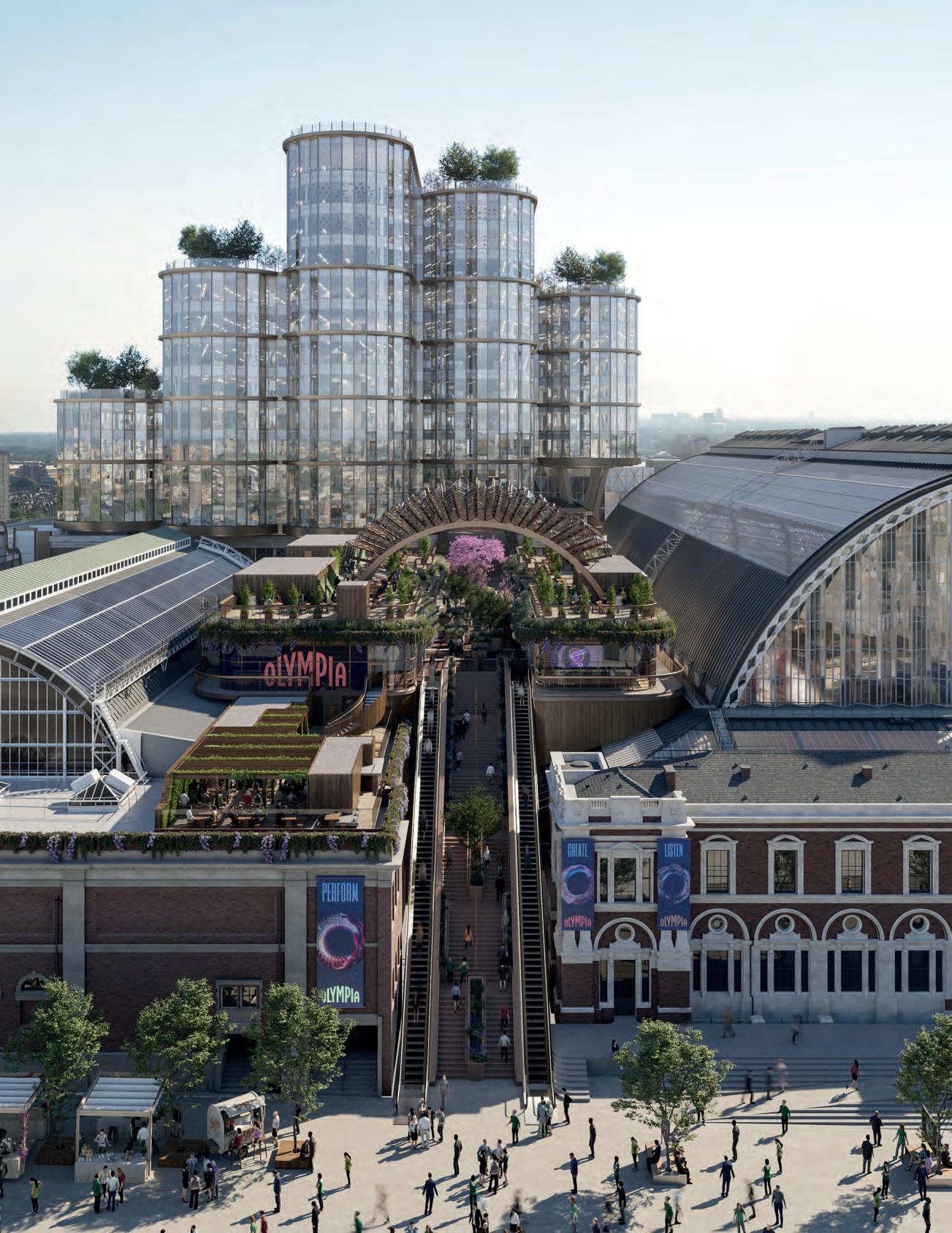
A RENDERING OF HOW THE REGENERATED OLYMPIA LONDON WILL LOOK ONCE WORK IS COMPLETED IN 2024
here’s a joke that John Hitchcox likes to crack whenever he opens a new development. ‘What’s the difference between a doctor and an architect?’ asks the multimillionaire founder and chairman of property investment group Yoo. ‘A doctor gets to bury his mistakes.’ Ba dum tss. Whether the joke lands to stifled sniggers or looks of bemusement will depend on where his latest development is located – since its inception in 1999, Yoo has worked on homes, hotels, branded residences, theatres, markets, restaurants, gardens, towers and schools in 29 countries across six continents – and how good a job the interpreter has done at translating the gag. Sometimes it falls flat. What Hitchcox is trying to say, and has been saying since the very beginning, is that Yoo isn’t your typical developer. Yoo cares about what it leaves behind.
“I call it ‘place making’,” says Hitchcox, who, on the day of our Zoom call, is preparing to open a restaurant at his best-known UK project, the celebrity-hangout in the Cotswolds that is The Lakes by Yoo. “We create spaces that bring like-minded people together in well-designed buildings,” he says.
Those buildings might be high-rise luxury studios, like the ones Hitchcox launched in India last year; they could be holiday villas, like the ones currently under construction in Vietnam; they might be lakeside apartments, like the one from which Hitchcox is talking to me today; or they could belong to billionaire-pound redevelopments of entire neighbourhoods, like the gargantuan regeneration of Olympia London, a site that Hitchcox acquired in 2017 for £296 million. What unites each project, says Hitchcox, is a conscious effort to think about how “the built environment can be used to improve people’s lives.”
“We started this trend of bringing in designers, and interior designers, to residential buildings about 30 years ago,” says the 61-year-old, whose primary residence is a five-bedroom Victorian townhouse in Notting Hill, complete with a swimming pool and recording studio (Hitchcox plays the guitar,
Tsaxophone and piano, and once considered a career as a musical conductor). “We helped introduce that trend to many parts of the world.”
Hitchcox’s foray into the property game was a clapped-out doer-upper in Caterham, Surrey. Having grown up in nearby Forest Row, East Sussex, where he attended the experiential learning Michael Hall Steiner Waldorf school, Hitchcox was 19 when he asked his mum for £45 to buy a suit to impress the bank manager. Having secured a 100 per cent loan against the £19,200 house, Hitchcox spent £13,000 turning the property into two flats, flipping them eight months later for £19,000 each. “Originally, I only had £7,000 for the renovation,” Hitchcox laughs. “I discovered the meaning of cost overruns and time overruns on my very first project!”
Flats became the foundation of Hitchcox’s success. In 1991, he teamed up with fellow property developer Harry Handelsman to co-create the Manhattan Loft Company, buying former factories in Clerkenwell and Southwark and converting them into New York-style loft apartments (it was the Manhattan Loft Company that would later overhaul the Chiltern Firehouse and St. Pancras Renaissance Hotel, although Hitchcox had by then left the company).
While Hitchcox was importing the concept of loft living from across the pond, over the Channel Philippe Starck was ascending through the ranks of the luxury design world. They met, at Hitchcox’s behest, in Starck’s office, a house on the Seine, and hit it off immediately. “Still, to this day, I can’t speak highly enough of the man,” says Hitchcox, who, incidentally, had just gotten off the phone to Starck when I logged onto our meeting.
The pair founded Yoo in 1998, starting off in branded residences and going on to create what today claims to be the world’s ‘largest residential design and development brand’. “I’ve been working with Philippe for the past 30 years,” says Hitchcox. “He is the most professional, focused, creative person I’ve met on this planet.”
Starck isn’t the only star-designer with whom Hitchcox has worked. For The Lakes by Yoo, a new-build estate of waterside cabins and cottages
45 LUXURY LONDON INTERVIEW LUXURYLONDON.CO.UK
“We started this trend of bringing in designers, and interior designers, to residential buildings about 30 years ago. We helped introduce that trend to many parts of the world”
that according to Hitchcox is now worth almost £1 billion, Hitchcox recruited the talents of designer doyens Jade Jagger, Kelly Hoppen and Anouska Hempel. Kate Moss, a close friend, was also invited to design a cabin.
“The concept of The Lakes was a little bit mad to begin with,” says Hitchcox. “We had bought an old barn in East Grinstead because I really wanted the kids to get a bit of country. Every Friday, we’d get in the car and I’d spend two hours driving through the traffic with the kids in the back and it would take forever to get there.” When they did eventually arrive, Hitchcox discovered that the rural idyll wasn’t so idyllic when you don’t know anyone there. “So I had this idea of moving to the countryside en masse with a group of likeminded mates.”
Hitchcox, who was originally looking at a plot in Ashdown Forest, near Pooh Corner, had all but given up on his dream when he received a call about the site of a disused quarry near Lechlade, Gloucestershire. “Most of my mates thought I was mad buying a bunch of fields. They said, ‘who’s going to go down there?’ We’ve ended up building 11 lakes across nearly 1,00 acres, planting half a million trees, building 170 houses and have created a real sense of community.”
That crowd, says Hitchcox, is largely WestLondon based, cash-rich, time-poor, and includes Kate Moss (godmother to one of Hitchcox’s four biological children), Simon Le Bon (best man at Hitchcox’s third wedding, to former communications director Phoebe Vela), Jade Jagger and Take That’s Mark Owen.
“The concept was a little bit hippy-ish,” says Hitchcox, “a nod to my Steiner upbringing, I guess. But now we’ve got a 400-member sailing club here, we’re building a little hotel, a restaurant, and some more apartments and cabins.” Prices for the four- to six-bedroom homes that litter the estate, which can also be rented, sell from between £2m and £7m. “It’s been a fantastic journey. I’ve really, really enjoyed it.”
All going well, next year Hitchcox will cut the ribbon on Yoo’s biggest development to date, indeed one the biggest construction projects currently underway in Europe – the revamped, repurposed Olympia London.
“I’ve probably been in training for this for the past 40 years,” says Hitchcox. “When we acquired
the site the thesis was ‘don’t change it much from its original concept’. The venue wasn’t very well served by hotels, so let’s put a couple of hotels in there, let’s put a new music venue in there, let’s build a performing arts school, let’s really celebrate everything that Olympia is about.”
True to that ambition, Hitchcox has so far signedup 02 Arena-operator AEG, which has agreed to manage a 4,400-capacity live music venue, and hospitality giants CitizenM and Hyatt, both of which will be opening hotels on the 14-acre site.
“I feel incredibly blessed with this project,” says Hitchcox, whose Yoo group is working with Deutsche Finance International to finance the £1.3bn scheme. “We are in the best city in the world, right at the end of Kensington High Street. We have inherited these fantastic Victorian buildings. If you levelled it today, you’d never get a convention centre built there, the finances just wouldn’t make sense.”
Thomas Heatherwick, the design luminary behind Coal Drops Yard in King’s Cross, was enlisted to provide the masterplan, which will also see the creation of 550,000 sq ft of office space, 100,000 sq ft of restaurants and bars, and a 1,575-capacity performing arts theatre.
“It’s a beast,” says Hitchcox. “We are aiming for between 10 and 12 million visitors a year. Las Vegas is about 42 million a year, by comparison. We want to be the place you come to see the best car show, to see the best technology show. We could work with the fashion world; we could look at doing things like the Met Gala.”
There was a time when work would take Hitchcox away from his family for more than 200 days a year. He’s far more content these days, he says, splitting his time between Olympia – “it takes me about four minutes to get there on my bicycle” – and The Lakes, a 90-minute blast, traffic playing ball, in his hybrid Range Rover.
If the trials and tribulations of spearheading one of Europe’s largest regeneration projects at a time of historically tight labour markets and spiralling interest rates are taking their toll on Hitchcox, he’s doing a good job of hiding it. He’s a Duracell bunny during our interview, beaming ear to ear when telling anecdotes about Starck and celebrity friends James Blunt and Pink Floyd’s Guy Pratt. One hour into our chat, he reschedules a meeting so that we can continue to talk.
“I actually see my role as being way more important, politically and socially, than being an actual politician”
Still, there must be some things that get John Hitchcox’s goat. “I hate being ripped off,” he says. “I absolutely hate it. I offset it by calling someone that I know will give me some good news.” What gets him down? “Cost overruns and time delays.” What brings him up? “Quality. If you’re going to do something, do it properly.”
On the morning of our interview, the Bank of England had raised interest rates to their highest level for 14 years. Lenders were removing mortgage products, withdrawing deals for new borrowers. How’s the economic outlook from Hitchcox’s point of view?
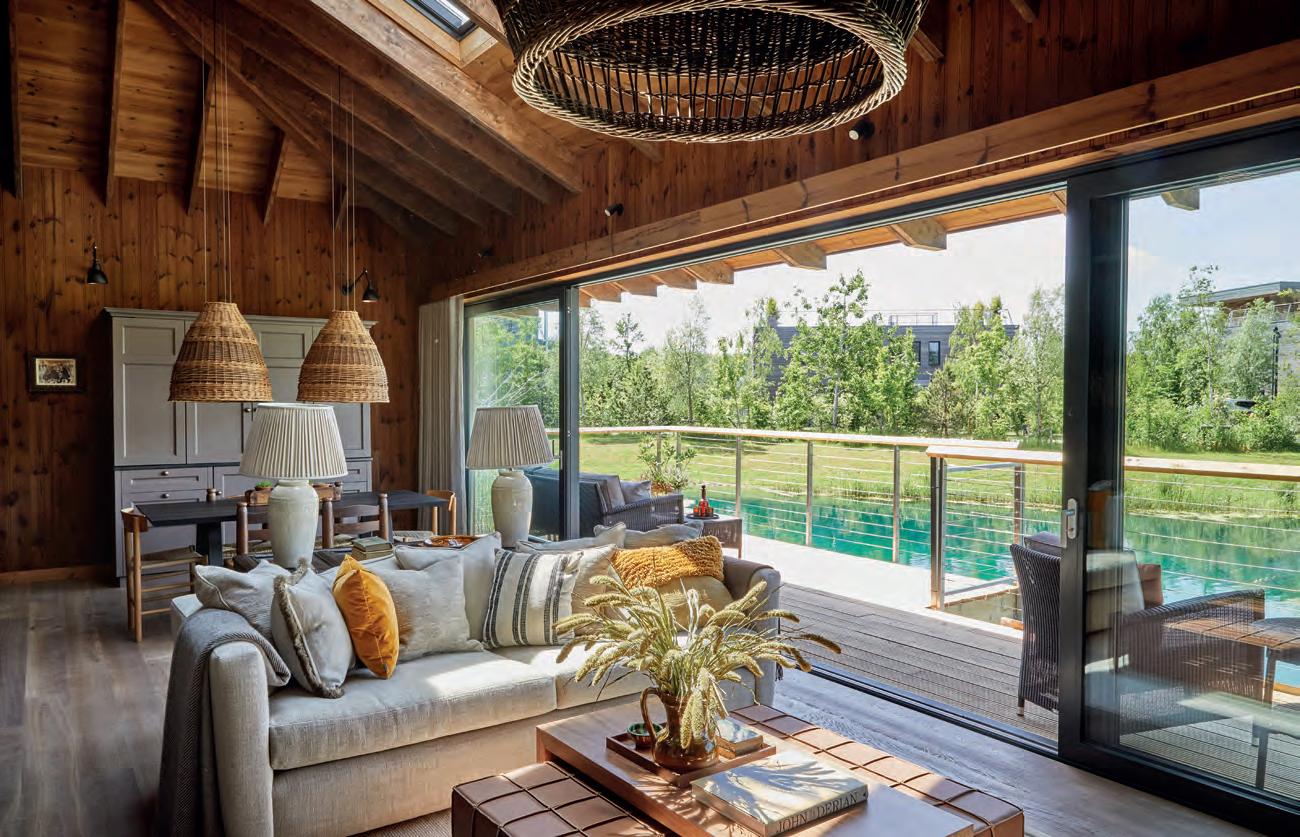
“I think we’re in a much more dynamic economic cycle than we’ve ever been in. I put a plan together at Christmas for no sales. It was a pretty dumb plan. But after going through the Liz Truss thing and increasing inflation, increasing interest rates, I thought there’s only one thing that’s going to do – cause a property crash.” Why does Hitchcox believe that’s not happened? “Because we have such an inefficient system of delivering planning in the UK that the supply side simply hasn’t caught up with demand.”
Should the government be doing more to tackle property prices? “We need to provide more rental property otherwise we’re just going to push prices
even higher. We know most of the council leaders in London and they’re all saying there’s a real shortage of supply. You’ve got interest rates rising, you’ve got a shortage of supply, you’ve got huge demand, 10 people for every flat, which causes a huge inflation spiral. The surprise is that despite interest rate rises and inflation, house builders, us included, are seeing a normal year.”
On the economy, Hitchcox sounds ministerial. Has he ever considered politics? “A lot of people have asked me that. I actually see my role as being way more important, politically and socially, than being an actual politician. What’s the lifespan of a politician these days? A few years? A lifespan of a project like Olympia runs into hundreds of years.”
Back in February, the yet-to-be-finished Olympia London hosted a party on behalf of high-fashion sports label Moncler Genius. Attended by Naomi Campbell, Pharrell Williams, Justin Bieber and Alicia Keys, the event saw a reported 10,000 people queue in the cold to get in. It spoke of the level of ambition Hitchcox has of the West London site.
Four decades into the development game, what continues to fuel those ambitions?
“I’m dyslexic,” says Hitchcox. “So it helps to do things you really like doing.”
LUXURY LONDON INTERVIEW
ONE OF THE CABINS AT THE LAKES BY YOO IN THE COTSWOLDS, WHERE OWNERS INCLUDE KATE MOSS AND MARK OWEN
Paola Paronetto
Ceramist & Designer

THE ITALIAN ARTIST TAKES US INSIDE HER COLLABORATION WITH VEUVE CLICQUOT IN CELEBRATION OF THE CHAMPAGNE MAISON’S 250 TH ANNIVERSARY
Words: Annie Lewis
When Madame Clicquot Ponsardin was landed with the task of running her husband’s champagne business upon his death in 1805, she wasted little time getting to work on the challenge she’d been bestowed. One of the earliest women in history to head up an international business, in 1810 she produced the first known vintage champagne and, eight years later, invented the first blended rosé champagne. Indeed, often referred to as the Grande Dame of Champagne, it is Madame Clicquot who is credited with turning Veuve Clicquot into the prestigious champagne house it is today.
Paying homage to the pioneering businesswoman who broke societal stigmas and glass ceilings, Veuve Clicquot felt it fitting to create a collection bearing Madame Clicquot’s name and, in 1972, launched La Grande Dame premium cuvée to coincide with the company’s bicentenary celebrations. More than half a century later, Veuve Clicquot continues to celebrate its milestones with vintage releases, the past decade having seen the champagne house launch a series of collaborations with pioneering female artists.
In 2020, for example, Veuve Clicquot enlisted
the help of renowned Japanese artist, Yayoi Kusama, to decorate bottles of its La Grande Dame 2012 vintage, the artist choosing a polka dot design with which to do so. This year marks both the champagne house’s 250th anniversary and the launch of its La Grande Dame 2015 vintage. To celebrate the occasion, Veuve Clicquot has partnered with famed Italian ceramicist Paola Paronetto.
Having been based in Porcia, northwest Italy, for the past 20 years, Paronetto made a name for herself crafting intricate objects with a special type of paper clay. Born in 1965, Paronetto recalls experimenting with clay and ceramics during her childhood, this hobby slowly, year after year, transforming into a full-time profession. Today, she creates works for galleries across the world, working out of her atelier in her family home, which she refers to as her “happy place”.
“I started when I was 18 years old,” says Paronetto. “I didn’t go to art school, I just took a ceramics course and I fell in love with clay. Over time, I’ve experimented with different techniques and I felt like doing something different. I was sick of traditional ceramic techniques, which were limiting

 VEUVE CLICQUOT’S FIRST TRAVELLING INTERNATIONAL EXHIBITION, SOLAIRE CULTURE
VEUVE CLICQUOT’S FIRST TRAVELLING INTERNATIONAL EXHIBITION, SOLAIRE CULTURE
me, so I found this paper clay technique and that’s what you see today.”
Made by hand, Paronetto’s objets d’art are constructed from a mixture of clay and paper pulp which results in structures that are delicate but sturdy. Her collections include vases, lamps and bottles, and it’s the latter that has formed her signature style – and drew Veuve Clicquot’s attention.
“The bottles were my very first collection made from paper clay, so this is really close to my heart,” says Paronetto. “I don’t really see the bottles as objects. They’re figures, people and families – that’s why you see them grouped together. The dialogue between different-sized bottles grouped together represents the human race.”
For the partnership with Veuve Clicquot, Paronetto has created six gift boxes crafted from paper clay in her favourite hues from her original 86 non-Pantone colour collection. Paronetto used the brand’s iconic yellow as her starting point, before branching out into other shades inspired by her love of nature, including soft blues and greens, as well as more feminine lilacs and pinks.
“These boxes are 100 per cent eco-sustainable,” says Paronetto. “They are made from a paper-like combination of hemp, cotton and natural fibres. The colours are very connected with nature and are matte, not shiny. The fact there are six colours goes back to the idea of being part of a group and enjoying life together. To see the combination of coloured gift boxes together evokes positivity and a sense of togetherness.”
Alongside the Veuve Clicquot gift boxes –which are debuting in the UK this summer and


available to buy on the champagne house’s website – Paronetto has created a composition of three giant bottles named Giganti Monumentali. This limited-edition artwork is part of Veuve Clicquot’s first travelling international exhibition, Solaire Culture, which touched down in Los Angeles and Tokyo before arriving in London’s Piccadilly Circus earlier this summer.
Arranged alongside works by Japanese contemporary artist Yayoi Kusama, American sculptural textile artist Sheila Hicks, and seven other female artists (all of which were inspired by Madame Clicquot’s achievements), Paronetto’s 1.35-metre-tall bottles were designed to celebrate the skill and resolve of women across the world. “I really enjoyed understanding Madame Clicquot, and what exactly she did, before I started work on this project. To be part of an organisation that carried on her legacy is a privilege.
“I love how much the exhibition showcased her life and the progression of her work. I feel honoured to be part of this history to celebrate a very important woman who did something so incredible. To see that in one place was really special.”
The collaboration has been a first for Paronetto, but has become an experience she will never forget. “I don’t often work in collaborations so this was very different. I’ve really enjoyed collaborating with the maison; I’ve learnt a lot about myself and I’ve pushed myself to the limits. Usually my work is very spontaneous and natural. Here, I’ve had to evaluate my work more and explain my concepts, which has been a fun challenge.”
veuveclicquot.com
51 LUXURY LONDON INTERVIEW LUXURYLONDON.CO.UK
“I don’t really see the bottles as objects... The dialogue between different-sized bottles grouped together represents the human race”


LAURENT GARDINIER President,
Relais & Châteaux
SPEARHEADING AN ASSOCIATION OF ALMOST 600 HOTELS AND 800 RESTAURANTS, LAURENT GARDINIER IS ON A MISSION TO CONNECT PEOPLE WITH PLACES
Words: Richard Brown


THE DINING ROOM AT DOMAINE LES CRAYÈRES, REIMS, WHICH MR GARDINIER CO-OWNS WITH HIS BROTHERS
romoting the art de vivre fills me with joy.” As the co-owner of the château-style Domaine Les Crayères in Reims since 2000, and proprietor of Le Taillevent, that two-Michelin-star Parisian bastion of French classicism, since 2014, Laurent Gardinier has been advocating the ‘art of living’ for more than two decades. Since January 2023, however, that commitment to championing the finer things has gone from a personal passion to something of an official oath.
At the start of this year, Gardinier became President of Relais & Châteaux, an association of
luxury hotels that, in 2014, pledged to UNESCO that it would ‘make the world a better place through food and hospitality’. ‘Elevating the fine art of living is essential for people and the planet,’ said the group. It’s now Gardinier’s job to deliver on that promise.

Often denoted by bronze plaques in their lobbies, or golden crown pins on the lapels of staff, there are currently 580 hotels and restaurants, spread out across five continents, that have successfully applied to join the Relais & Châteaux portfolio. To do so, a hotel must have ‘distinguishing features’ and have demonstrated a dedication to enhancing its local environment. All properties are independent. Most are family-owned.
Here, Gardinier, a former officer in the French navy, talks travel trends, the power of association, and what makes a world-class hotel.
57 LUXURYLONDON.CO.UK
“P
ABOVE A JUNIOR SUITE AT THE GRAN HOTEL MAS D’EN BRUNO, GRATALLOPS, SPAIN
Explain to us how Relais & Châteaux works? We receive around 500 applications a year. We accept around 25 of those, and around 25 properties leave. We work with all of the hotels within the portfolio, helping with marketing, communication, offering digital support. We have an app, offer a reservation platform through our website, and provide printed guides in each hotel room in French and English. For that we charge a commission.
What must a hotel do to be accepted into the Relais & Châteaux portfolio? It mustn’t be pretending to be a world-class hotel. It must do everything it can to actually be one. That means being genuine. Upholding the local culture, respecting the local land, being fully included in the local environment and history. Striving for excellence. As always, everything is in the detail. Pay attention to service. Travellers expect perfect service these days. It has nothing to do with money or prices. Prioritise those two things: attention to detail and great service.
What, then, makes a ‘world-class’ hotel? A mixture of many factors. It’s never just one thing. There’s the physical; the location, the setting, the landscape. Then the historical; the history of the hotel or resort, the buildings, the architecture. And then the human; the service, the attention to detail, the people. Of course, there is also the food and drink, which a lot of our hotels are famous for – we currently have more than 300 Michelin stars within our portfolio.
What do you predict as being the biggest trends in luxury travel in the next two years? I think there will be two key themes. The first, is guest experiences. Travellers now want more from their holidays and from the hotels in which they stay. They want to experience local cultures and meet local people. Relaxing is important, but people want to do things. The second aspect will be sustainability. We will see hotels doing more to reduce their carbon footprint, there will be more green initiatives, which, again, is something guests will expect.
What does the Relais & Châteaux group do to encourage sustainability among its members? Firstly, we try to prevent greenwashing. All of our members
are expected to act responsibly. To eliminate their use of single-use plastic, for example. Of course, sustainability means different things in different places. So we work with hotels and try to set realistic goals. We ask different questions of each hotel and we expect different answers. Sustainability means many different things. It can be to do with efficiency, seasonality. Goals can be environmental, social, cultural. I am focused on reducing our own environmental footprint with economically realistic solutions.
What is the best part of your job? Meeting people. The intellectual aspect. Meeting people who are passionate about the industry and the hotels they work at. Large-scale hospitality groups tend to be more interested in the finance side of things. It is the human side of this business, promoting the art de vivre through our beautiful properties, that makes it so enjoyable.
Which is your favourite city? That’s a difficult one. I really love London. The gastronomy there is incredible. But New York is where I’d choose to live.
How’s the economic outlook from Relais & Châteaux’s point of view? You have to balance realism with optimism. But I am very optimistic. It helps that bookings are looking very healthy – 2023 could be a record year.
What do you hope people associate with the name ‘Relais & Châteaux’? Excellence. Whether that’s architectural, gastronomic or in terms of service. I believe people book hotels because of the ‘Relais & Châteaux’ stamp, but we are not content with just being a reservation platform. We provide our properties tools so they can participate in the development of a better world.
Which is your favourite recent addition to the Relais & Châteaux portfolio? There’s a property in Germany called Purs, in Andernach. It has just 11 rooms and suites, with chef Yannick Noack at the helm of the culinary offering, and Axel Vervoordt as the interior designer. It’s very unique and represents everything that we look for in a Relais & Châteaux property.
relaischateaux.com
“Travellers now want more from their holidays and from the hotels in which they stay. They want to experience local cultures and meet local people”

THE SPA AT MII AMO IN SEDONA, ARIZONA, WHICH REOPENED THIS YEAR AFTER A £34M RENOVATION
Limited to editions of 280, our newly-commissioned Art Deco posters feature glamorous holiday destinations around the world, ski resorts in the European Alps, and the world’s greatest historic automobiles. Over 100 designs to choose from, all printed on 100% cotton fine art paper, measuring 97 x 65 cms. Priced at £420 each (inc. UK sales tax). Private commissions are also welcome.













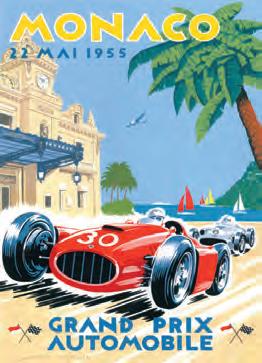
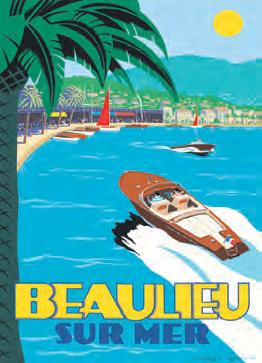
All images and text copyright © Pullman Editions 2023










Pullman Editions 94 Pimlico Road Chelsea London SW1W 8PL +44 (0)20 7730 0547 info@pullmaneditions.com
@pullmaneditionsposters
Our
London
View and buy online at www.pullmaneditions.com NEW!
central
gallery

62 Farewell to the Jaguar F-Type The British marque’s beloved two-seater roars one last time 68 The Magic of the Masters Behind the scenes at Augusta 74 Grape Expectations Blending your own barrel of wine in Bordeaux Features LONG READS TO GET LOST IN
Phil Mickelson tees off on the 18th hole during the first day of the 2023 Masters Tournament, 6 April 2023, p.68
ONE LAST BLAST
AS THE CARMAKER PREPARES TO GO ALL-ELECTRIC FROM 2025, JAGUAR’S NEW SPECIAL-EDITION F-TYPE 75 REPRESENTS THE SWANSONG OF THAT MUCH-LOVED TWO-SEATER AND THE BRITISH MARQUE’S LAST EVER COMBUSTION-ENGINE CAR. TIME, THEN, FOR ONE LAST ROAR AROUND THE FRENCH RIVIERA
 Words: Rory FH Smith
Words: Rory FH Smith


Back in the early 1950s, there wasn’t an awful lot to be optimistic about in the United Kingdom. The country was still recovering from a brutal World War, which had claimed over 450,000 British lives, destroyed thousands of buildings and forced businesses up and down the country to cease trading. Yet, while good news might have been thin on the ground, motorsport, perhaps improbably, had just entered something of a golden age.
Leading the field at that time was the stunning XK120, Jaguar’s first true sports car, which debuted at the London Motor Show in 1948 in open-top, concept form. Its curvaceous, aluminium body caused something of a sensation. So much so, that it convinced Jaguar founder Sir William Lyons to put the car into production almost immediately.
Claiming the coveted title of the world’s fastest production car, the XK120 took its name from the aluminium-bodied cars’ top speed of, you guessed it, 120mph. The following year, Jaguar took the XK120 to the track.
At a race at Silverstone in 1949, a XK120 finished in first and second place. By 1950, XK120s were racing at the 24 Hours of Le Mans, the Targa Florio in Sicily, the Mille Miglia in Italy, the Alpine Rally in France, and several races in the States. Victory came in volume, establishing Jaguar’s racing credentials in the process.
Following in the footsteps of the XK120 were legendary cars like the C-Type, the Le Mans-dominating D-Type, and the iconic, wedge-shaped also-Le-Mans-winning XJR. While all this might seem like a lengthy history lesson, it provides the background to one of the most important cars Jaguar ever made, a natural-born racer that would define the direction of the great British brand in the modern era – the much-loved F-Type, which arrived in 2013.
Now, a decade after the car was launched, and only two years since it underwent a significant restyling, Jaguar is calling time on the F-Type and, from 2025, on its combustion-engine lineup altogether. This year’s Jaguar F-Type 75 is, then, something of a bittersweet moment – although it’s difficult to feel too downbeat when you’re looking at a brace of V8-powered F-Types flanking a fine example of their great grandfather – the legendary race-winning ‘NUB 120’ XK – outside The Maybourne Riviera hotel in the hills above Monaco.
The F-Types in question have been commissioned as a final act to the highly-rated two-seater. On my left, the F-Type 75; on

65 LUXURY LONDON FEATURE LUXURYLONDON.CO.UK
MAXIMUM POWER 450 PS MAXIMUM TORQUE 400/4,500 NM/RPM TOP SPEED 177MPH 0-60MPH 4.4 SECONDS PRICE FROM £78,535
F-TYPE 75 COUPÉ
A natural-born racer, the F-Type would define the direction of the great British brand in the modern era
my right, the F-Type R75. The difference? The range-topping R model possesses 125 more horsepower and is available in all-wheel drive. The two models represent your last chance of purchasing a new F-Type with a V8 under the bonnet.
Starting with the marginally less-powerful of the cars, the 75 boasts a supercharged 5.0-litre P450 engine and is finished in a fetching new paint shade called Giola Green. Like all previous F-Types, the styling still looks fresh, despite the original car being penned as a concept by former Jag designer, Ian Callum, 12 years ago. It is available in rear- and four-wheel drive, and as a convertible or coupé. To experience the guttural roar of that British-made V8 one last time, you can’t beat the rear-drive droptop option. It’s hard to believe that such a visceral sound will soon become a thing of the past.
Both the 75 and R75 come equipped with 20-inch rims and Windsor leather as standard. Slight chassis tweaks make the handling in these F-Types even more precise than previous models, most notably in the range-topping R model.
With 450 PS in the 75 and 575 PS in the full-fat R75, both have plenty of performance. The latter will cover the 0-60 mph dash in just 3.5 seconds and go on to an electronically-limited top speed of 186 mph – impressive stats that were slightly wasted on the twisting
roads above Monaco and Nice, though the views made up for it. Stepping into the more powerful R75, the snap, crackle and pop from the exhaust ricochets off the valley. On the road, both models are still hugely satisfying to drive. The handling differences from the 2019 update, which consisted of a facelift and new front lights, are minimal on both 75s, but as far as thrilling two-seater sports cars go, the F-Type remains hard to beat.
The final run F-Types start at £78,535 for the 75 coupé, and extend all the way to £108,270 for the R75 convertible. The satin black paint finish on our test car added a whopping £9,990 to the extras bill alone.
You’ll pay a premium, then. But what price do you ascribe to a piece of veritable British motoring history? The final F-Types fly the flag for 75 years of motor racing at Jaguar and almost 90 years of the marque as we know it. Not long from now, you won’t hear the gurgle of a naturally-aspirated combustion engine. Nor the angry snarl of a virile V8. You’ll read about the engines in magazines and be startled by the noise they used to make at classic car shows. If that’s not an incentive to acquire one of the most beautiful V8powered sports cars ever made, I’m not sure I know what is.
jaguar.co.uk

MAXIMUM POWER 575 PS MAXIMUM TORQUE 700/5,000 NM/RPM TOP SPEED 186MPH 0-60MPH 3.5 SECONDS PRICE FROM £103,075
Not long from now, you won’t hear the gurgle of a naturally-aspirated combustion-engine. Nor the angry snarl of a virile V8
F-TYPE R75 COUPÉ


SPAIN’S JON RAHM ON THE 12TH HOLE DURING THE FOURTH DAY OF THE 2023 MASTERS, 9 APRIL 2023, ALAMY
INSIDE AUGUSTA
IT’S ONE OF THE HOTTEST TICKETS IN WORLD SPORT, A BUCKET-LIST MOMENT FOR ANY DEVOUT GOLF FAN. BUT IS THE MASTERS TOURNAMENT REALLY AS MAGICAL AS IT APPEARS ON TV? LUXURY LONDON IS INVITED BEHIND THE ROPE INTO A WORLD OF ARTIFICIAL BIRDSONG AND SPRAY-PAINTED LAWNS
Words: Jeremy Taylor

What would you say is the hottest ticket in global sport? The Champion’s League final, maybe? Wimbledon? How about the Superbowl? I’d go as far as to say the annual Masters Tournament – one of golf’s four major championships, and the only major to be played at the same course each year –is all three of those events rolled into one.
Sports fans from every corner of the globe scramble for insanely inflated tickets to watch golf’s finest tackle a picture-perfect course in Augusta, Georgia, in a competition that dates back to 1934. The random online lottery for tickets opens 1 June the previous year, but there is only around a 0.5 per cent chance of being a lucky applicant (although organisers never reveal exactly how many tickets are available).
Apart from applying and crossing your fingers, the best way to gain access is by befriending an Augusta National member – they’re the people in the green jackets and are each given a small allocation of tickets. Yes, they are the same green jackets famously presented to every winner of the Masters, although even the tournament’s victors aren’t allowed to move their blazers away from the Augusta clubhouse – jackets have to stay in the locker room, on pain of death (they’re a quirky lot at Augusta).

Rumour has it that members sell their spare
tickets for up to $10,000 a pop. Extraordinarily, some tickets miraculously end up for sale outside the course gates, changing hands for around $8,000. Touts are often arrested and anyone caught buying a ticket in the street isn’t allowed in. Which is why I’m incredibly grateful to be installed in what is locally known as ‘Mercedesville’ – a luxury estate on the edge of town that is home to the German marque and its invited guests. The enormous house that I’ve been put up in has been rented from a private owner. Properties can charge upwards of $45,000 a week during the Masters – there being a distinct lack of decent hotels in the area. To get me to and from the estate clubhouse, I’m given the keys to a golf buggy. I wouldn’t want to miss out on bands like Hootie & the Blowfish playing in the evenings, after all.
For my invitation, I have the new-look GLE SUV to thank, which Mercedes has chosen to reveal, subtly, at this year’s event. It’s a savvy move, given that overt branding is banned at Augusta – nobody, not even the players, are allowed to display the logos of their sponsors around the hallowed turf. I was barked at by an irate course official for wearing a discreet McLaren baseball cap.
Before I arrived at the course – as Tiger Woods, Jon Rahm and Rory McIlroy were preparing to battle it out for a share of a £14.5 million purse –I was granted some alone time with the new GLE.
LEFT KAZUKI HIGA, OF JAPAN, HITS HIS TEE SHOT ON THE 14TH HOLE DURING THE FIRST ROUND OF THE 2023 MASTERS, AP PHOTO
RIGHT RAHM HUGS HIS CADDIE AFTER WINNING THE 2023 MASTERS, ALAMY


Picking up the car from Atlanta, I headed north-east on Highway 19, passing Cumming and Dahlonega on the way to the ChattahoocheeOconee National Forest. The flatlands there quickly give way to dramatic mountain scenery, where a canopy of trees cling to every hillside.
The GLE is a supremely comfortable drive, with enough trunk space for several sets of golf clubs.
The AMG 53, which I was driving, is one of the performance models, spacious and luxurious – with four-wheel drive if you do end up in the rough.
After winding through the Appalachian Mountains, and then parts of North Carolina, I turned due south to Augusta itself, following the Savannah River state boundary for 170 miles. Mountains turned to savannah and prime farming territory before, eventually, I joined the melee of sports fans heading for the golfing world’s Mecca.
What followed was a weekend-long marathon of traditional pimento cheese sandwiches, chauffeured golf buggies, cold beer, private-chef dinners and conversations with golfing elite and the giants of corporate finance.

The Augusta course looks like it does on TV. Spectators crowd tree-lined fairways that are encircled by lakes, littered with giant bunkers and surrounded by trademark azaleas – the flowers seeming to blossom just on cue every year. Not everything is as it seems, however.
That birdsong? It’s largely fake, played discreetly through loudspeakers to improve the ambience
for spectators. The fairways and greens are faultless, but turf at the boundaries gets trampled by spectators. To keep them looking photogenic, well-trodden paths are spray-painted green. This year, the trees added an additional element of drama – heavy rain and wind bringing at least one crashing down to narrowly miss a group of watchers-on.
Each sponsor has a mini clubhouse, with roundthe-clock food, drink and hospitality, plus a giant TV screen at every turn to watch the action unfold. During rounds of canapés, fine wine and cigars, I was invited to meet Bernhard Langer, a two-time Masters champion and Mercedes ambassador.
While tickets are traded for eye-watering sums, if you’re lucky enough to secure one in the ballot, you’ll only pay around $140 per day at face value. Prices of refreshments, too, apparently haven’t changed much since the 1990s – not even for the famous pimento cheese sandwiches.
A little like Glastonbury, or, on a smaller scale, Ascot, attending the Masters is more about the experience, the feeling of being there, than anything you actually see. For many, just a glimpse of seeing Tiger Woods will be enough. Bagging a spot by the 18th on the last day is, of course, the holy grail. Just like Glastonbury, the Masters is about memories. To say that you were there. That you got to taste those sweet pimento cheese sandwiches.
masters.com; mercedes-benz.co.uk
73 LUXURYLONDON.CO.UK
A little like Glastonbury, attending the Masters is more about the experience than anything you actually see
LEFT JAPAN’S HIDEKI MATSUYAMA PLAYS HIS TEE SHOT ON THE 18TH HOLE DURING THE FINAL ROUND OF THIS YEAR’S MASTERS, ALAMY RIGHT RORY MCILROY AND TIGER WOODS WALK TO THE 11TH TEE DURING A PRACTICE SESSION FOR THE 2023 MASTERS, AP PHOTO
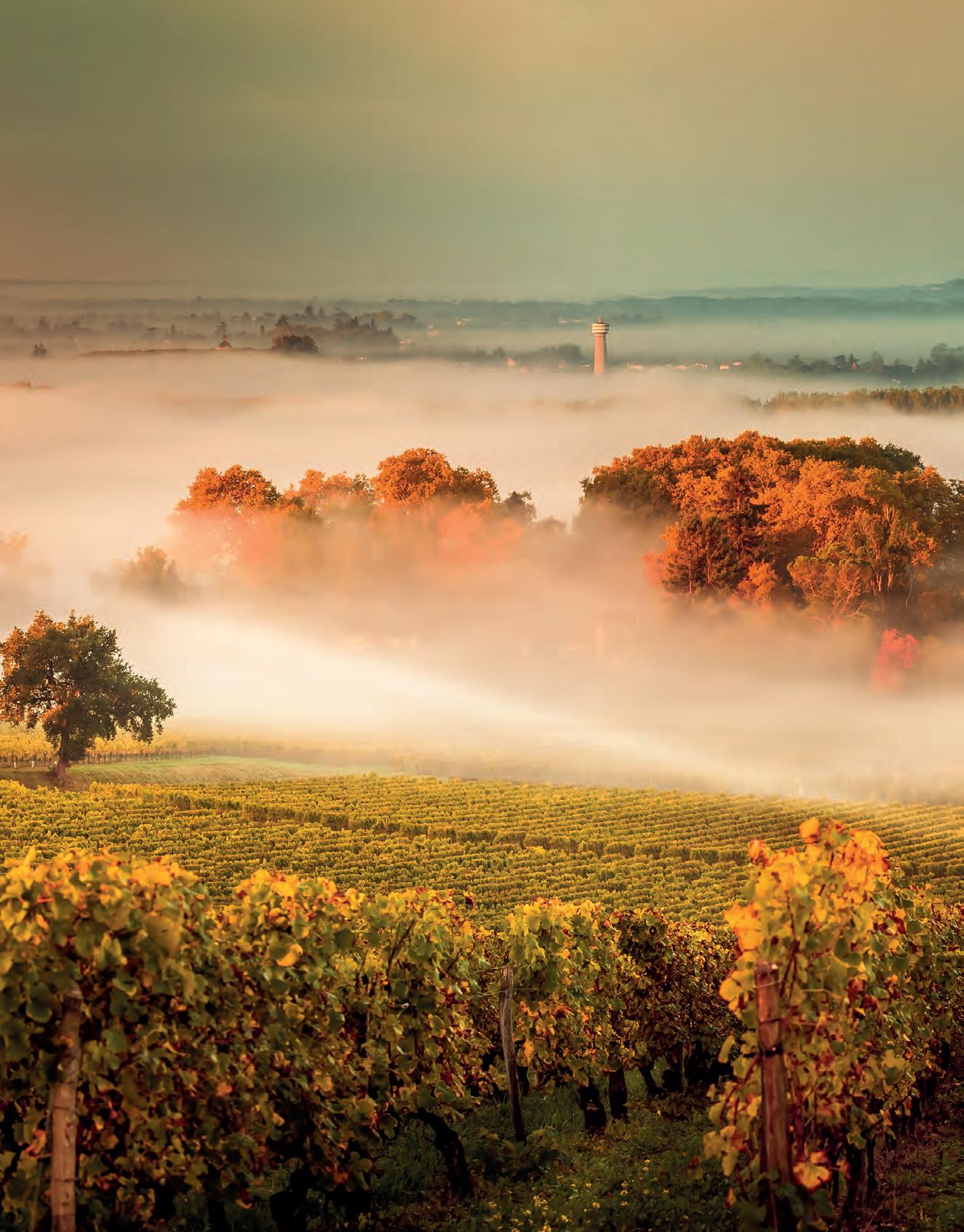
Pigments of your Imagination
A NEW WINE CLUB INVITES YOU TO BLEND SOME OF THE MOST CHERISHED GRAPES ON THE PLANET INTO A BARREL OF YOUR OWN
Words: Rob Crossan
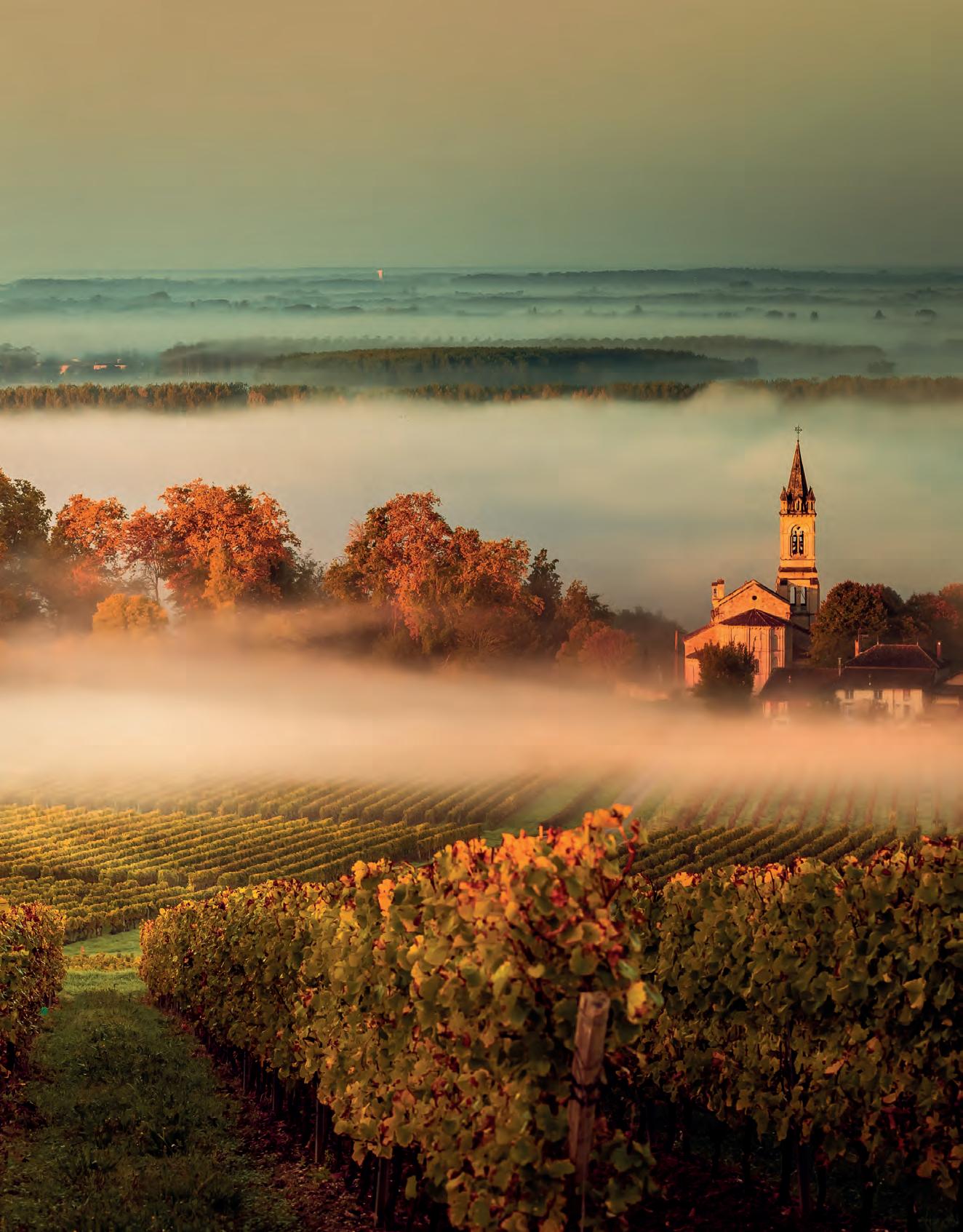
icking a sacred cow is, of course, immensely enjoyable. Op-ed journalists, amateur iconoclasts, spittle-flecked contrarians and Clapham omnibus frequenters would find little flesh to sustain them if they didn’t occasionally decide, whether through casual whim or collective peevishness, to clamp their incisors around the soft middle of any number of self-proclaimed cultural totems – from Tesla to Joe Rogan to The 1975.
Bordeaux wine, with its uppity lexicon of ‘growths’, ‘grand crus’ and Napoleonic-era classifications, has, then, always been ripe (pardon the pun) for being knocked down a viticulture or two. Indeed, where connotations are concerned, the cost of a bottle of Bordeaux is nothing compared to the images conjured by the noun itself: think ‘Bordeaux’, or, as we English still prefer to call it, ‘claret’, and images of wood panelling, gentlemen’s clubs, bow-ties, braces, Jaguar X-Types and a belief that fossil fuels and roast beef are an absolute necessity for survival, are never far away.
Like many people, I’ve spent my adult life believing that the Bordeaux party is a shindig to which I’ll never be invited. Increasingly, it’s also a party I’m not sure I’d attend even if I were. Bordeaux is just too clichéd, too pleased with itself, too likely to be mixed with Coca-Cola by a Chinese potentate or be placed in the fridge by a recentlyretired, heavily-tattooed AC Milan midfielder. Bordeaux is what is served on yachts in Monaco.
And, it seems, it’s not just me who thinks so. In recent years, more considered oenophile minds than mine have demonstrated a penchant for a spot of Bordeaux bashing. The chief criticism, of course, is the stratospheric price of even a half-decent vintage. There’s also a feeling that the dominant grapes – cabernet sauvignon and merlot – are out of fashion with the young and hip, and that Bordeaux, as a region, is lacking the kind of dynamic, forwardthinking marketing drive needed to expand its appeal to a younger generation.
Well, there is one group at least aiming to put Bordeaux back on the map: new private members’ wine club, Osiris. Depending on your tier of membership, Osiris provides access to some of the world’s leading vineyards – in California, Argentina, South Africa, Italy, and, yes, Bordeaux – where you can create your own blend, work on a custom-designed label, and have a barrel of your creation delivered to your home. You’ll also be invited to exclusive dinners, parties, tasting events and wine trips. Oh, and membership comes with access to a full-service lifestyle concierge, too.
Blending my own Bordeaux seemed as potentially hazardous, and possibly heretic, as being handed a marker pen and being told to ‘add what you want’
to an original Caravaggio. Yet Paul McSharry, the Irish-born, English-raised, Napa-Valley-based wine investor and founder of Osiris, ensured me that my terror of meddling with the terroir was exactly the sort of sentiment he hoped to challenge.
My attempts to create at least one drinkable glass of my own took place in one of the more open-minded vineyards of the region: Château Malartic-Lagravière. Once owned by the Comte de Malartic, admiral to the King of France in the mid18th century, the Château has been in the hands of the Bonnie family (who hail from Belgium) for the past 26 years.
The vineyard is in the region of Graves, where the British love affair with Bordeaux began. The oldest wine region in Bordeaux, the area’s reputation dates back to Henry II and Eleanor of Aquitaine, who developed a brisk trade that saw Britain export iron and coal to France, and, in return, France send ‘Graves claret’ back the other way.
Just like the Champagne region, individual vineyards in Bordeaux are usually diminutive in
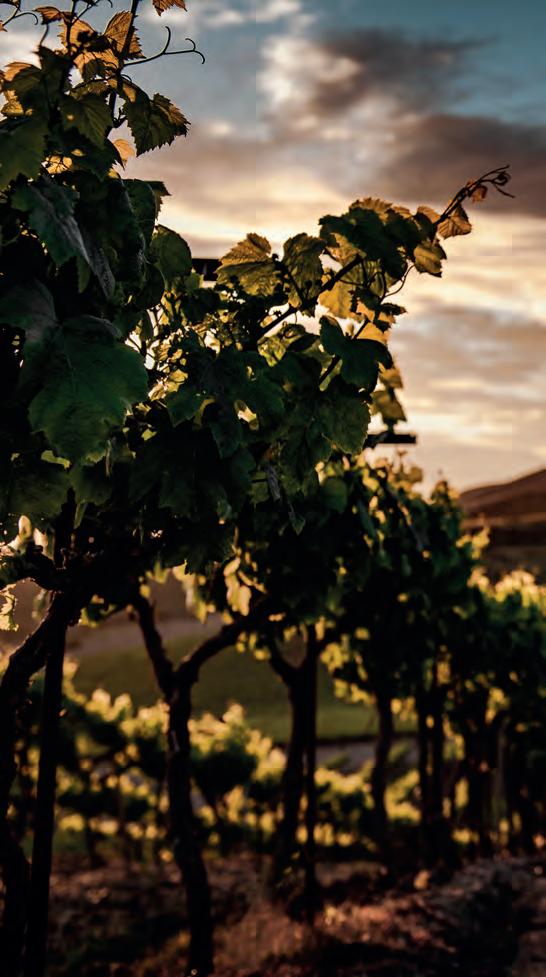
K
Naturally enough, what I had created was a flabby, flat wine that had all the finesse of a Brent goose attempting a tightrope walk
size. Malartic-Lagravière, for example, has just 47 acres under vine, producing wines with a blend of 50 per cent Cabernet Sauvignon, 25 per cent Merlot and 25 per cent Cabernet Franc. What makes Malartic particularly special, and makes its outgoing attitude even the more surprising, is the sheer, medal-laden weight of its wines.
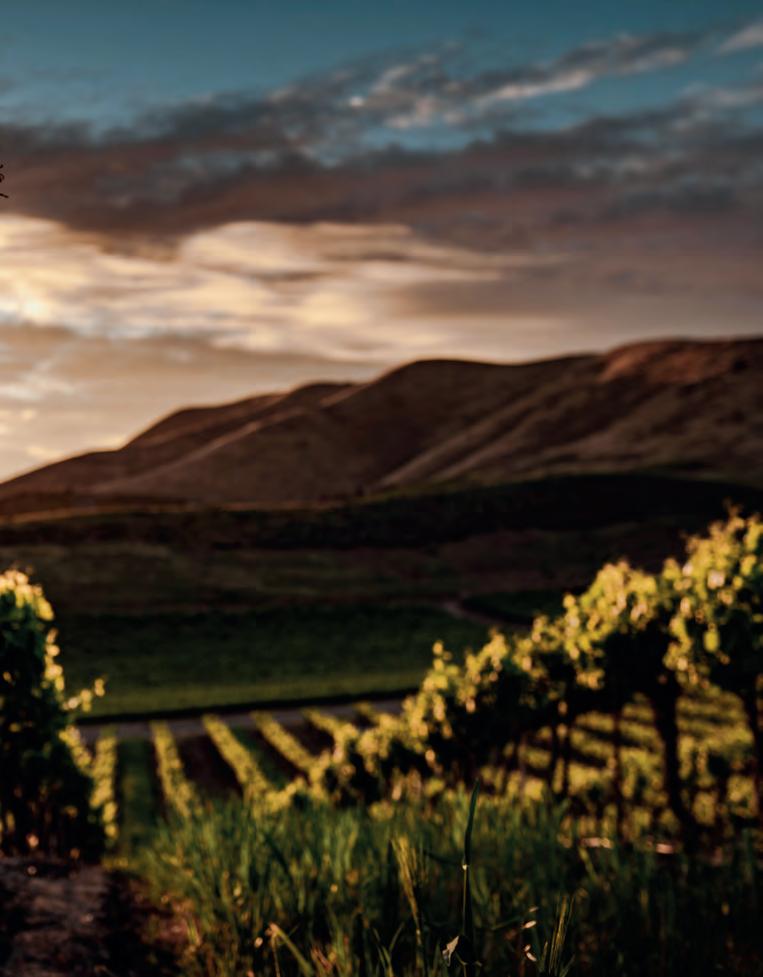
Bordeaux wine is obsessed with classifications and Malartic-Lagravière was given its vital credentials in the 1955 Graves Classification, created a century after the original ‘best in class’ vineyards list was compiled on the instruction of Napoleon III. Today, Château Malartic-Lagravière is one of just six estates in the entirety of Bordeaux which is classified for both its white and red wines.
So, just how much damage could my own wanton wine-making skills reap onto the grapes? Sitting amid ranks of wine glasses in the Palladian-looking châteaux itself, I’m encouraged to taste, slurp and spit some of the vineyard’s finest reds before creating my own blend. For the neophyte like myself who generally sees reds as a headache-inducing mistake at the end of a long night out, these are epically discreet, elegant and well-balanced; the story of the gravelly soil, sunshine of yore, Atlantic winds and fecund vegetation evolving in the mouth with the graceful speed of the finest André Gide short story.
Plumping for a blend of 40 per cent Petit Verdot, 20 per cent Cabernet Franc and 40 per cent Cabernet Sauvignon, the waiting vigneron JeanJacques who, with his shoulder length blonde hair and muscular look, is the Axl Rose of Bordeaux, blended the grapes according to my measurements. Ten minutes later and after a lot of messing about with funnels and measuring jugs, he returned with a glass of ‘my’ creation.
Naturally enough, what I had created was a flabby, flat wine that had all the finesse of a Brent goose attempting a tightrope walk. Yet, as McSharry assured me, more time spent with the winemakers (plus a little more deferring to their suggestions I assume) could result in a barrel of Châteaux Crossan that might not shame what remains of my reputation.
Bordeaux bashing, in certain circles, will always be a popular pursuit. And while a game of word association is still unlikely to connect the region with ‘bargain’, for perhaps the first time since before Henry II, it’s now possible to create your very own Bordeaux without the means of a Plantagenet King. You just need to subscribe to a private members’ club called Osiris.
A case of six bottles of Château Malartic-Lagravière’s acclaimed 2015 Pessac-Léognan is currently available for approx. £200 from Berry Bros. & Rudd, bbr.com; osirisclub.com

77 LUXURYLONDON.CO.UK
the art of living
Bespoke luxury travel, event creation and lifestyle management.



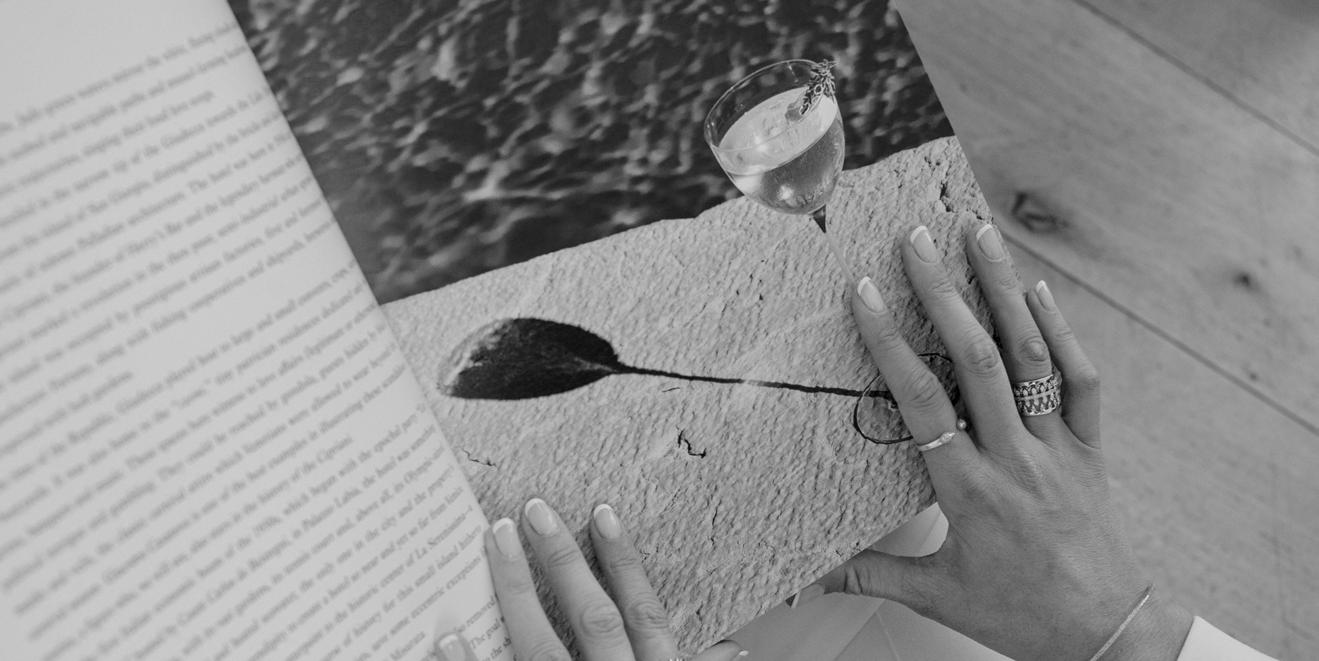
Empearl is your trusted consultant for lifestyle management, event planning and bespoke travel, whenever and wherever you need us. By combining our eye for detail with our extensive network of trusted connections, you can experience the best the world has to offer. For more
on Empearl

our
visit our website empearl.co
information
and
services,
For its second The Artists’ Editions capsule collection, Vilebrequin has teamed up with Swiss art publisher JRP|Editions and American artists Deux Femmes Noires to produce a range of trunks that pay homage to the Harlem Renaissance movement of New York in the 1920s and 30s, vilebrequin.com


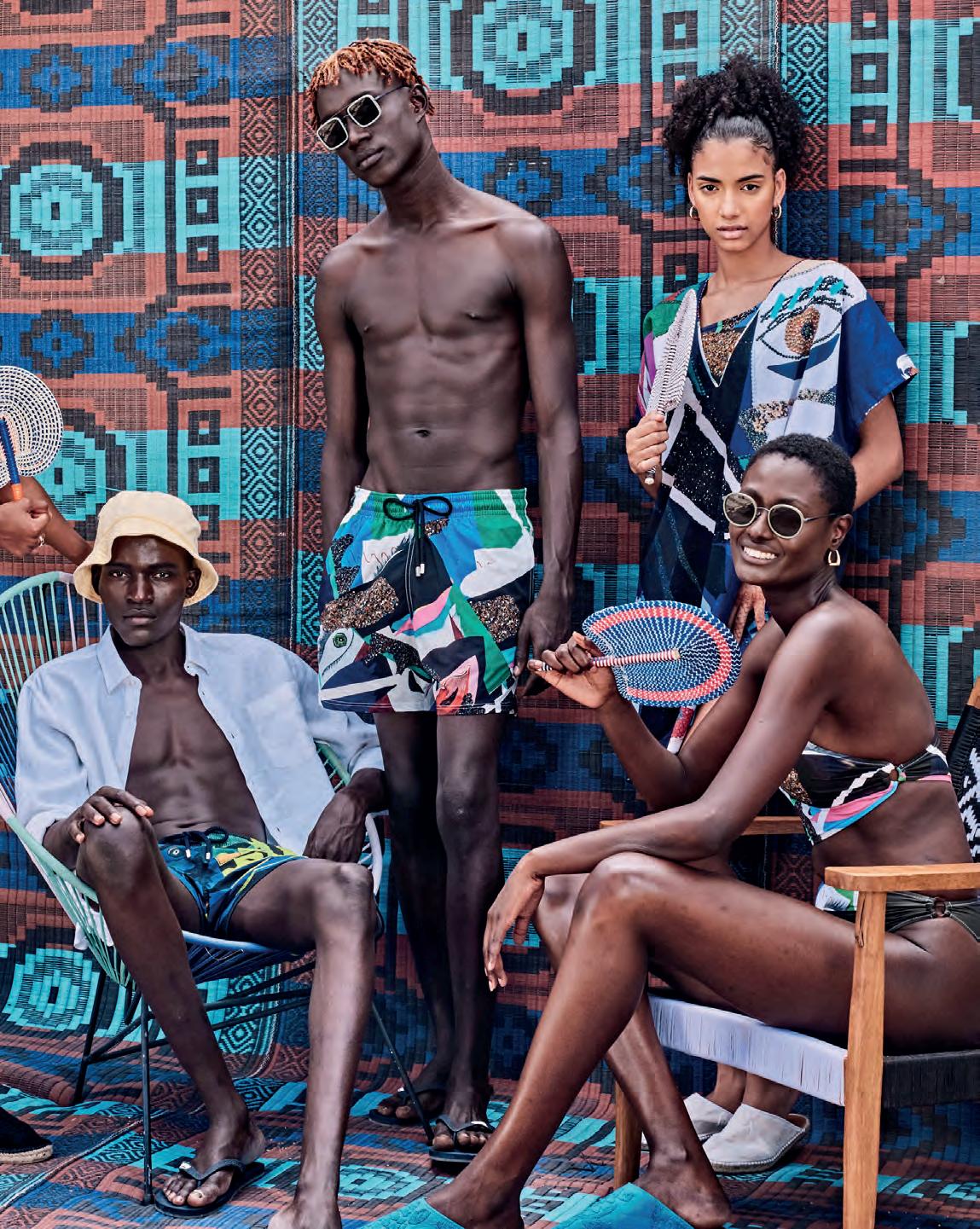
CUT FROM A Style 80 A Shorts Story How Vilebrequin became the king of swimwear 86 Style Edit: Him Statement shorts, shirts and sunglasses 90 Cruise Collection What to wear on holiday this summer 105 Style Edit: Her This season’s must-have hats, handbags and jewellery
DIFFERENT CLOTH
UPTOWN TRUNK
FIFTY YEARS AGO, A FRENCH MOTORING JOURNALIST DOODLED A SKETCH ON A CAFÉ TABLECLOTH THAT WOULD REVOLUTIONISE WHAT MEN WORE TO THE BEACH FOREVER
Words: Rob Crossan

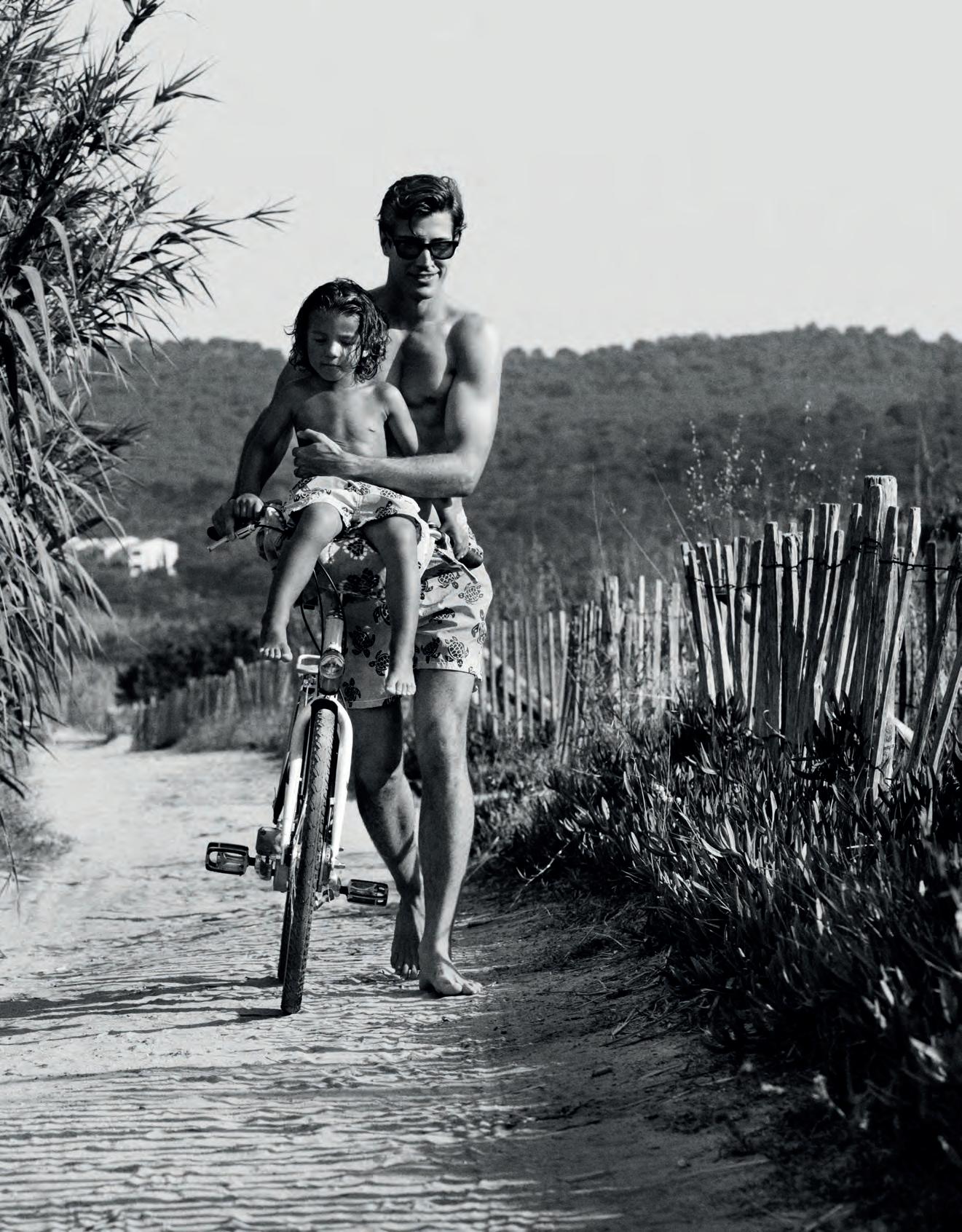
 FRED PRYSQUEL WITH HIS WIFE, FASHION DESIGNER AND BOUTIQUE OWNER, YVETTE
FRED PRYSQUEL WITH HIS WIFE, FASHION DESIGNER AND BOUTIQUE OWNER, YVETTE
St. Tropez. Summer 1971. The long, offwhite tassels that hang from the fringes of the canary-yellow parasols ripple, coquettishly, in the breeze. Amid the tall glasses of pastis and ashtrays brimming with the butts of languorously-smoked Gitanes, lunchtime diners, in flowing, printed dresses and shirt lapels that seem to be getting wider by the hour, look out at the vanilla-soft sands of the beach in front.
Try as they may, they can’t avert their gaze from one man standing in the shallows, dressed in nothing more than a pair of thigh-high shorts, the pattern of which is a fiesta of thick vertical stripes in striking blue, yellow, green and purple, a pattern that seems to flicker in the early-afternoon sun.
Who is this man? Could it be Alain Delon, fresh from the bruising travails of his latest Parisian heist movie, Le Cercle Rouge? The only person in the café that knows for certain is the photographer and motorsports journalist, Fred Prysquel. The lone swimmer isn’t famous. He just looks famous. It’s the shorts, Prysquel likes to think, the pattern of which he sketched on a paper tablecloth in this very café the previous summer.
Vilebrequin is the French word for ‘crankshaft’, an oblique and recherché noun for a swimwear brand that, half a century on from its debut on the beaches of St. Tropez, continues to fuse a look that’s both exotically contemporary and ineffably routed in a long lost France of long Françoise Hardy hair,

Serge Gainsbourg-smoked cigarettes and Ricardsoaked afternoons on the Côte d’Azur.
Colour blind from birth, for his first collection of swim shorts Prysquel used fabrics he’d brought back from African markets he’d visited the previous decade while completing military service on the continent. “In Dakar [Senegal], swim shorts were made of fabrics called ‘boubou’ or ‘wax’,” recalled Prysquel. “I loved them. When I left the army, I brought some home with me.”
Prysquel’s swimwear, or ‘bathing suits’ as he and the company’s successive owners preferred to call them, are garments that men from Nice to Newcastle should be thankful for in 2023 – even if they’ve never actually owned a pair. The cooler, looser shape of Prysquel’s tyro designs would, after all, be pivotal in achieving his grand ambition: to redefine the male swimming brief from an Antipodean attack on our eyes – and crotches –to something far more fun, frivolous and flattering.
The previous decade, you see, had seen the ‘Speedo’ – a garment that remains a byword for every compelling argument for never visiting a beach – gain a global momentum beyond its native Australia. Fred’s napkin doodle reimagined the longer board-shorts worn by surfers at the time, made them shorter, more fitted and more sartorial. His sketch became an antidote to the ‘budgie smuggler’ – that cheap, uncomfortable al fresco fashion statement that’s invariably worn by men
83 LUXURY LONDON STYLE LUXURYLONDON.CO.UK
This was to be a Battle of the Bulge that had nothing to do with Panzer divisions in the Ardennes
whose physiques suggest a life of Big Macs rather than breaststroke. This was to be a Battle of the Bulge that had nothing to do with Panzer divisions in the Ardennes.
Persuading his wife, Yvette, herself a fashion designer, to stock his new designs in her St. Tropez boutique, Prysquel’s brazenly-colourful designs (Yvette would help pick the colours) had a strangely chimeric quality on their wearers that long-gone summer, his nascent brand quickly establishing a high-spirited and well-heeled audience in the south of France. Soon, the erstwhile motoring journalist was cajoling every female acquaintance in the possession of a sewing machine to turn their hands to making his dazzling bathing suits.
Prysquel would eventually sell Vilebrequin in 1991 to fellow Tropezian textile worker, Loïc Berthet. It was Berthet that added the nowsignature Velcro back pocket and silver eyelet holes. He also introduced a cotton inner lining to the shorts. In 2012, the company was acquired by the G-III Apparel Group, the US clothing company that owns licenses to DKNY, Calvin Klein, Tommy Hilfiger and Karl Lagerfeld. Yet the daring designs have continued; shorts with sea-turtle motifs, Portuguese azulejo tile mosaics, and crocodiles crawling through pink and yellow mangroves attracting new generations of men whose knowledge of Alain Delon is, you might assume, all but non-existent.
According to the experience of veteran, Londonbased personal stylist, Nick Hems, Vilebrequin seems to be more popular today than it’s ever been. “It’s amazing just how many of my female customers reach for a pair of Vilebrequin’s for their partners,” says Hems, “often without actually knowing the brand they’re choosing. They’re just the perfect ‘transition’ shorts, in the sense that you can wear them in pool bars and on café terraces and they’re
not just for swimming or sunbathing. Plus, they’re form-fitting shorts – they really get the shape right.”



We may now look back at the smoke-fogged, sun-broiled days of 1970s St. Tropez though a sepia filter, but you can chalk Vilebrequin’s success to the fact it remains grounded in the legacy of that bohemian era. In 2015, the brand collaborated with the Rolling Stones on a range of shorts covered by a collage of some of the group’s most famous album sleeves (though, thankfully, the collection excluded the infamous ‘toilet bowl’ cover of 1968’s Beggars Banquet LP).
It was in the summer of 1971, the same year that Prysquel’s shorts debuted, that the tax-dodging Stones fled to Villefranche-sur-Mer, a small fishing village a few miles along the Côte d’Azur from St. Tropez. Holed up in a crumbling mansion that was once occupied by Nazi officers, the band festered in a makeshift studio located in the villa’s sweltering basement, recording some of the tracks that would appear on the following year’s Exile on Main St., their swampy, bluesy, nefarious masterpiece.
It was a collaboration that at first glance might not have screamed symbiosis. Yet, you might reasonably argue, what’s more rock ‘n’ roll than having a screwball idea and pursuing it fullleather? What’s more maverick than a motoring hack taking a punt on some retina-rattling swimshorts named after a crankshaft?
Modern as its swim-shorts may look today, the triumph of Vilebrequin has everything to do with the gateway the brand unlocks to those dreamy, anything-could-happen 70s summers. Even now, Vilebrequin transports us to a simpler, more elegant time when men would hit the beach, in Prysquel’s words, with little more than “a comb, a lighter and a pack of Gauloises.”
vilebrequin.com
The triumph of Vilebrequin has everything to do with the gateway the brand unlocks to those dreamy, anything-could-happen 70s summers
Ronde des Tortues Multicolores, £230 Poulpes Neon, £230 Provencal Turtles, £230

UP
ART PUBLISHER JRP|EDITIONS
AMERICAN ARTISTS DEUX FEMMES NOIRES FOR THE ARTISTS’ EDITION VOLUME II CAPSULE COLLECTION
FOR 2023, VILEBREQUIN HAS TEAMED
WITH SWISS CONTEMPORARY
AND
Where Vilebrequin stepped foot in the seventies, a surfeit of pattern-loving, figurehugging shorts-centred brands have followed, applying a Savile Row tailor’s touch to what we wear around the pool. Heck, even waxworshiping Barbour has reached for the polyester (and, as you can see from the below, the result isn’t half bad). Baggy board shorts are out. Straight-leg, mid-rise styles are in. And remember, the louder the better.




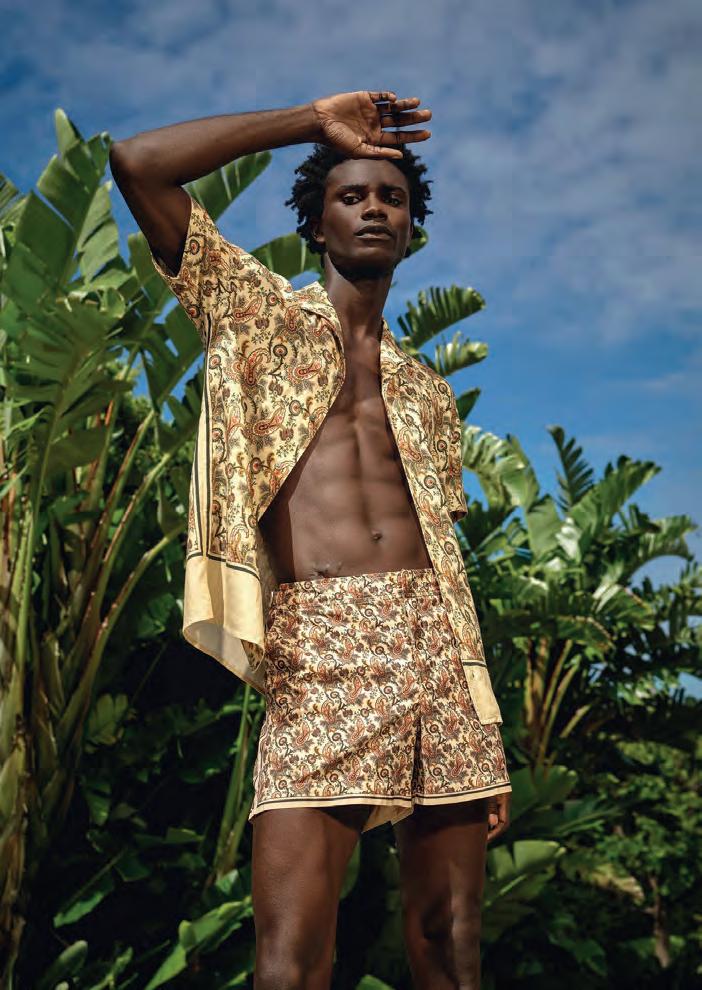
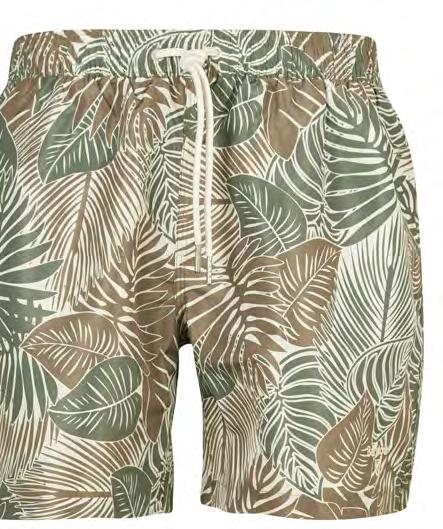 Edited by: Richard Brown
Edited by: Richard Brown
SHO RT SUPPLY
PILOT SWIM SHORTS, £105, Patemar, patemar.com
SHIMMER SUNNY PAISLEY SWIM SHORTS, £295, Orlebar Brown, orlebarbrown.com
GOSCH SWIM SHORTS, £165,
LA
CHECK DRAWCORD SWIM SHORTS, £320, Burberry, burberry.com
COMMODE
MONO TRUNKS, £175, CDLP, cdlp.com
LEAF SWIM SHORTS, £54.95, Barbour, barbour.com
URBAN Safari
To surf the undulating temperatures of summer you need a suitably utilitarian jacket. Traditionally worn by French farm labourers, chore jackets are the ultimate all-season allrounders, while safari jackets offer a lightweight sartorial option for warmer months. Interpreted for the modern adventure-seeker, both options now work as well on the savannahs of Africa as they do the streets of Shoreditch.




 Edited by: Richard Brown
Edited by: Richard Brown
87 LUXURY LONDON COUTURE LUXURYLONDON.CO.UK
NEEDLECORD CHORE JACKET, £525, Drake’s, drakes.com
KHAKI NORFOLK JACKET, £1,500, Connolly, connollyengland.com
COTTON LINEN CHORE JACKET, £345, Trunk, trunkclothiers.com
SUEDE SAFARI JACKET, £6,200, Brunello Cucinelli, brunellocucinelli.com
LINEN FIELD JACKET 2.0, £695, Private White V.C., privatewhitevc.com
Sure, black Wayfarers work with everything, but to channel California cool you can’t beat a pair of retro tortoiseshell frames. Keep it classic and opt for smaller-sized round shades, or go bold with chunky, square silhouettes. They say circular frames are best for oval faces, and rectangular outlines for longer profiles. But, really, whatever works for you, right?



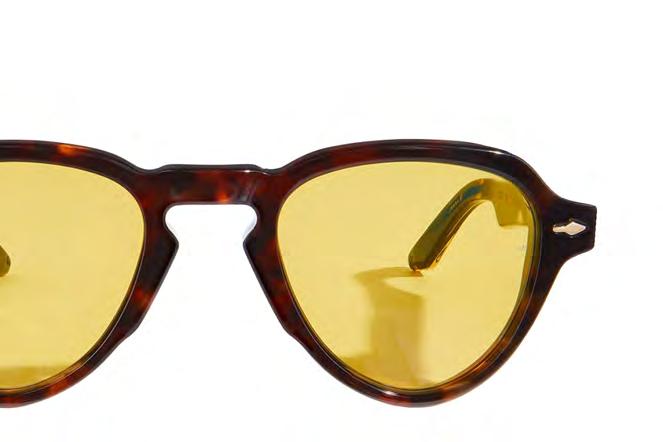
 HATFIELD SUNGLASSES, £640, Jacques Marie Mage, harrods.com
1402 OLD HAVANA SQUARE SUNGLASSES, £385, Cutler and Gross, cutlerandgross.com
£200, Palm Angels, harrods.com
CARY GRANT SUNGLASSES, £310, Oliver Peoples, oliverpeoples.com
Edited by: Richard Brown
HATFIELD SUNGLASSES, £640, Jacques Marie Mage, harrods.com
1402 OLD HAVANA SQUARE SUNGLASSES, £385, Cutler and Gross, cutlerandgross.com
£200, Palm Angels, harrods.com
CARY GRANT SUNGLASSES, £310, Oliver Peoples, oliverpeoples.com
Edited by: Richard Brown
TIME TRAVELLER
Consider yourself an international jet setter? Then you’ll need a rugged, go-anywhere travel watch, preferably something with a 24-hour GMT, world-time or second-time function. These timepieces have been engineered to withstand whatever your globetrotting can throw at them – while keeping you on time wherever you are on the planet...
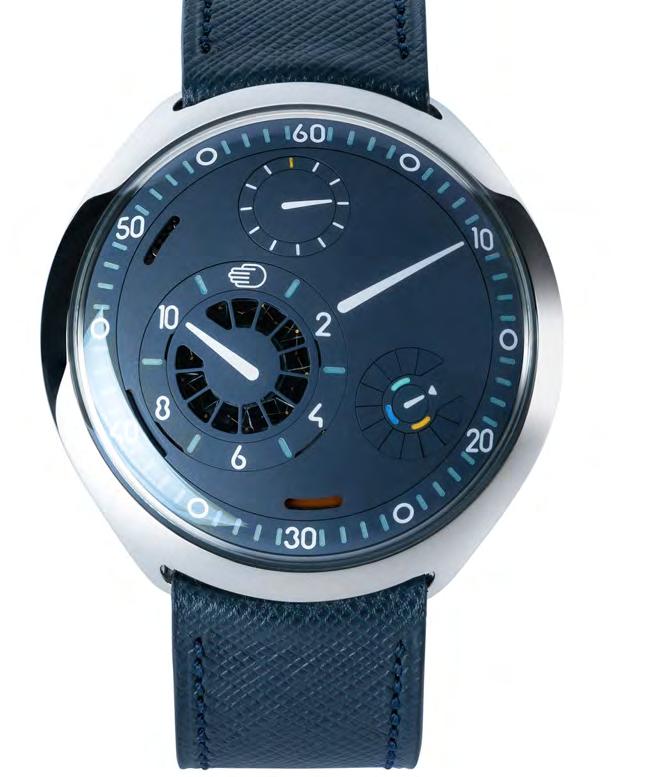



BAMFORD
£1,450, Bamford London, bamfordlondon.com
 L.U.C TIME TRAVELER ONE, £15,200, Chopard, chopard.com
GMT,
TYPE 2 NIGHT BLUE, £41,195, Ressence, ressencewatches.com
BLACK BAY GMT, £3,590, Tudor, tudorwatch.com
L.U.C TIME TRAVELER ONE, £15,200, Chopard, chopard.com
GMT,
TYPE 2 NIGHT BLUE, £41,195, Ressence, ressencewatches.com
BLACK BAY GMT, £3,590, Tudor, tudorwatch.com
CRUISE COLLECTION
 PHOTOGRAPHER SIMON LIPMAN STYLIST SARAH ANN MURRAY
PHOTOGRAPHER SIMON LIPMAN STYLIST SARAH ANN MURRAY
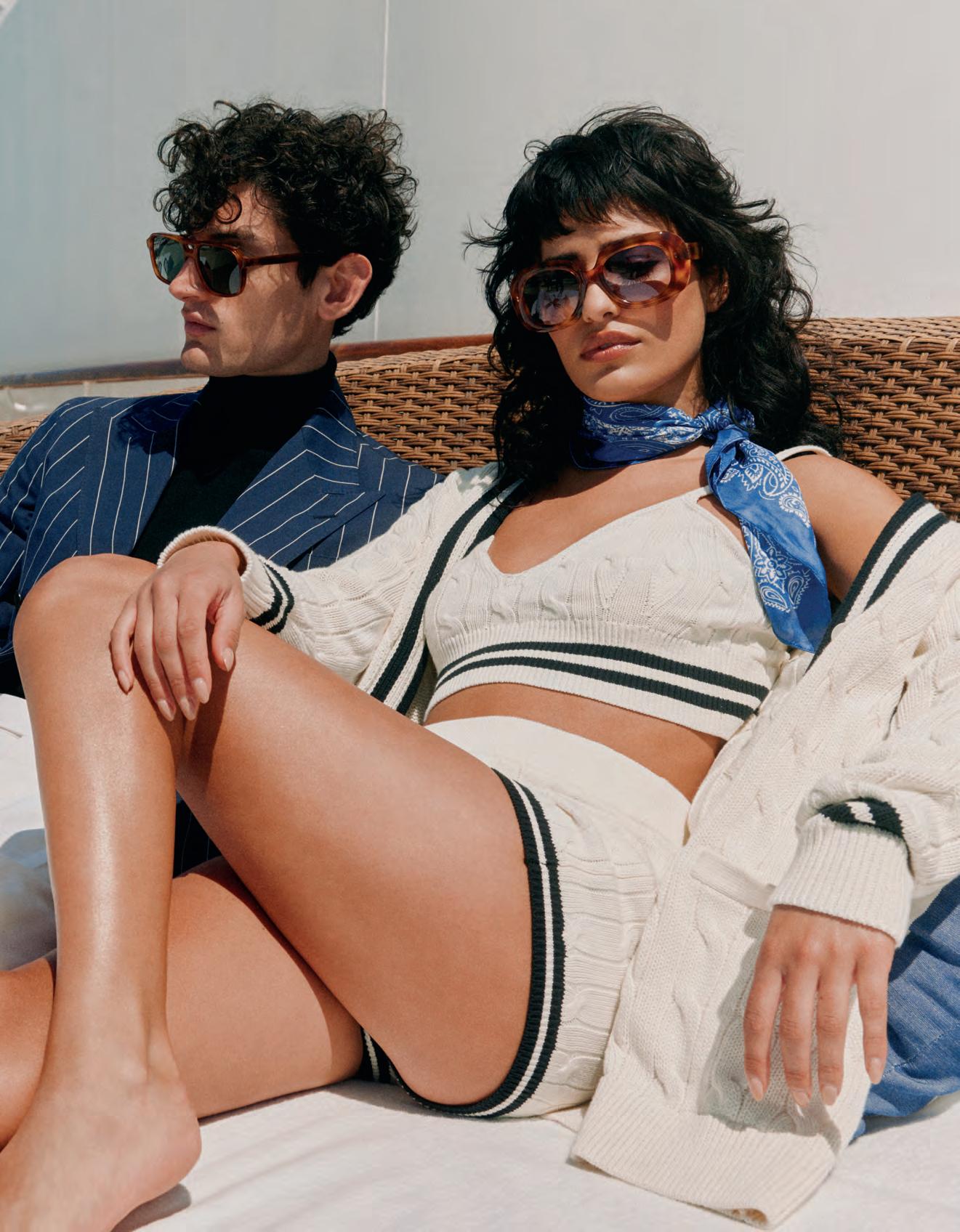
PREVIOUS PAGE
NAOMI WEARS: CRICKET CABLE-KNIT COTTON-BLEND BRALETTE, £179, CRICKET CABLE-KNIT COTTON-BLEND SHORT, £129, BOTH RALPH LAUREN, RALPHLAUREN.CO.UK
9383 OLD HAVANA SUNGLASSES, £385, CUTLER AND GROSS, CUTLERANDGROSS.COM
AARON WEARS: POLO PINSTRIPE WOOL-COTTON SUIT JACKET, £870, CASHMERE ROLL NECK JUMPER, £860, GREGORY HAND-TAILORED SUIT TROUSER, £470, ALL RALPH LAUREN, RALPHLAUREN.CO.UK

1394 OLD HAVANA SUNGLASSES, £385, CUTLER AND GROSS, CUTLERANDGROSS.COM
THIS PAGE
NAOMI WEARS: JUMPSUIT, POA, VALENTINO, VALENTINO.COM
9383 SUNGLASSES IN POWDER BLUE, £385, CUTLER AND GROSS, CUTLERANDGROSS.COM
JUNIPER LOCKET 9K, £950, LOQUET LONDON, LOQUETLONDON.COM
AARON WEARS: MULTICOLOUR COTTON CROCHET JUMPER, £1,150, BLUE VISCOSE JACKET, £1,720, BLUE VISCOSE TROUSERS, £540, ALL FENDI, FENDI.COM; 0001 SUNGLASSES IN 18K ROSE GOLD + 18K RHODIUM 18K WITH BLUE LENSES, £545, CUTLER AND GROSS, CUTLERANDGROSS.COM



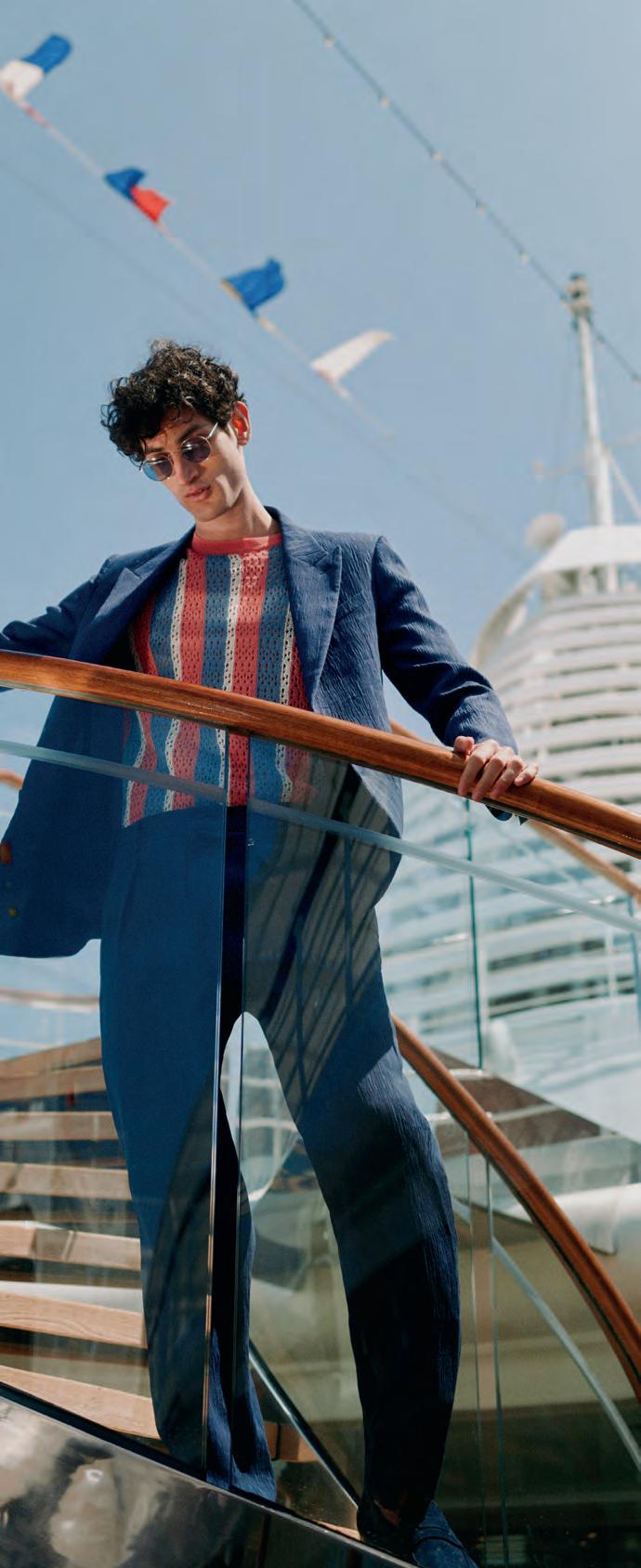

NAOMI WEARS: CRYSTAL-EMBROIDERED SINGLE-BREASTED JACKET, POA, CRYSTAL-EMBROIDERED TROUSERS, POA, BOTH GIORGIO ARMANI, ARMANI.COM
AARON WEARS: BEIGE SUIT IN SILK AND WOOL, POA,SLIM-FIT SHIRT, £295, CANALI, CANALI.COM




NAOMI WEARS: BESPOKE EVENING JACKET AND TROUSERS, POA, HUNTSMAN, HUNTSMANSAVILEROW.COM BUTTERFLY COLLAGE DRESS, £1,380, DION LEE, DIONLEE.COM SLING BACK POINT PUMP, £245, RUSSELL & BROMLEY, RUSSELLANDBROMLEY.CO.UK SCATTER DIAMOND HOOP EARRINGS, £5,300, SCATTER FLOATING PURPLE OMBRÉ RING, £1,200, ANANYA, ANANYA.COM

AARON WEARS: BLACK EVENING JACKET, POA, HUNSTMAN, HUNTSMANSAVILEROW.COM REY SOLID POLO, £150, J.LINDEBERG, JLINDEBERG.COM



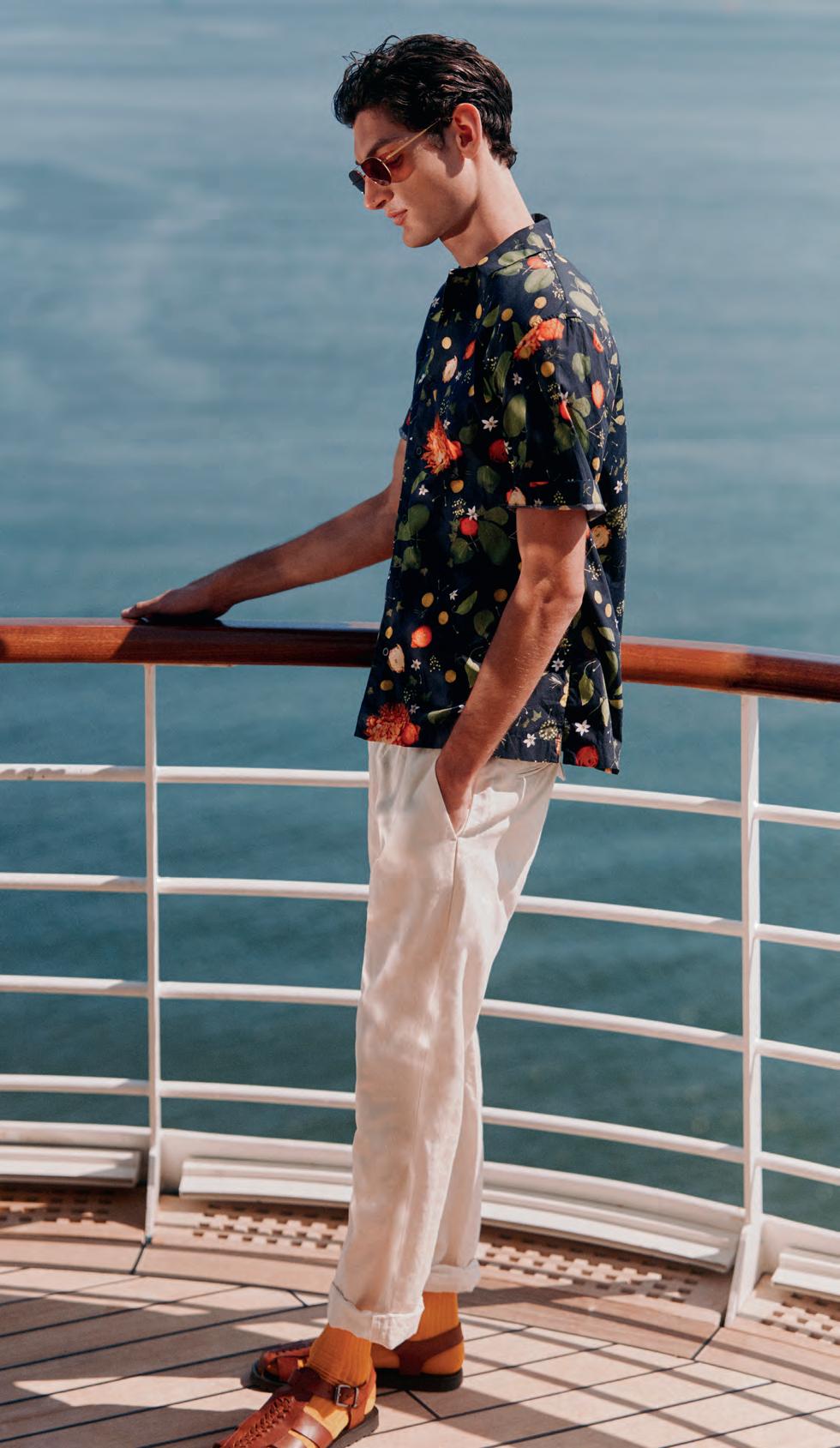
NAOMI WEARS: OCEAN BLACK PIQUE LONG SLEEVE SWIMSUIT, £282, JEMIMA BLACK HAT, £134, MELISSA ODABASH, ODABASH.COM
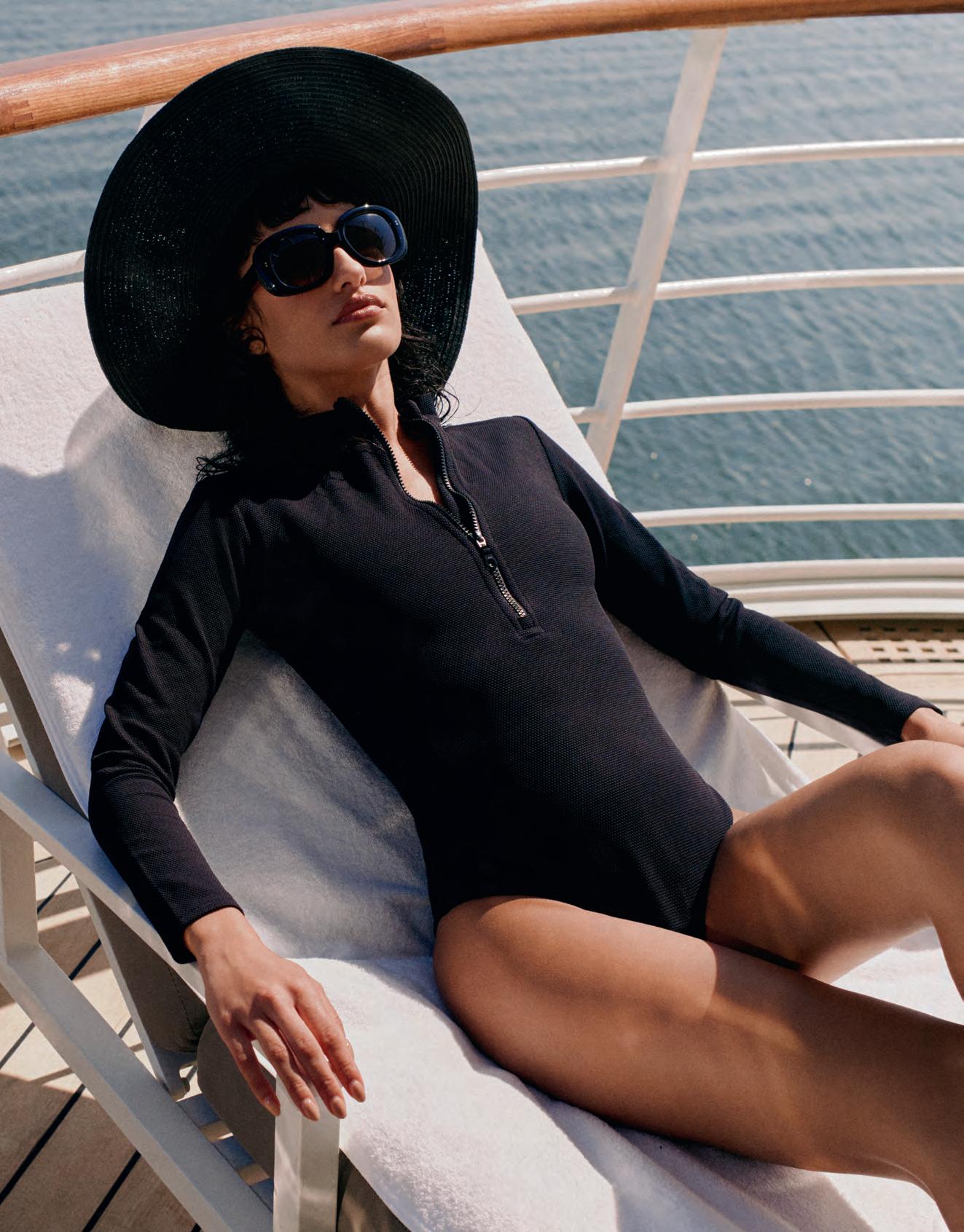
9383 SUNGLASSES IN BLACK, £385, CUTLER AND GROSS, CUTLERANDGROSS.COM
AARON WEARS: SUNSPEL X CHARLOTTE
GOSCH CAMP COLLAR SHIRT, £185, SUNSPEL X PAUL WELLER TROUSERS, £235, SUNSPEL, SUNSPEL.COM
WOVEN DETAIL SLIDER, £195, RUSSELL & BROMLEY, RUSSELLANDBROMLEY.CO.UK
0002 SUNGLASSES IN 18K
GOLD WITH PINK LENSES, £530, CUTLER AND GROSS, CUTLERANDGROSS.COM
SIMPLY SARTORIAL SOCKS, £14, LONDON SOCK CO., LONDONSOCKCOMPANY.COM
NAOMI WEARS:
BLUE BIKINI, £490, BLUE SILK DRESS


£2,350, BLUE DENIM SHORTS, £1,050, ALL FENDI, FENDI.COM
9797 SUNGLASSES IN COLOUR STUDIO
SOLID LIGHT BLUE, £385, CUTLER AND GROSS, CUTLERANDGROSS.COM
AARON WEARS:
MULTICOLOUR SILK SHIRT, £1,320, LIGHT BLUE GABARDINE TROUSERS, £770, BOTH FENDI, FENDI.COM
CLASSIC T-SHIRT, £85, SUNSPEL, SUNSPEL.COM

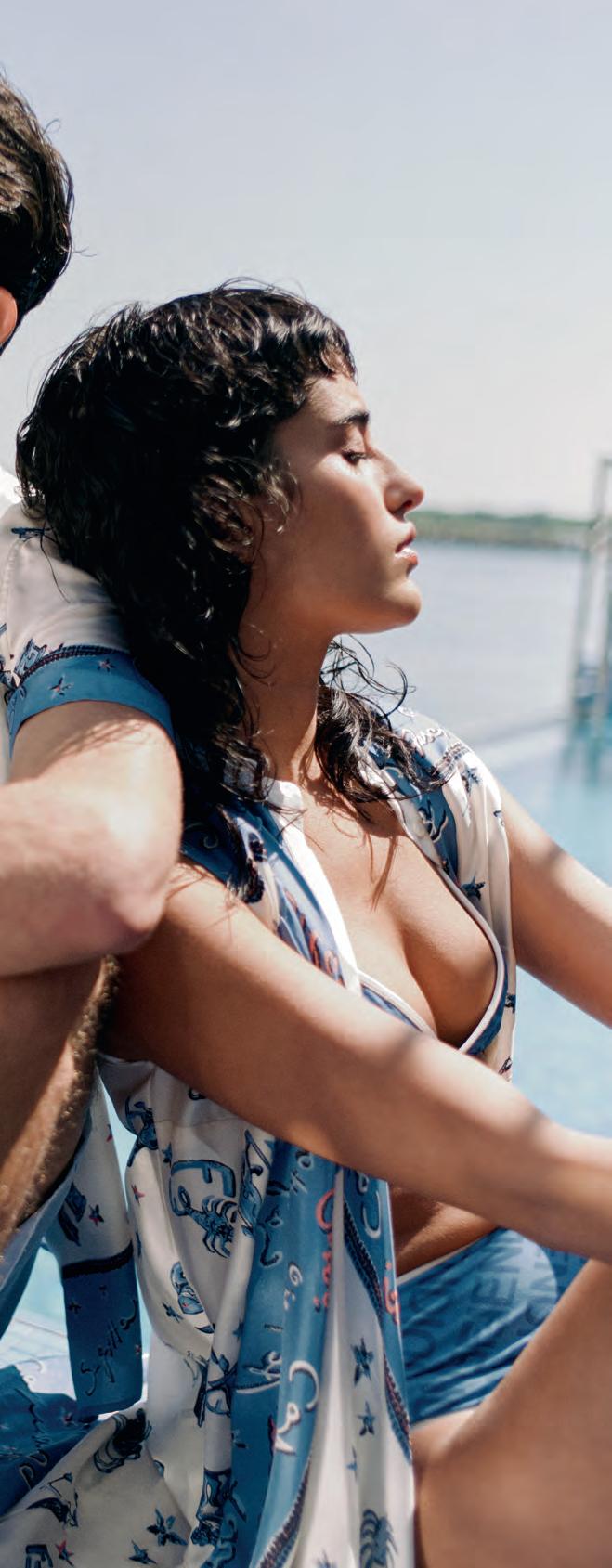


NAOMI WEARS: COLOUR SHADED WOOL PENCIL SKIRT, £745, ETRO, ETRO.COM GRENADA AQUA BIKINI, £128, MELISSA ODABASH, ODABASH.COM ALL JEWELLERY: GOOSSENS



WITH THANKS TO NAOMI E @ BOUNDARY
AARON SHANDEL @ WILHELMINA
ASSISTANT STYLIST
CHANELL CAMPBELL MAKEUP
JULIE ANN READ
HAIR
NATALIE STOKES
MODEL CASTING
EMMA-JANE SOMPER CASTING
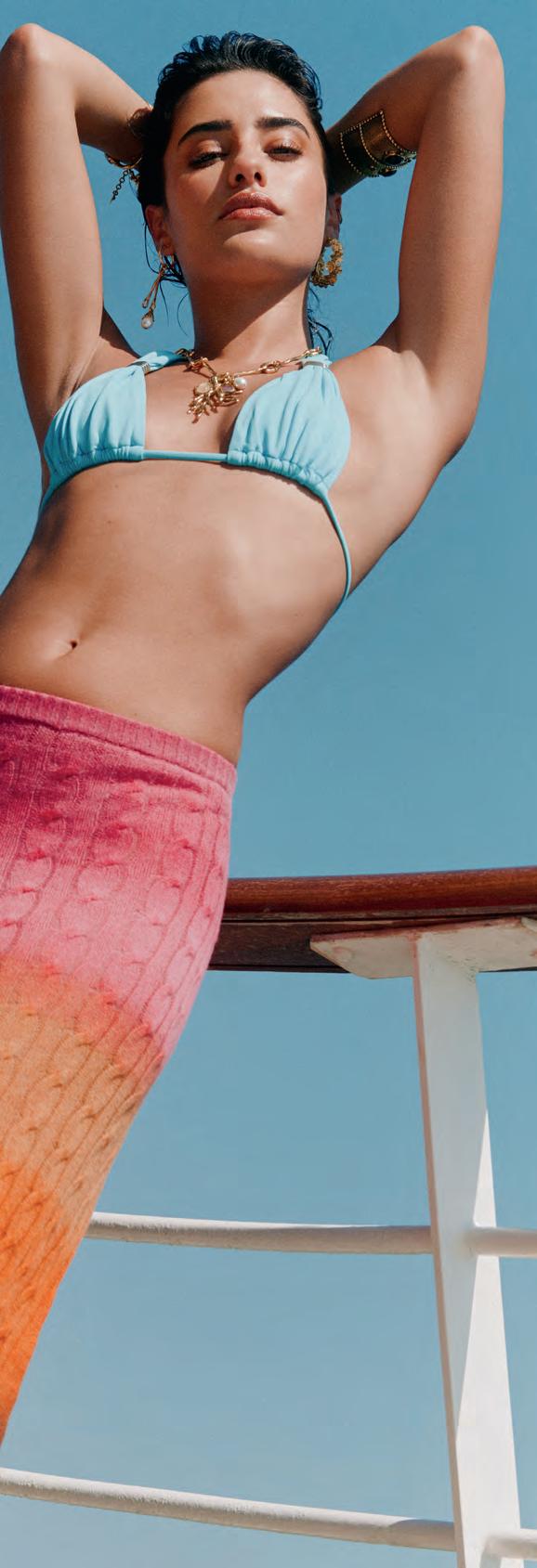
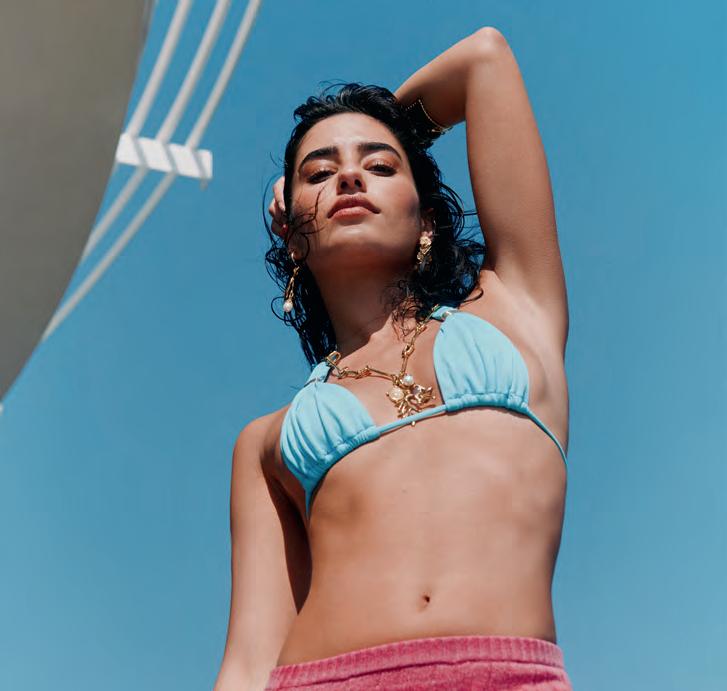

SHOT ON LOCATION
SEVEN SEAS SPLENDOR®, REGENT SEVEN SEAS, RSSC.COM


www.theextensionist.com LONG HAIR
HAIR EXTENSIONS
PROFESSIONAL
HAT TRICK
The days of roasting ourselves under the summer sun are long gone, and good riddance. Now, it’s chic to be safe, which means shade, sunscreen and a hat. The good news is, a fabulous headpiece only enhances a look – pair a canvas bucket or raffia fedora with your kaftan and hit the beach bar, or crown an evening look with a sophisticated wide-brimmed number. Being UV-savvy has never looked better.

 Edited by: Anna Solomon
Edited by: Anna Solomon
KNOTTED
BUCKET HAT


£100, Jacquemus, jacquemus.com
STRIPED
RAFFIA HAT,

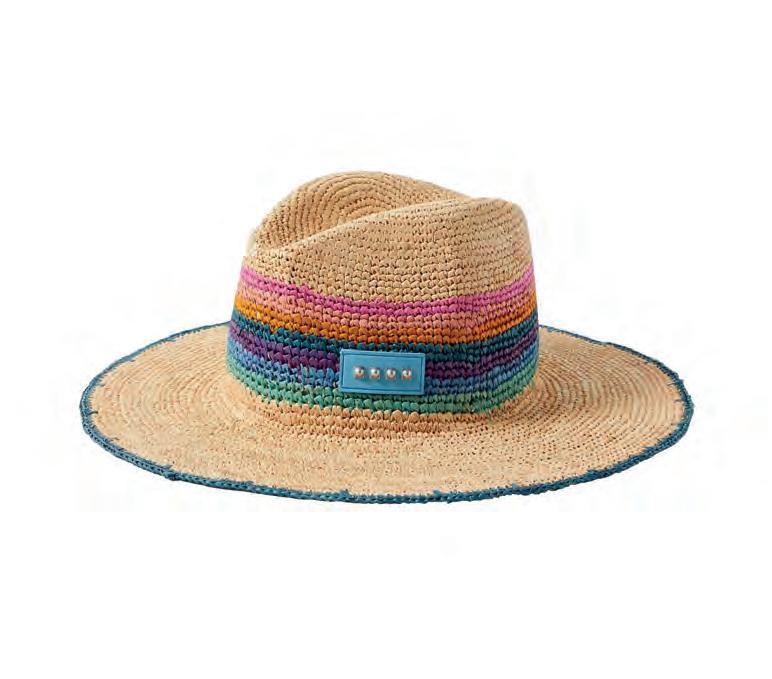
, net-a-porter.com

105 LUXURY LONDON FEATURE LUXURYLONDON.CO.UK
LE BOB FICIU BUCKET HAT £350, Jacquemus, jacquemus.com
LE BOB GADJO
HALEY LOGO HAT £195, Isabel Marant, isabelmarant.com
EMBELLISHED
£365, Etro
GARAVANI PRINTED SILK-TRIMMED STRAW SUNHAT, £740, Valentino, net-a-porter.com
Lack of Color


Bottega

SHOE IN
The holiday footwear canon goes thus: a flip flop is fine for the beach. Inland, upgrade to a gladiator sandal. For al fresco dinners, slip on a mule or strappy heel and then, after dark, whip out the chunky platform sandal. It’s as simple as that.






 Edited by: Anna Solomon
Edited by: Anna Solomon
LUXURY LONDON STYLE LUXURYLONDON.CO.UK
HELOISE 120, £695 Jimmy Choo, jimmychoo.com
COSMIC MULE, £660 Gianvito Rossi, gianvitorossi.com
SOIREE 35 SANDAL, £395 Stuart Weitzman, stuartweitzman.com
ROCKSTUD FLAT CALFSKIN SANDAL, £780, Valentino, valentino.com
GLITZ WEDGE, £325, Russell & Bromley, russellandbromley.co.uk
CANALAZZO SANDAL, £1,080
Veneta, bottegaveneta.com
THEMIS 45, £525 Jimmy Choo, jimmychoo.com
BEACH TOTE MINI, £475 Jimmy Choo, jimmychoo.com


CADIX RAFFIA AND LEATHER BASKET BAG, £425 Isabel Marant, isabelmarant.com

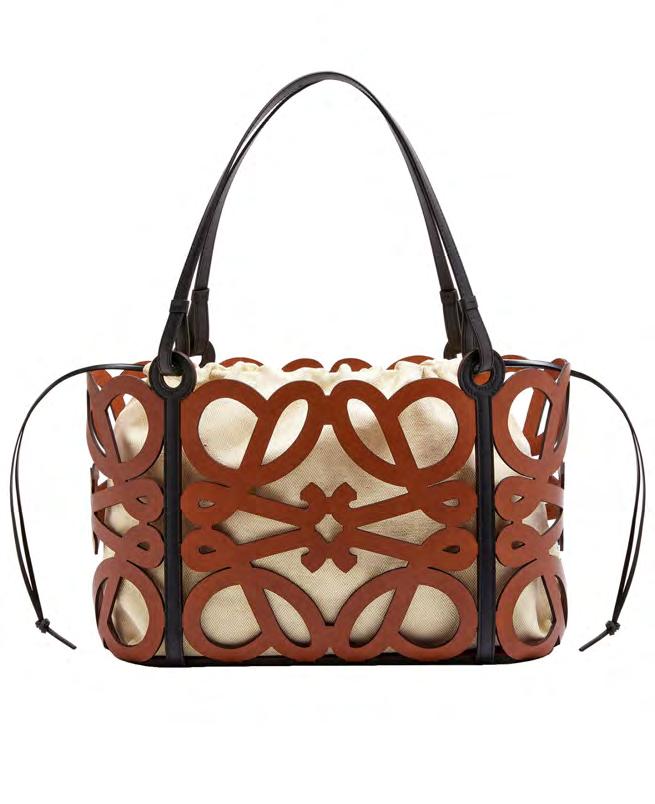
CROCHETED TOTE, £155 Ultraviolhat, net-a-porter.com

ANAGRAM CUT-OUT TOTE IN CALFSKIN, £1,650 Loewe, loewe.com
MINI JODIE, £2,060 Bottega Veneta, bottegaveneta.com
LOTUS FLOWER POCHETTE, £980
Ulla Johnson, ullajohnson.com
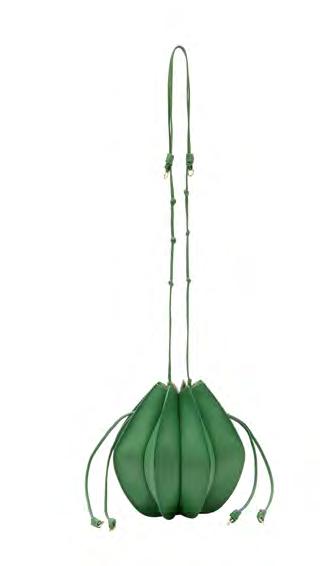
MIXED
BAG
Edited by: Anna Solomon
Summer is the season of the canvas bag, but that’s no excuse to dig out that sun cream-stained tote you’ve had since 2000. The beach bag can be super-chic, and, for when you don’t have towels in tow, a woven bucket bag, cute raffia basket, or beaded mini are perfect for out-of-office moments.

SMALL WOODY BASKET, £510 Chloe, chloe.com
NALA MINI CLUTCH, £410 Cult Gaia, cultgaia.com

ARIZONA RAINBOW
SAPPHIRE FRINGE
NECKLACE, £1,348

JiaJia, jiajiajewelry.com


FREEFORM
TURQUOISE RING, £940 Melissa Joy Manning, melissajoymanning.com
TOURMALINE DOUBLE DROP
EARRINGS, £1,770, Pippa Small, pipppsmall.com

Taking jewellery on a summer holiday can be a delicate balance to strike. The Maldives and Caribbean aren’t necessarily respectors of fine diamonds or high pearls; rather, beach days and balmy nights call for beads and fringes, flora and fauna motifs, and vibrant shades of aquamarine and coral. We’re loving free-flowing, organic shapes this season; gems and stones crafted as though worn by the sea. Surf’s up!

LILIUM EARRINGS, £760 Begum Khan, begumkhan.com

ARIZONA RAINBOW
SAPPHIRE PEARL
BRACELET, £311
JiaJai, jiajiajewelry.com
BEACHY KEEN
Edited by: Anna Solomon
109 LUXURYLONDON.CO.UK
éliou
18KT GOLD PINK
LIFE MELD TOGETHER IN FENDI ASTROLOGY: A CAPSULE COLLECTION CREATED FOR EVERY STAR SIGN

WRITTEN IN THE STARS
THIS SUMMER, CODES BY KIM JONES, ZODIAC SIGN
PRINTS BY KARL LAGERFELD, AND MEDITERRANEAN BEACH
PHOTOGRAPHER COLLIER SCHORR STYLIST
LUXURY LONDON PROMOTION
ELLIE GRACE CUMMING
LEFT BLUE SILK SHIRT, £1,190; BLUE SILK SHORTS, £830; LEATHER PEEKABOO ISEEU SMALL, £4,050


THIS IMAGE MULTICOLOUR SILK REVERSIBLE BOMBER JACKET, £3,100; GOLD-COLOUR PISCES NECKLACE, £470; ONE-PIECE BROWN SWIMSUIT, £450
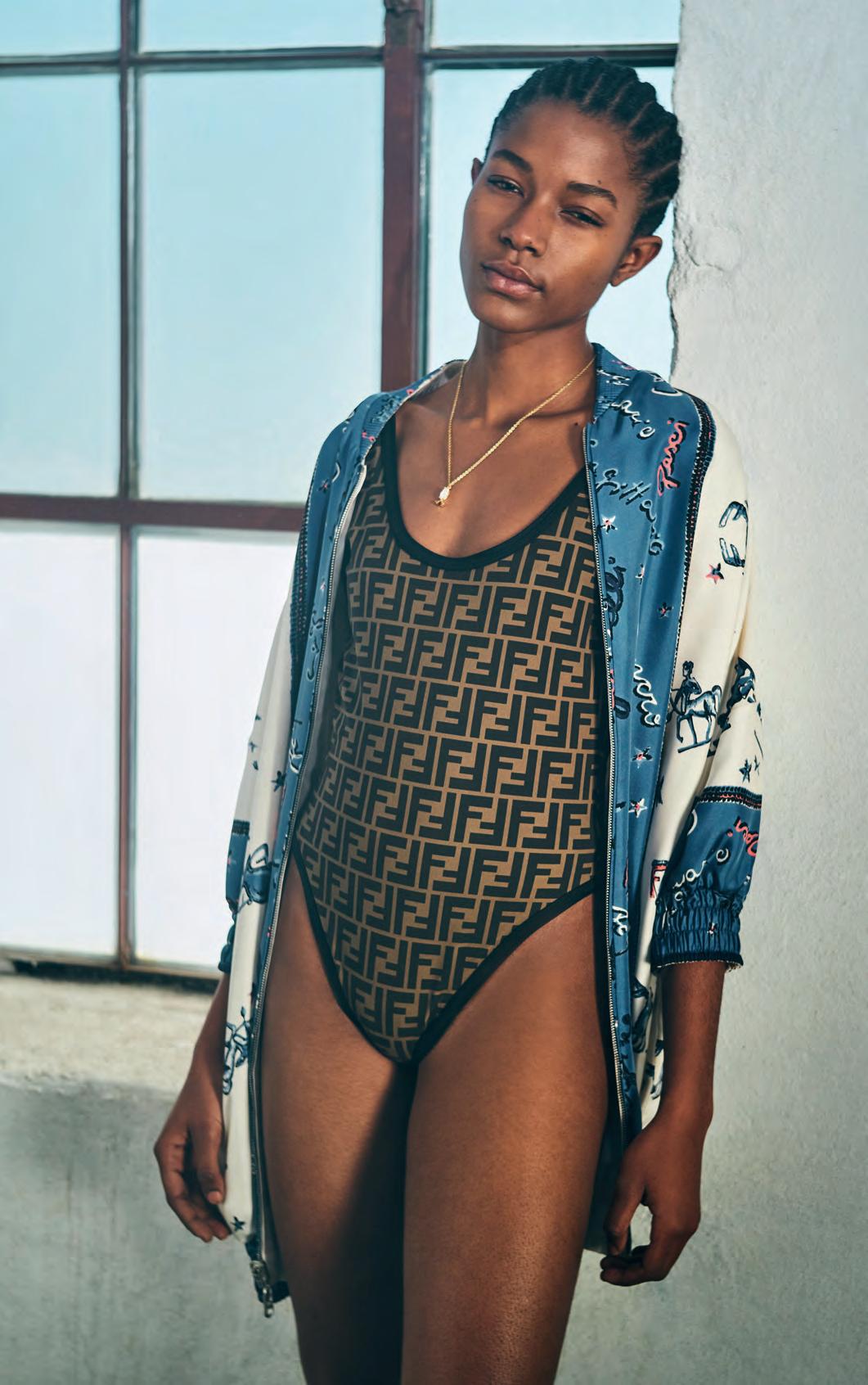
 COTTON DRESS, £2,150; BROWN BIKINI SWIMSUIT, £490; COTTON HAT, £470
COTTON DRESS, £2,150; BROWN BIKINI SWIMSUIT, £490; COTTON HAT, £470

LUXURY LONDON PROMOTION
WOOL DRESS, £3,600
 NATURAL STRAW BAGUETTE BAG WITH FF EMBROIDERY, £2,550; PINK SILK DRESS, £2,250
NATURAL STRAW BAGUETTE BAG WITH FF EMBROIDERY, £2,550; PINK SILK DRESS, £2,250
FENDI CAPSULE SPRING SUMMER 2023

HAIR EVANIE FRAUSTO

MAKE-UP DICK PAGE SET DESIGNER JAVIER IRIGOYEN
CASTING DIRECTOR NICOLA KAST
MODEL ARTA GEE
MODEL COURTNEY BENBOE
MODEL JAC JAGACIAK
MODEL STELLA JONES
MODEL DEDE
MODEL HODY YIM
LOCATION NEW YORK
FENDI, 141 NEW BOND STREET, LONDON W1S 2BS
FENDI.COM
115 LUXURY LONDON PROMOTION LUXURYLONDON.CO.UK
MULTICOLOUR SILK SHIRT, £1,320; PINK SILK TROUSERS, £1,190; FABRIC SLIDES, £830

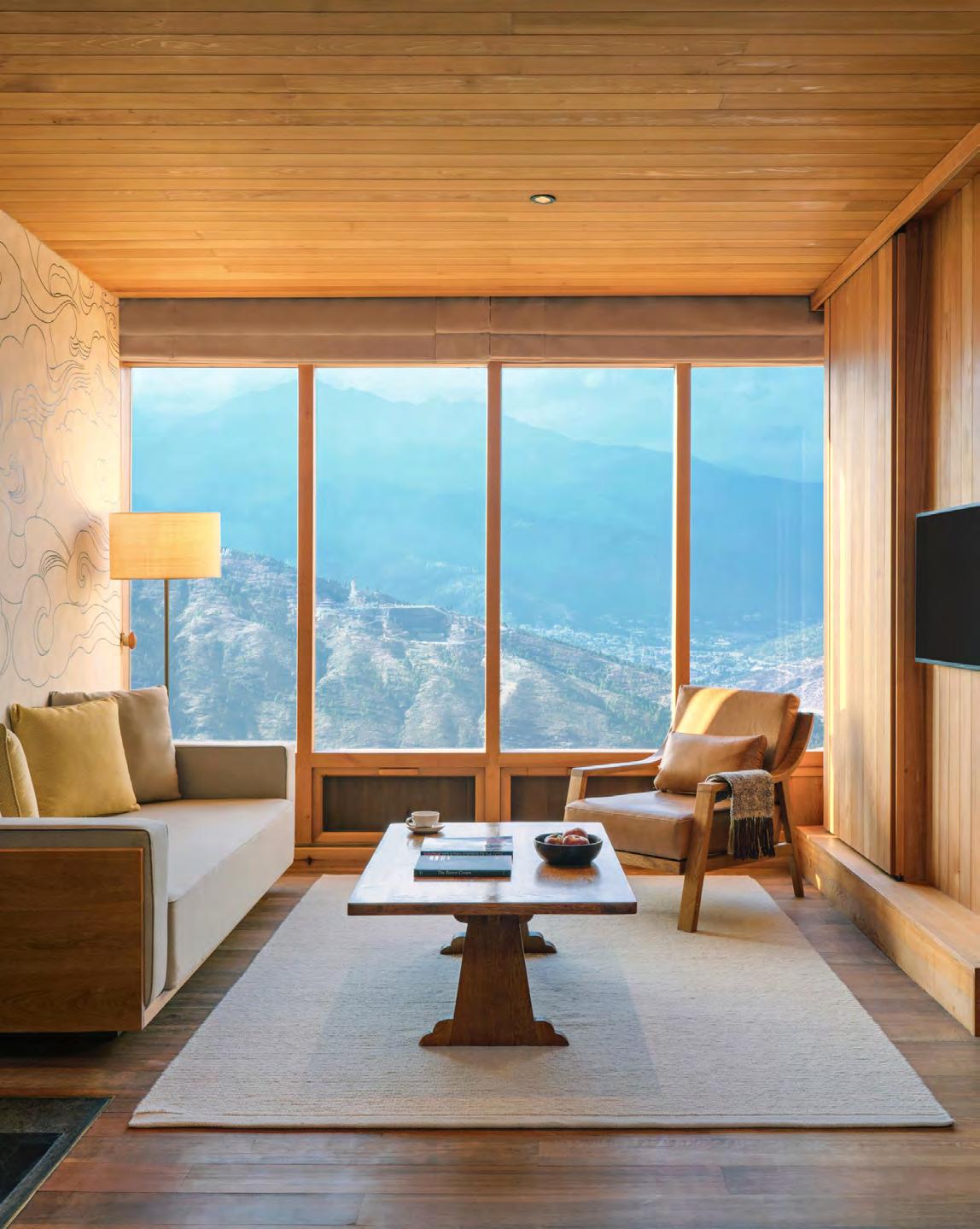

118 Six Senses Bhutan Where time takes on a different meaning 126 Surfing in Bali Chasing waves off the Indonesian island 134 Turkish Delight The resort redefining the full-board break 140 Tranquil Tenerife A one-bedroom hotel is putting your wellbeing first Six Senses’ latest Himalayan hotel intends to uphold the kingdom’s traditional ways of life – and its easy-going attitude to the passing of time, p.118 TO STRIVE, TO SEEK, TO FIND... Escape

SLOWLY
DOESIT
SIX SENSES’ LATEST HIMALAYAN HOTEL INVITES YOU TO CLOCK OFF AND ZONE OUT
Words: Anna Prendergast
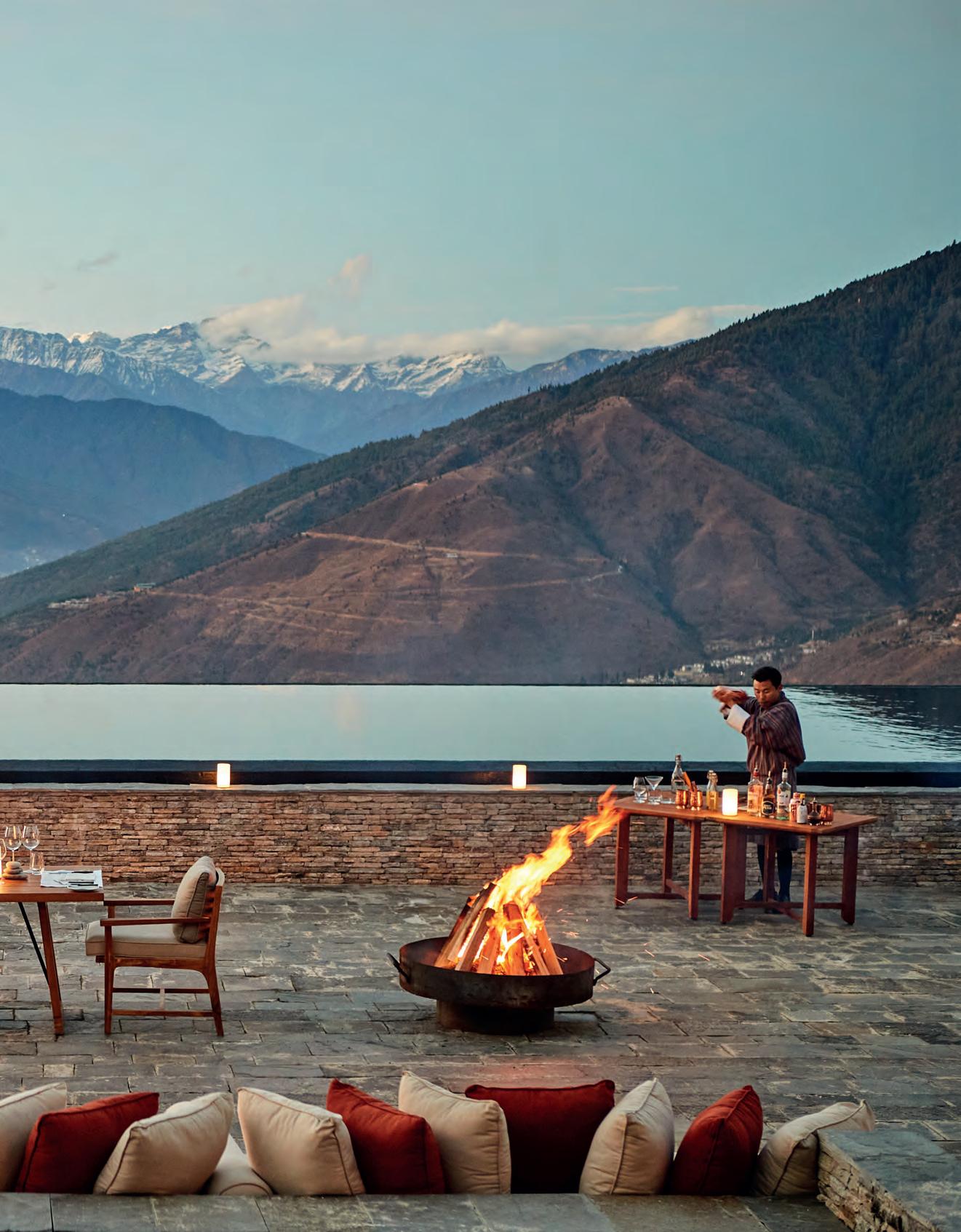

Daily life in Bhutan is measured in rituals. Time does not determine the tempo, but merely ticks by to the rhythm of Buddhist prayers and meditations. Naturally, the country’s interpretation of time is a little more relaxed than elsewhere; our guide for the week, the indispensable Dorji Bidha, jokes that Bhutan should have its own time zone – BST, for ‘Bhutanese Stretched Time’.
Land-locked between India and China, the country’s mountainous terrain, dramatic elevation and ever-changing weather no doubt contribute to this unhurried attitude (try driving fast down a road with nine hair-pin bends and no barriers). But the kingdom has also fiercely – and intentionally –worked to preserve its traditional ways and maintain a peaceful pace of life.
A decade ago, Bhutan introduced a Sustainable Development Fee, or tourist tax, used to fund programmes that offset the carbon footprint of tourism and upskill those in the tourism industry. In 2022, the SDF was increased to $200 (USD) a night in a post-Covid effort to convalesce the tourism industry: around 50,000 jobs were lost during the pandemic. And whilst 315,600 tourists visited in 2019, that number is predicted to drop by some 80 per cent in 2023, which means that the fortunate few that do make the trip really are being handed the keys to the kingdom. Travellers virtually have the place to themselves.
With the full lifting of restrictions in September 2022, the ribbon was cut on a handful of new hotels and hiking trails, including the Trans Bhutan Trail
and Six Senses’ fifth Himalayan lodge in Thimphu, the capital. At 9,000 feet, it’s a peaceful, private place to drop into to scratch the surface of Bhutan’s deeply spiritual, go-slow way of life.

Mornings at the hotel are for resting, but I set an alarm to catch the sunrise. My lodge suite looks out over the zigs and zags of the Thimphu valley, so I take coffee and thick yak-wool blankets onto my balcony to watch as rare arcus clouds roll over the mountains in slow motion, peeling back shadows from the peaks as they go. Sunlight streams through the thalweg and hits the Buddha Dordenma before it reaches anything else, making the enormous hilltop statue’s golden exterior glow.
I’m so engrossed meditating on the mountain views, that I miss an actual meditation led by a local lama in the Prayer Pavilion, which itself appears to levitate above the stillness of the lodge’s reflection pool. By the time I’ve sat down for a breakfast of buckwheat pancakes and fresh juice, I realise the quiet here has been punctuated only once by the gentle, happy bark of a dog. Later, I learn of the friendly Bhutanese mastiff that roams the grounds.
I’m here off-season, during which cold, crisp nights (-5°C) and bright, sunny days (up to 25°C) sharpen the senses like a camera coming into focus. I’m in a small group of five, and we don’t see a single other guest staying at the property. Not great for business, admittedly, but the silence and stillness is liberating.
“Seasons mean nothing here,” the hotel’s executive chef Isa Raku tells me. “It’s a year-round destination, reflected in the ingredients we have access to”. He works closely with local farmers, importing seeds and advising them what to grow.
121 LUXURYLONDON.CO.UK
The kingdom has fiercely –and intentionally –worked to preserve a peaceful pace of life
His focus is hyperlocal, sourcing regional ingredients that have been traditionally overlooked by the upscale food scene here.
“Pure air, rich soil and Himalayan sunlight bring out the flavours of our fruit and vegetables. Our fish comes from the clear waters of our rushing rivers; honey and butter from Bumthang, potatoes and the buckwheat in your breakfast from our own fields in Gangtey.”
For someone who developed his own style at Melbourne’s prolific vegan restaurant, Lona Misa, Raku is well versed in Bhutan’s produce, but his background comes in useful, too – the Bhutanese don’t kill animals as it goes against their Buddhist beliefs. “They’d rather slaughter a cow than a chicken – one life feeds more people. Instead, I actively seek out the distinctive taste of fermented yak cheese from the far north and sapphire berry oil from the south – they help us showcase flavours not found outside this beautiful country.”
This year, Raku has plans to launch a foraging experience for guests. “We’ve lost connection with what we eat,” he explains. “I want them to have the opportunity to collect turnip greens and fiddle head ferns, sea buckthorn berries and chillies and then make a meal with what they find. Before I came here, I didn’t even know what it meant to cook with chillies,” he laughs – here, they’re treated like a vegetable in their own right, rather than a spice.
Raku champions a brand of sustainability embedded in Bhutan’s Buddhist culture, but given the challenge of maintaining authenticity while catering to a five-star crowd, he’s finessed a flair for extracting flavour from simple products and taken his restaurant to the next level. An unassuming charred carrot is one of the most deliciously memorable moments from the trip, perhaps in no small part due to the traditional cham dance and drangyen performance that accompanies it, moving one guest to tears at the table.
In a place where minutes are measured in meditations and seasons don’t correlate to the calendar, it’s important that a fundamental reverence for time-honoured traditions is echoed throughout Six Senses Thimphu. From the handcarved wooden yaks outside each suite (whose heads retreat to signal ‘do not disturb’) to the centuries-old food practices being revived, the lodge celebrates skills cultivated over years, and crops harvested over generations. By honouring these rituals, the Bhutanese way of life has, so far, evaded the tight grip of time. Things might move slowly here, but it’s clear why no one is in a rush to change that.
Carrier offers seven nights from £7,880 per person, including flights and transfers, carrier.co.uk
WHERE (ELSE) TO STAY IN BHUTAN
Six Senses Thimphu is the fairest of them all, but there are four other Six Senses properties dotted along the eastern regions of the Trans Bhutan Trail (Paro, Punakha, Bumthang and Gangtey). They have all adopted the same artisanal approach when it comes to design: a local craftsman travelled to Switzerland to train as a blacksmith before returning to teach his son, who now makes the log burners for the Bumthang property. Artist Tashi Gyeltshen once served drinks in the Gangtey hotel and now provides personalised greetings cards that welcome guests to their suite. Known as the Flying Farmhouse, the Punakha outpost features a spectacular reading room suspended over an infinity pool, while the Paro property is built around ancient stone ruins.
Recent openings by big-hitters COMO and Amankora have also sprung up along the trail, but independent hotels such as Zhiwa Ling Heritage (the country’s only entirely Bhutanese-owned fourstar hotel) in Paro and Terma Linca in Thimphu are vanguards of a burgeoning boutique scene. Bringing the best of both, Gangtey Lodge is a truly special one-off where the sharp edges of cold mornings can be softened with a wake-up call that involves a discreet member of staff lighting your fire and bringing fresh coffee to your bedside.
For those that don’t need five-star amenities every night but still want to experience stellar hospitality, ask your tour operator to book you into a homestay to experience life with a Bhutanese family, where you’ll likely meet several generations under one roof after being welcomed with hot butter tea and popcorn. In Punakha, we stayed with the lovely Lala and Karma, who swooped in to fix our driver’s flat tyre and toasted us with shots of ara – Bhutan is that kind of place.
sixsenses.com; comohotels.com; zhiwalingheritage.com; termalinca.com; gangteylodge.com; aman.com
It’s a place where minutes are measured in meditations and seasons don’t correlate to the calendar

BORN TO BE WILD
 HOW CARRIER BECAME THE FREE-THINKING TOUR OPERATOR THAT PUTS YOUR WISHES FIRST
HOW CARRIER BECAME THE FREE-THINKING TOUR OPERATOR THAT PUTS YOUR WISHES FIRST
LUXURY LONDON PROMOTION
SOUTH AFRICA
THE BROOKDALE ESTATE,
It all started in Africa. Well, technically, it all started in Alderley Edge, a small village in Cheshire. But when specialist tour operator, Carrier, began trading four decades ago, it was to Africa that the company advised its experience-seeking customers to travel.
Way before ‘experiences’ became an industry buzzword, Carrier realised that discerning travellers, and their desires, were evolving. Wellheeled wanderers wanted more. They wanted to expand their knowledge, their understanding, their passions. Carrier invited them to do so, believing that there were few better places to embark on a journey of self-discovery than Africa.
Today, the phrase ‘tailor-made’ is overused. But Carrier has been championing the idea in its purest form – bespoke holidays that deal in detail – from the very beginning. It was never about simply combining a brace of destinations, or throwing in a trio of hotels, it was about listening to customers, gaining a genuine understanding of what they wanted when they travelled, and creating itineraries to fulfil those desires.
Carrier knows that a holiday needs to offer more than a change of scenery. Great holidays enhance our world view, challenge our perspectives, and invite us to connect with communities, individuals, and, most importantly of all, ourselves.
But craftsmanship and bespoke itineraries aren’t things that just happen. They require a great deal of time, effort and creativity. Indeed,
the Carrier team has undertaken more than 70 trips in the past year alone, ensuring that its firsthand knowledge is as up-to-date as possible. Such expertise is essential to creating itineraries that are chock full of life-affirming experiences.
In South Africa, for example, travellers are invited to a homemade and home-grown lunch with chef Nicky Gibbs at her kitchen table, as well as a tour of the winelands with Harry Melck, a member of the prominent winemaker family. In Thailand, families can enjoy a private traditional Thai puppet show at the Baan Silapin Artist’s House, in addition to exclusive cooking classes and a Phuket Old Town tour with renowned Thai Chef Pui.

Over in Hawaii, you can swim side-by-side with graceful sea turtles and tropical fish at the coral reef in Turtle Town, and join an expert local driver-guide who will immerse you in stories of Hawaiian legends and mythology. In California, meanwhile, a resident journalist makes for great company while paddleboarding or cycling down Venice Beach boardwalk, whereas guided boat, bike and historic cable car rides offer an insider insight into San Francisco and Alcatraz Island.
Carrier reaches for the immersive, the authentic and the entertaining, but believes a journey should be one thing above all – thoughtful. Because, at Carrier, it’s all about how they make you feel.
carrier.co.uk
125 LUXURYLONDON.CO.UK
Carrier reaches for the immersive, the authentic and the entertaining, but believes a journey should be one thing above all –thoughtful
GRANITE SUITE AT LONDOLOZI PRIVATE GAME RESERVE
NEW WAVE
IN LITTLE OVER HALF A DECADE, BALI HAS TRANSFORMED ITSELF FROM A SLOW-MOVING PARADISE INTO A POLESTAR FOR WELLNESS SEEKERS, SURF JUNKIES AND BEACH-CLUB WORSHIPPERS. BUT IT WAS COMO UMA CANGGU, A HOTEL ON THE ISLAND’S SOUTHERN SEABOARD, THAT LAID THE FIRST FOUNDATIONS
Words: Nick Savage

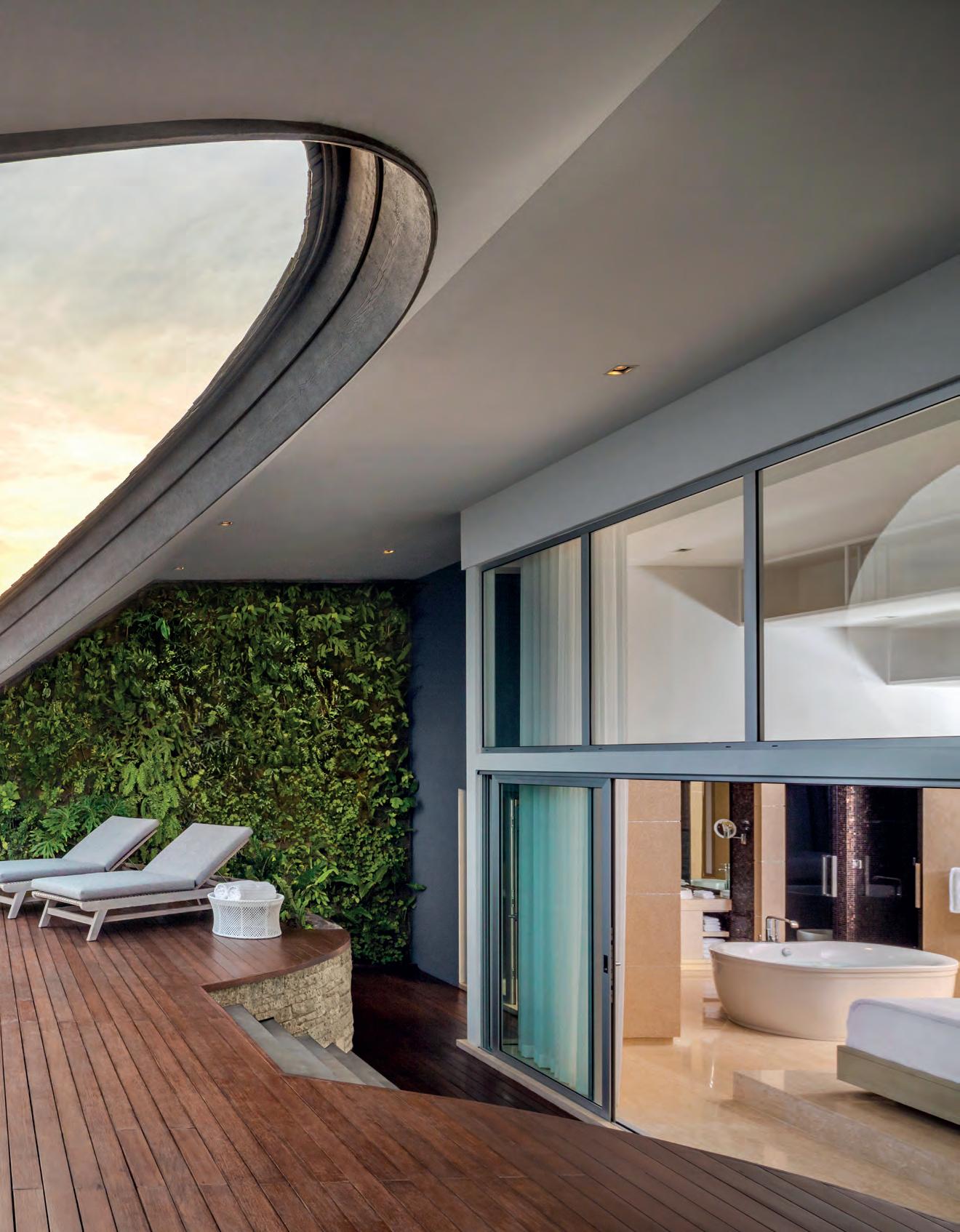

Neighbourhoods evolve at whiplash speed in Bali. The last time I visited the island in 2018, Canggu was still a sleepy surf village to the north of Seminyak, magnetising travellers looking for tranquil vibes, viridian green rice paddies and perfect beaches. Less than five years and a pandemic later and Canggu has experienced a sea change.
Hundreds of restaurants have sprouted along just a few square miles of dusty roads, drawn like the droves of surfers in bygone years to its ramshackle charm. Beach clubs and bars act as flames to Instagram moths; world-beating yoga retreats and vegan eateries ensure that they’re prepped for the camera lens. At the heart of it all is COMO Uma Canggu, the hotel which, in many ways, put the neighbourhood on the international map when it opened its doors in 2018.
Uma Canggu marks the COMO group’s third foray into Bali and highlights its ‘Uma’ concept, which is geared towards adventurous experiences in cultural hotspots. Perched above the volcanic sands of Echo Beach, surf culture is at the heart of the hotel, with a strong thread of chic opulence stitching it together.
Bali’s cultural touchpoints are felt throughout. ‘Mindful movement’ – the practice of reconnecting with one’s body – forms a core component of the COMO Uma Canggu experience. The same applies to the traditional art of Balinese massage, which is practised in the COMO Shambhala Retreat –a wellness sanctuary overlooking the ocean. Plus,
of course, surfing has had an outsized influence on the hotel, which leads the industry when it comes to luxury properties offering coaching.
COMO Uma Canggu’s ultramodern lobby is white-on-white, flanked by two stainless steel pillars. It’s soothing, and a little hypnotic. At a seamless check-in experience, staff members appear, as if from nowhere, to hand us wet towels for the equatorial heat.
‘Low-key luxury’ is a buzz phrase at COMO. The theme pervades a total of 119 tranquil, tonal rooms and suites, surfside residences and penthouses, as well as 12 three-bedroom duplex penthouses with private rooftop pools and personal butlers.
Our one-bedroom residence overlooks an expansive lagoon pool. Sliding screen partitions divide one room from another, including a tidy kitchenette complete with cooker, refrigerator, coffee machine, and an array of snacks. The living room, meanwhile, is equipped with sumptuous sofas and an enormous flat-screen television; the en-suite bathroom is similarly apportioned, with a walk-in rain shower and swooping tub.
The hefty Pacific swells and powder-white sands of Echo Beach are likely COMO’s biggest assets, and ones that are taken advantage of; the hotel runs one of the most popular beach clubs in Canggu. In fact, upon arriving in Bali, a number of expat friends living on the island recommended, unprompted, that we meet there for sundowners. With both indoor seating and al fresco dining, it’s the perfect spot to enjoy coffee in the morning and cocktails as the sun paints the ocean gold before
129 LUXURY LONDON ESCAPE LUXURYLONDON.CO.UK
The hefty Pacific swells and powder-white sands of Echo Beach are likely COMO’s biggest assets, and ones that are taken advantage of
touching down beyond the horizon.
The design here splices South Beach elegance with southeast Asian simplicity. The swimming pool is front and centre, hemmed in by softwood decking and row upon row of sun loungers. Show up early enough and you can nab one of the giant swings that dangle from the building, which can accommodate at least a couple of recumbent bodies. The poolside menu excels in health-forward Balinese cuisine peppered with European influence, such as a quinoa bowl with poached egg, marinated mushrooms, pickles, kimchi, broccoli and sesame –which becomes a breakfast staple.
Evenings are for leaning into local flavours; we’re smitten with the organic beef short ribs in rich rendang curry sauce, accompanied by salak achar (pickled snake fruit) and steamed rice. The excellent tuna sambal matah, meanwhile, sees the fish stung with shallot, a spicy lemongrass sambal and kemangi lemon basil.
Onto those swells. COMO Uma Canggu has partnered with Tropicsurf, a pioneer of ‘luxury surfing’. The company caters to every skill level from the greenhorn to the aficionado, and at its top level can create bespoke five-star travel experiences to catch once-in-a-lifetime waves. I am patently not at that level. In fact, during my visit the waves are a little too gnarly for anyone to surf; thus, I am relegated to the lagoon pool to brush up on the fundamentals.
Push yourself hard enough on the waves and you’ll want to recoup with some self-care at the Shambhala Retreat, which offers an extensive range of treatments drawing from Bali’s millenniaold history of wellness. Caught kitty-corner in an awkward wave? You’ll be in good hands on the massage table. Meanwhile, the traditional Balinese wrap is a godsend for rheumatic conditions, and an all-over deep heat experience and Taksu massage really help to clear the system of aches and pains.
COMO Uma Canggu also offers a plethora of wellness activities to get you healthy and centred, ranging from yoga and Pilates to more high-intensity endeavours like muay thai. There’s also a fitness centre – one of the largest in the area – for when you’ve hit the Beach Club a bit too hard. In spite of my depredations in this department, I actually left COMO a few pounds lighter.
Bali in general, and Canggu in particular, may be in a constant state of flux as an increasing number of digital nomads and expats flock to its friendly shores, but there’s something timeless about COMO Uma Canggu. Its relationship with the water and Echo Beach’s famous waves, the way it draws inspiration from its island setting and local culture, and the pervasive sense of calm offers a wonderful escape from the strife and stress of modern life.

It’s a wave worth catching.
From £190 per night on a B&B basis, comohotels.com
Bali may be in a constant state of flux but there’s something timeless about COMO Uma Canggu


Taste theWorld
WHETHER YOU’RE UTILISING THE FLEET’S COLLECTION OF RESTAURANTS, PARTAKING IN A CHEF-LED COOKING CLASS, OR HEADING ASHORE FOR A CULINARY TOUR, REGENT SEVEN SEAS CRUISES INVITES YOU TO EXPERIENCE THE PLANET THROUGH THE POWER OF TASTE
Nothing enhances travel quite like cuisine – and there are few better opportunities to discover so many new gourmet experiences than while on a cruise. Smells can transport us across the globe in an instant, while new flavours can enshrine special moments in our memories. Understanding the potential of taste to enhance our travels, Regents Seven Seas Cruises aims to take its guests on not just a physical journey, but also on a voyage of epicurean perfection.
More akin to floating five-star hotels than traditional cruise ships, each of the six vessels within the Regent fleet boasts a collection of on-board dining options, offering everything from fine dining to casual, come-as-you-are eating spots. Best of all, the cruise line’s promise of ‘The All-Inclusive Regent Experience’ means that you can choose any dish at any restaurant and you won’t pay a penny extra. The same goes for drinks; the majority of premium wines and major-label spirits are available for no additional cost.
Regent travels to more than 500 ports of call, and, through an extensive programme of on-shore epicurean experiences, ensures that your culinary journey doesn’t have to pause when you step on dry land. Here’s how Regent Seven Seas Cruises is helping its guests savour every single journey…
ON-BOARD DINING
Each of Regent’s six ships has been designed to cater to every culinary whim and every dietary requirement. The flagship restaurant on each ship is the Compass Rose, which boasts a menu that changes daily. Fans of classic French fare will no doubt be drawn to the Chartreuse restaurant, which aims to evoke memories of a chic Parisian fine-dining restaurant.
On-board steakhouse, Prime 7, caters to meat lovers, with cuts of USDA Prime and Dry-Aged beef; while over at atmospheric Pacific Rim, the culinary traditions of Asia are explored within beautiful and intricate surroundings. Chances are that sometimes you’ll want to keep things casual, which is where the buffet-style La Veranda and informal Pool Grill come in.
ON-SHORE EXPERIENCES
Regent Seven Seas Cruises’ shore-side culinary experiences are designed to help you explore historic markets, sample local food, try new drinks, and even have you learn traditional cooking methods. Specially-crafted small-group experiences, some of which are led by the fleet’s own chefs, invite you to discover vibrant food districts, sample world-class restaurants, and gain a new understanding of how culture and culinary traditions collide.
Visitors to the south of France, for example, can choose to partake in a chef-led tour of Nice market followed by a lunch at Chateau Eza near Monte Carlo. At Bilbao, Spain, a trip to a local market will be followed by a tapas lunch back on board. Guests travelling further afield can look forward to a farm expedition in Belize and a bean-to-bar lunch in St. Lucia. There are paella lunches in Valencia; foraging trips in Málaga; volcanic wine tastings in Sicily; and pesto workshops in Portofino.
ON-BOARD EPICUREAN EXPERIENCES
The on-board culinary experience opportunities don’t stop with a visit to one of Regent’s many restaurants. Satisfy your inner gourmand with hands-on cooking classes, demonstrations and kitchen tours. The cruise line’s Regent Enrichment programme helps guests explore their interest in culinary arts, as well as other things, through lessons, guest speakers and other special engagements.
Elsewhere, Epicurean Tasting sessions invite you to expand your palate and explore new wines, spirits and more with the masterful guidance of the company’s sommeliers and mixologists. Of course, there will be times when you’d prefer to dine from the comfort of your own suite, which is why Regent Seven Seas Cruises’ room service team works around the clock.
Given that 98 per cent of the fleet’s suites have their own balconies, you’ll be able to create your own al fresco dining experience. Bon appétit!
rssc.com
133 LUXURY LONDON PROMOTION LUXURYLONDON.CO.UK
A TALE OF TWO RESORTS
THE BARUT HOTEL IN ANTALYA HAS A SECRET. OUT OF EARSHOT OF THE COMMUNAL POOL, A SEQUESTERED COLLECTION OF BRAND NEW VILLAS IS REDEFINING THE FULL-BOARD BREAK – A DIAMOND AMONG STONES
Words: Anna Solomon
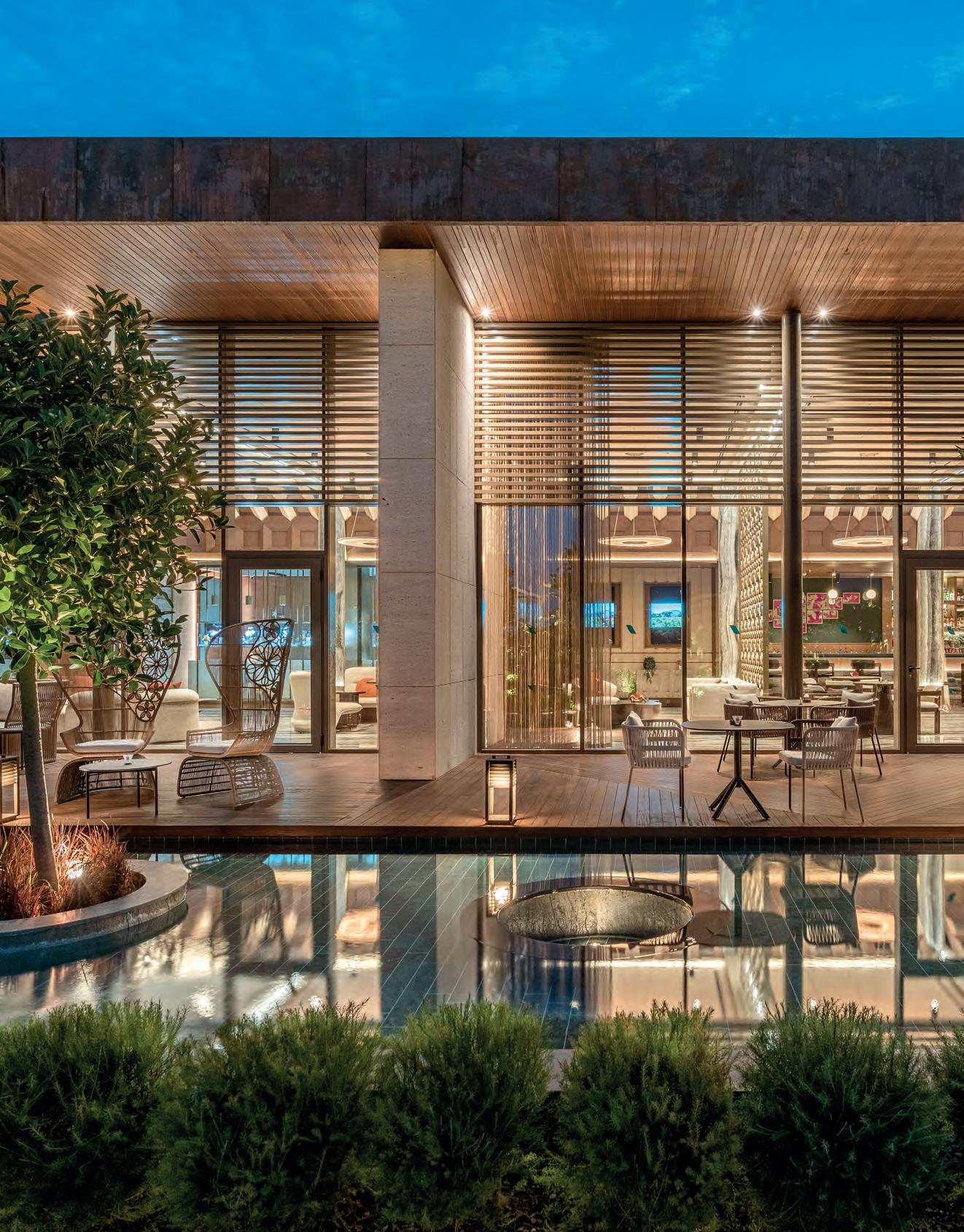
All-inclusive holidays: budget friendly. Hen and stag parties revolving like poolside rotisserie chickens and draining the pre-paid bar. Hyperactive children running around with rubber rings around their waists – dads with pot bellies and sunburn running after them. Oh, and buffets. Buffets everywhere. Every day.
Turkey: also cheap, also cheerful. The lira crashed in 2021 and tourists are taking advantage. Budget airlines are stuffed with Brits, themselves bruised from the cost of living crisis, hoping for some cut-price sunshine in Marmaris or Bodrum.
Bayou Villas, the new accommodation offering from Turkish hotel group Barut Collection: not cheap. Between around £1,200 and £5,500 per night, in fact. Uber-luxury, then, with many villas possessing their own gym and Jacuzzi, for starters. Yes, there’s a buffet, but there are also 10 à la carte restaurants.
This is a Turkish all-inclusive, but not as you know it. In your typical full-board scenario, do you have a choice of standalone villas spanning from a 245 sqm one-bed to a whopping 983 sqm fourbed? How about two personal pools or 24-hour room service? I think not.
The collection opened in November within Barut Collection’s Lara hotel; one of eight ventures owned by Turkish magnate, Ali Barut. He bought his first property back in 1971 in Manavgat, Side, and his two sons, Ahmet and Levent, have now joined the business.

Barut Lara is just outside Antalya, a city of ruins and beaches on Turkey’s Turquoise Coast. There’s a tempo – a vibrancy – to Antalya. A man with an enormous stack of simit (pretzel-y, bagel-y things) balancing on his head strides by. Others keep tiny, toy-like bunny rabbits and charge tourists for photos. Sit down with a Turkish coffee and some baklava and you can people-watch for hours.
You enter the bazaar-style Old Town through Hadrian’s Gate, a triumphal arch built for the eponymous Roman emperor in the year 130. It’s been standing for nearly 2,000 years, but there are no railings or barricades in sight – street dogs lounge on the ancient stones, smoothed by a million feet. Here, pretty courtyards are sequestered behind walls draped with colourful carpets and evil-eye trinkets, which are flogged to tourists. The hazy outlines of
LUXURY LONDON PROMOTION LUXURYLONDON.CO.UK
snow-capped mountains rise from the sea like the distant dwellings of ancient Anatolian gods.
Barut Lara is a 20-minute drive from Antalya, and a world of its own. As I drive through the barrier arms, terracotta-scorched brush gives way to well-watered, manicured lawns. The hotel, where the regular guests stay, rises up in the distance like a big, white spaceship.
Bayou Villas are separate, and something shifts when you move to this part of the complex. Although the villas are new, and super-modern, they successfully capture an old-world Mediterranean vibe, made with sandy, rough-hewn bricks and surrounded by an abundance of regional planting, including thin cypresses, heady lavender, and bleached olive trees. The sound of running water is never far away.
My one-bedroom villa is one of the most ‘modest’ of the collection. It’s cavernous, though, replicating the stone and taupe colourscape of the Mediterranean mise-en-scène outside. It’s stylish, with sculptural light fixtures and art – lots of art. This is a major part of the Bayou Villas proposition; the hotel has commissioned local artists to decorate the collection, from a giant, deconstructed face on the side of the reception building to dreamy, pastel scenes in living spaces. Expansive, sun-dappled terraces boast a heated salt-water pool, as well as access to a unique interconnected pool network that snakes between villas – the five-star answer to a stream at the end of the garden.
The larger villas, as mentioned, have all manner of mod-cons. A warmly-lit massage room, a subterranean sauna and hammam, a fitness suite. The four-bed option houses a white grand piano and is so large that it begins to feel like an upscale shopping mall, with its abundance of shiny marble and an elevator to all floors.
As a villa guest, you have exclusive privileges. Weik restaurant, a wood-clad space adorned with art, including Turkish ‘tufting’, is only for such patrons. I have a fantastic walnut, blue cheese,

pear and radicchio salad here, followed by flaking seabass and a pumpkin cheesecake.
Those staying at Bayou Villas are also privy to an enhanced beach experience – canopied in grassroofed cabanas with sink-in seating. The staff bring you condensation-covered coolers of rosé and helpings of iskender – like your standard döner but way better, topped with tomato sauce, melted sheep’s milk butter and yoghurt, and enjoyed on a beautiful beachfront rather than a kebab joint on Kingsland Road at one o’clock in the morning.
If it’s traditional Turkish food you’re after, also head to Tirmis restaurant, named for the common Turkish snack of lupin beans. It’s here that we get our meze – a Jackson Pollock painting of colour and textures. There are the yellow beans, and creamy hibe (an appetiser made of sesame paste, lemon, garlic, and spices) topped with jewel-like pomegranate seeds. Flame-coloured courgette flowers are stuffed with rice and served alongside cushiony pide (flatbread) and cake-like focaccia. Flavours of orange and olives and dill and toasted nuts dance on the tongue.
Walking around Barut Lara feels like being stuck between two worlds, because the hotel is there and you do catch glimpses of what you’d more traditionally associate with a Turkish all-inclusive. The gigantic, plastic-fantastic waterslide, for one, is pretty hard to ignore. The communal central pool is family-friendly. And yes, there is a buffet: I broach it for breakfast one morning, discovering a cornucopia of delicacies from cheeses and stuffed vine leaves to sugar-dusted Turkish delight, a patisserie, and fry-up fare.
But this just throws into sharper relief the level of opulence provided by the villa collection, which wouldn’t be out of place in Bali or even the Maldives. This is no rookie operation: Bayou Villas prove that the Turkish know how to do luxury. It won’t be long before the world’s HNWIs catch on.
From approx. £1,200 per night, bayouvillas.com
The hazy outlines of snow-capped mountains rise from the sea like the distant dwellings of ancient Anatolian gods

FLY AWAY
PLAN YOUR DREAM HOLIDAY TO THE MALDIVES WITH QATAR AIRWAYS – A WORLD OF CRYSTAL CLEAR WATERS AND ENDLESS SKIES HAS NEVER BEEN CLOSER

The Maldives needs no introduction. This gorgeous archipelago in the Indian Ocean is the epitome of luxurious island paradise: powder-soft sandy beaches, balmy waters teeming with vibrant coral and aquatic life, and five-star hotels where no request is too taxing.

Reachable only by sea plane or speed boat, each Maldivian island is its own self-contained heaven – quiet, private, blissful. There’s a reason the Maldives has long been one of the world’s most popular honeymoon destinations. Whether you’re a newlywed looking to temporarily cut off from the real world, or in search of a family adventure filled with excitement and new discoveries, there’s a Maldivian island waiting for you. And, thanks to Qatar Airways, it’s never been easier to get there.
A multi-award winning airline, Qatar Airways runs plenty of weekly flights to the Maldivian capital, Malé, via Doha’s Hamad International Airport, which was recently awarded Best Airport in the Middle East. This means that, whether it’s a short jaunt or a long
stay, there’s always a flight to suit your schedule.
Unforgettable memories are guaranteed once you arrive in the Maldives, but Qatar Airways believes the journey should be as much a part of your holiday as the destination itself. With this in mind, from Economy to First Class, you can rest assured that you’ll find top-notch service and high-quality amenities on every Qatar Airways flight. Long-haul journeys have never been so comfortable.
But don’t just take our word for it: Qatar Airways boasts Skytrax five-star ratings for quality. In fact, it’s the only global carrier to hold these accolades for both the airline and its hub airport. It also promises flexibility on all of its fares, so you can book in advance with total peace of mind. Additionally, you can sign up for Qatar Airway’s Privilege Club to earn Avios points with every booking.
All of which begs the question: what are you waiting for? The enchanting world of the Maldives is ready and waiting to be discovered – and Qatar Airways is the airline to get you there. Happy travels.
Visit qatarairways.com to book now
PEACE
OUT
IN THE SUBTROPICAL VALLEYS OF TENERIFE, A ONE-BEDROOM, BACK-TO-BASICS HOTEL IS AIMING TO RESTORE YOUR BODY AND RENEW YOUR MIND
Words: Alexander Mark Jones


IMAGE COURTESY OF TILL WERNER
t EcoHotel El Agua, a health-focused eco-hotel where rough textures and earthy colours dominate, you have to order your lunch by 1pm the previous day. There are three types of food from which to choose. Vegan, of which you’ve heard. Raw vegan, which, for the uninitiated, means vegetables and plant-based ingredients that, to protect their molecular chain (and therefore their nutritional goodness), have been cooked at temperatures below 41°C. And then there’s plain old vegetarian, which, at EcoHotel El Agua, includes organic eggs, sustainable honey, fresh fish and local cheese. You order by filling out a long form.
Twenty-four hours later, hey presto: a plate of food that not only tastes delightful but has been engineered to boost your energy levels, improve your immune system and make you an all-round happier person. A healthy diet, goes the thinking, will not only improve your physical wellbeing, but your mental health, too.
Nothing on the menu at EcoHotel El Agua will have been treated with pesticides, chemicals or additives; nothing will arrive wrapped in plastic. Instead, everything is organic, seasonal and sourced from as close to the hotel as possible. Such is the laser-sharp focus and science-based commitment of the property to use food to balance both your mind and body, that El Agua will advise you not only on what to eat, but when to eat, and what to eat with what. Hell, the staff even tell you how to chew. I kid you not.
You’ll find EcoHotel El Agua in the sub-tropical valleys of southern Tenerife, close to the centre of the historic village of Arico el Nuevo. Between volcano and ocean. It’s a 45-minute drive from the airport: a drive that hugs the island’s eastern coast, offering views of the Atlantic Ocean and Gran Canaria in the distance.
The hotel is the vision of Anthony Picq, who, having spent 25 years in the sustainable tourism sector, flitting between Tenerife and Barcelona, opened EcoHotel El Agua in September 2022. A former athlete-turned-ecological-farmerturned-holistic-health-hotelier, it’s fair to say that Picq practises what he preaches. A trained hygienist and naturopath (someone who can advise on natural therapies, like herbal medicine, acupuncture and homeopathy, in case you didn’t know), as well as a learned phytotherapist (someone that aims to improve your health through plants and herbs), many of the treatments – and much of the menu – at El Agua are the invention of Picq. Get him started on any number of wellbeing subjects – from ecology, to spirituality, to anthroposophical, to integrative medicine – and prepare yourself to be schooled.
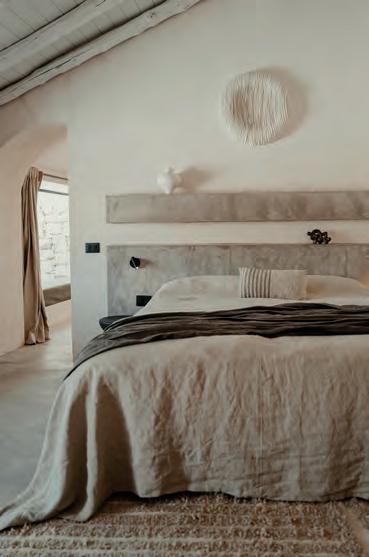
Picq’s other passion, as will become blindingly obvious to anyone who visits EcoHotel El Agua, is design. Picq has previously worked as an interior stylist and garden designer. It shows. For the moment, the property incorporates just a single, two-person room – Villa Olivo (there is boutique. And then there is EcoHotel El Agua). The stone villa – built some 200
years ago to accommodate peasant winemakers and surrounded by olive trees – has been transformed into something from the deserts of Tatooine, with significantly more water features.
Inside, it’s all sand and stone and stylish microcement. Minimalist, Japanese, Scandi, Star Wars-y. Outside, there is a private terrace, a Jacuzzi, and a heated saltwater infinity pool. It’s all very chic. You won’t see another soul.
As well as the focus on healthy eating, there’s also an emphasis on healthy living. The hotel offers four wellness programmes, each designed to have you leaving Tenerife a better version of the person who arrived. Choose Detoxification & Regeneration, for example, and you can expect a programme that includes intermittent fasting, a menu of raw and revitalizing foods and juices, and one massage for every day of your visit. Elsewhere, the Water for Health programme incorporates daily breathing exercises, cold baths, hydrotherapy sessions and lymphatic drainage. The Asanas programme is based on yoga activities,

You’ve never stayed at a place like EcoHotel El Agua, of that we can assure you
© TILL WERNER
A
and includes mat Pilates, meditation, breathing exercises and art therapy sessions.
For anyone looking for something a little more energetic, there’s the Personal Training and Weight Control curriculum. Each day of your stay you’ll be invited to take part in a sporting activity – running, cycling, swimming – or a fitness class. Massages are included, as is nutritional advice.
You may have visited various wellness retreats before. You may be partial to the occasional spa break. Heck, ‘mindfulness’ may be your middle name. But you’ve never stayed at a place like EcoHotel El Agua, of that we can assure you. It’s an extraordinary place. It will change you, in ways you may not have expected.
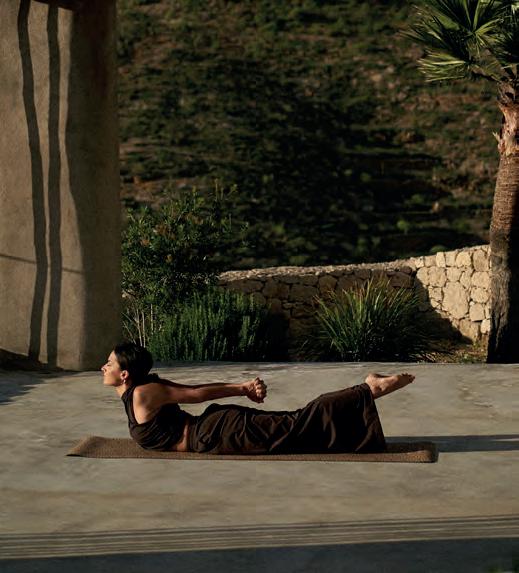
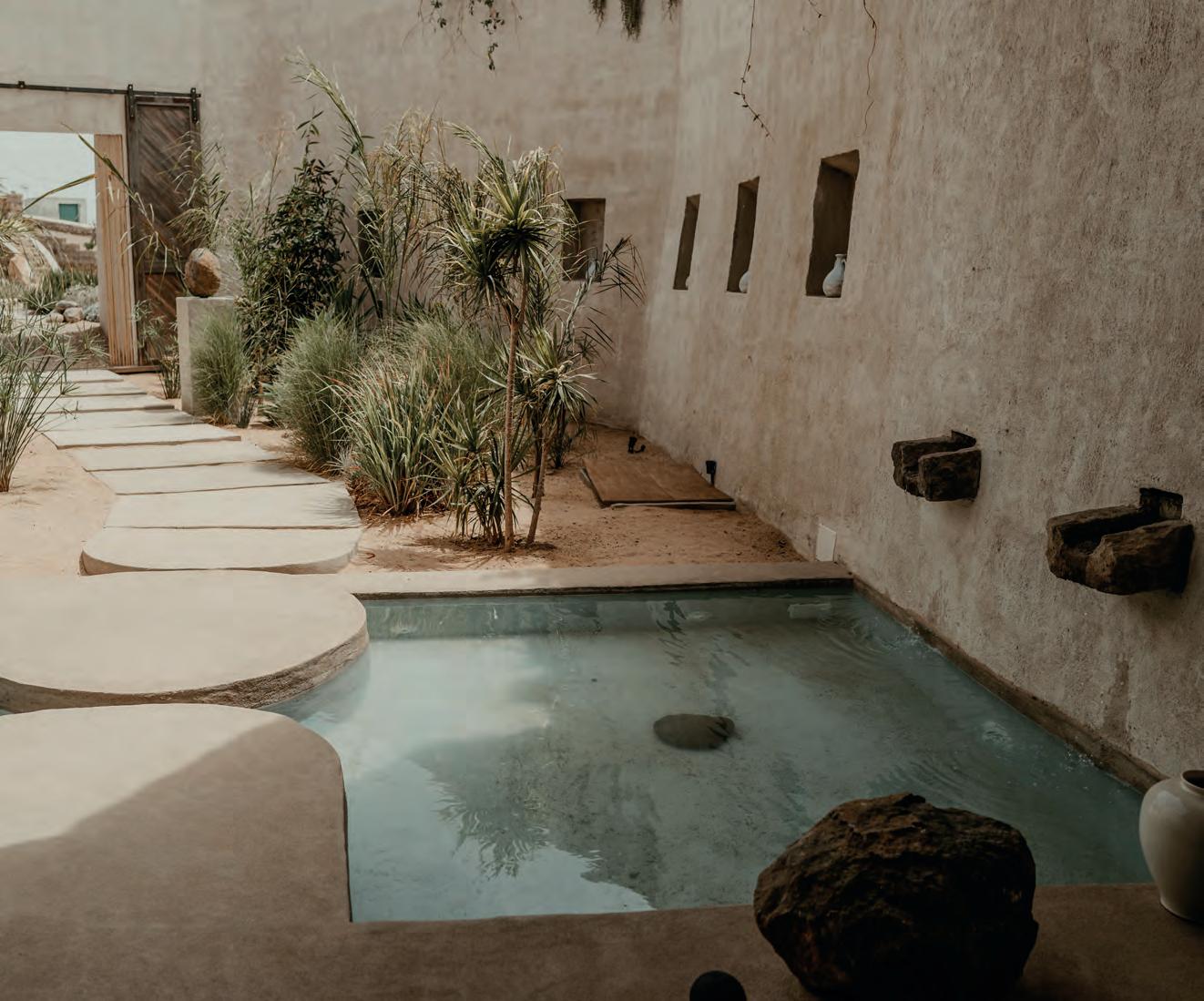
You might not take yourself too seriously. Luckily for you, El Agua does.
From €290 per night, ecohotelelagua.com
© TILL WERNER
© VIVIAN BELLIDO

HOT PROPERTY
8 Eaton Lane, SW1
While any heritage conversion in prime central London tends to stir up a certain amount of intrigue, few developments of recent years have commanded quite the attention, or generated just as much anticipation, as 8 Eaton Lane. Perhaps that should be of little surprise, given that the building is part of the original Grosvenor Estate – with a history dating back to 1677 – and represents one of the last remaining parts of that estate to be fully restored.
Tracing a line back to the 17th century, the Grosvenor Estate was the product of the marriage of heiress Mary Davies to Sir Thomas Grosvenor. Davies had inherited the manor of Ebury – 500 acres of land west of the City of London. From the 1720s, the Grosvenors began developing the northern part of the estate, now known as Mayfair. A few generations later, the family’s focus moved south, to what is now Belgravia, creating Chester Square and a host of other famous addresses, among them Eaton Square.
The building at number 8, now Grade II* listed, dates back to 1863, when it was commissioned by the Marquess of Grosvenor to be London’s first-ever serviced apartment building, opening as Belgrave Mansions. It’s a beautiful structure, reminiscent of the grand European mansion houses of the 19th century. The architect, Thomas Cundy III, who was a close friend of Thomas Cubitt, ‘the builder of Belgravia’, drew inspiration from the Parisian styles of the French Second Empire, including details such as roof mansards, stone dressing and ‘oeil-de-boeuf’ windows. A key part of the development of 8 Eaton Lane includes fully restoring the original façade.
In 1921, the building was reimagined as the Belgrave Hotel, before becoming Grosvenor Gardens House offices in the 1930s. Now, it’s going back to its residential roots, expected to complete in 2024 as a collection of 42 residences and seven retail units.
Homes at 8 Eaton Lane, some of which enjoy views towards Buckingham Palace, will range from one-bedroom apartments to five-bedroom penthouses with interiors designed by Millier London, which is in the process of creating spaces that marry French Renaissance detailing with classically British sensibility.
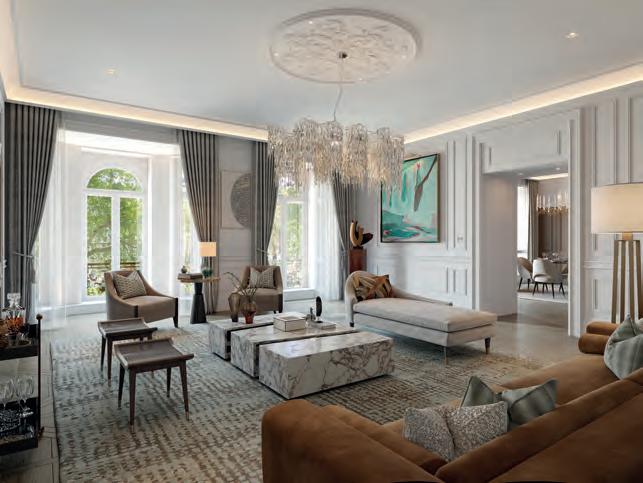
Think marble flooring, fluted craftwork and freestanding baths in a palette of oak and limestone.
Inspired by the grandeur and proportions of the building’s distinguished history, ceilings reach heights of to 3.2 metres, while owners will also enjoy access to a 16-metre swimming pool, gym, spa treatment rooms, cinema and a business suite.
Developed by private equity group CIT, which was widely applauded for recently spearheading London’s only Grade-I* listed ‘new build’ – Regent’s Crescent in Marylebone. Given the success of that project, you can expect similar levels of demand for the new homes at 8 Eaton Lane. Indeed, 40 per cent of the residences have already sold – a sign that the property savvy know just how rare a development like this is.
Two-bedroom residences at 8 Eaton Lane start from £4.13 million. For more information please contact Mems Kannides at mems.kannides@savills.com or on +44 (0) 7815 027 286, savills.com
145 LUXURY LONDON PROMOTION LUXURYLONDON.CO.UK
A HERITAGE CONVERSION IN BELGRAVIA IS OFFERING BUYERS THE CHANCE TO OWN A PIECE OF LONDON HISTORY
BEHIND the SCENES
THE INSIDE STORY OF THIS ISSUE’S RESORTWEAR-THEMED FASHION SHOOT
Words: Richard Brown
Take a stab at where we shot this issue’s fashion shoot. Lisbon? Miami? Some sun-kissed island in the Caribbean? Rio de Janeiro? Nope – although Regent Seven Seas Splendor®, the cruise ship we teamed up with to provide some style inspiration for your summer ahead, does sail to all those places. For this issue’s fashion shoot we travelled all the way to, er, Southampton. And didn’t we get lucky?
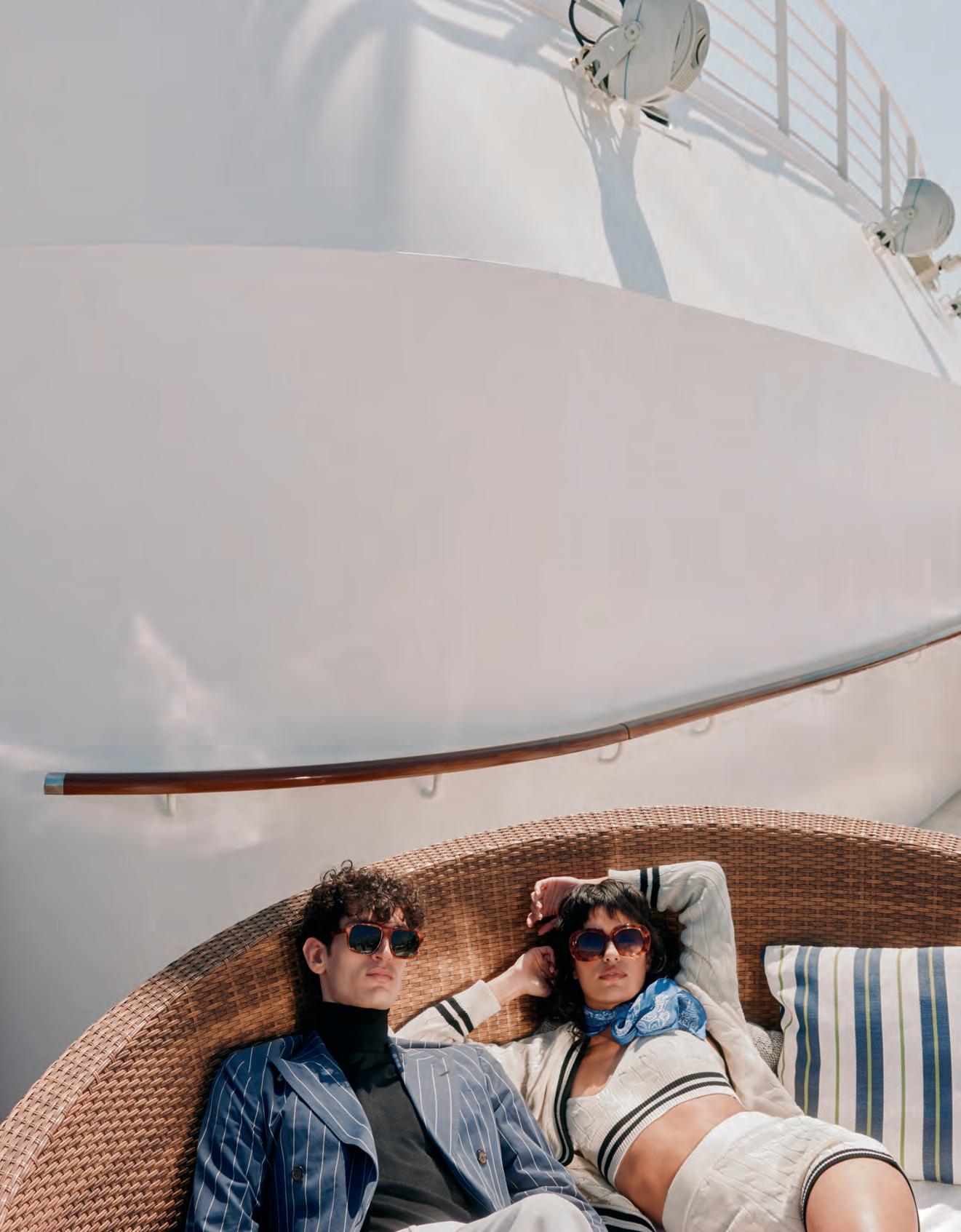
It’s always difficult planning a summer shoot in the UK, especially one involving swimwear. It’s never much fun for the models, or the photographer, or the stylist, or hair and makeup, or their assistants, or the runner (me) splashing around Camber Sands in March. It used to be that you’d fly to Ibiza or the Algarve. But now every item of clothing needs to go through customs. There’s an insane amount of paperwork. And there were a lot of clothes we wanted to shoot.
We’d planned for no sun. Hedged our bets. Recced the ship’s 14 decks for places to shoot when the thunderstorms inevitably rolled in.
Simon Lipman, our esteemed photographer, thought he could make the ship’s grand sweeping staircase work. Sarah Ann Murray, our prized stylist, was sure she could do something in the spa. There was a casino, a nightclub, an observation lounge. We’d be fine. Still, not exactly where you’d choose to photograph this season’s chicest swimwear. A Fendi bikini in a library? Perhaps it would have worked, you never know.
In the end, we got lucky. The sun shone. We hit the terrace of a grand suite (which, inside, looked like the penthouse of a Manhattan hotel). Then the main deck. Then the infinity pool. Shooting in natural light makes post-production a whole lot easier. Something for which Simon must have been thankful, given that we ended up asking him to retouch 20 images (sorry Si, we just couldn’t pick). See the results on page 90. Southampton was great. Splendor® is some ship. But, Regent, if you ever have room for us in Rio, do let us know.
rssc.com


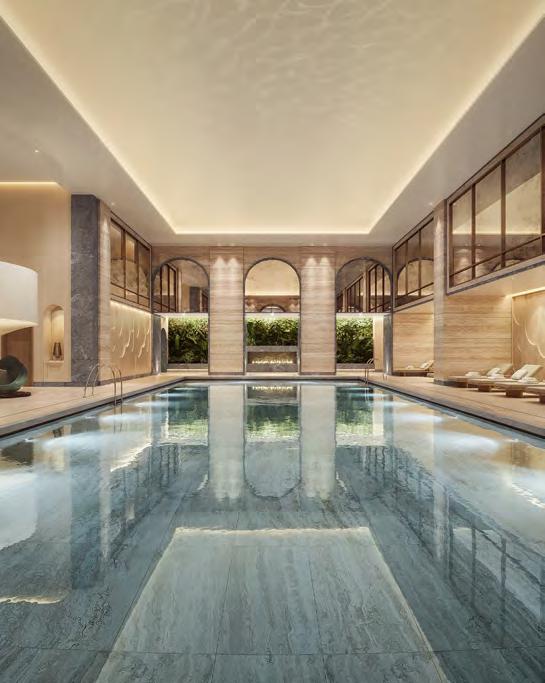

• • • • • • • • •
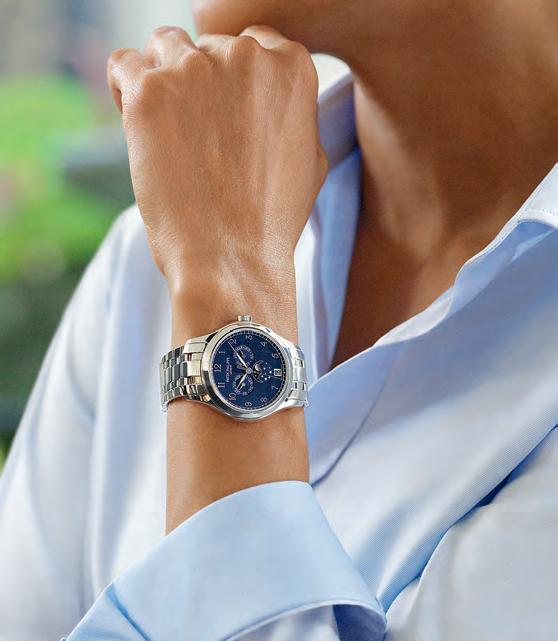






 Amanbagh, Rajasthan, India
Amanbagh, Rajasthan, India





















































































 VEUVE CLICQUOT’S FIRST TRAVELLING INTERNATIONAL EXHIBITION, SOLAIRE CULTURE
VEUVE CLICQUOT’S FIRST TRAVELLING INTERNATIONAL EXHIBITION, SOLAIRE CULTURE



























 Words: Rory FH Smith
Words: Rory FH Smith
























 FRED PRYSQUEL WITH HIS WIFE, FASHION DESIGNER AND BOUTIQUE OWNER, YVETTE
FRED PRYSQUEL WITH HIS WIFE, FASHION DESIGNER AND BOUTIQUE OWNER, YVETTE










 Edited by: Richard Brown
Edited by: Richard Brown




 Edited by: Richard Brown
Edited by: Richard Brown




 HATFIELD SUNGLASSES, £640, Jacques Marie Mage, harrods.com
1402 OLD HAVANA SQUARE SUNGLASSES, £385, Cutler and Gross, cutlerandgross.com
£200, Palm Angels, harrods.com
CARY GRANT SUNGLASSES, £310, Oliver Peoples, oliverpeoples.com
Edited by: Richard Brown
HATFIELD SUNGLASSES, £640, Jacques Marie Mage, harrods.com
1402 OLD HAVANA SQUARE SUNGLASSES, £385, Cutler and Gross, cutlerandgross.com
£200, Palm Angels, harrods.com
CARY GRANT SUNGLASSES, £310, Oliver Peoples, oliverpeoples.com
Edited by: Richard Brown




 L.U.C TIME TRAVELER ONE, £15,200, Chopard, chopard.com
GMT,
TYPE 2 NIGHT BLUE, £41,195, Ressence, ressencewatches.com
BLACK BAY GMT, £3,590, Tudor, tudorwatch.com
L.U.C TIME TRAVELER ONE, £15,200, Chopard, chopard.com
GMT,
TYPE 2 NIGHT BLUE, £41,195, Ressence, ressencewatches.com
BLACK BAY GMT, £3,590, Tudor, tudorwatch.com
 PHOTOGRAPHER SIMON LIPMAN STYLIST SARAH ANN MURRAY
PHOTOGRAPHER SIMON LIPMAN STYLIST SARAH ANN MURRAY
































 Edited by: Anna Solomon
Edited by: Anna Solomon












 Edited by: Anna Solomon
Edited by: Anna Solomon


















 COTTON DRESS, £2,150; BROWN BIKINI SWIMSUIT, £490; COTTON HAT, £470
COTTON DRESS, £2,150; BROWN BIKINI SWIMSUIT, £490; COTTON HAT, £470

 NATURAL STRAW BAGUETTE BAG WITH FF EMBROIDERY, £2,550; PINK SILK DRESS, £2,250
NATURAL STRAW BAGUETTE BAG WITH FF EMBROIDERY, £2,550; PINK SILK DRESS, £2,250









 HOW CARRIER BECAME THE FREE-THINKING TOUR OPERATOR THAT PUTS YOUR WISHES FIRST
HOW CARRIER BECAME THE FREE-THINKING TOUR OPERATOR THAT PUTS YOUR WISHES FIRST








































































































































